

51 Creative Video Project Ideas for Students (With Templates)
- video project ideas

It’s always a challenge to keep students engaged during classes, especially virtual classes. One of the ways to do this are video projects. Video projects not only make for fun viewing, they also supplement learning. While creating videos with fellow students is a fun activity, it’s not always easy to come up with video project ideas.
So here we bring you some of our favorite creative video project ideas for students. We also share ready-to-use free video templates that you can plug into and start using. Stay tuned till the end and find a bonus section for students on how to make a good video project! Let’s dive in!
A. Video project ideas for elementary students B. Video project ideas for high school students C. Video project ideas for higher education students D. How to make a good video project
Bring your video project ideas to life in minutes
With 3000+ ready-to-use project video templates

A. Video project ideas for elementary students
Video projects for elementary students are mostly a way for the teachers to ensure comprehension and interest in the classroom. These can also be a good tool to make students think about different topics. Let’s check out some video project ideas for this age group:
1. Summarise a lesson
Get your students to summarise history or literature lessons on video. Have students research major figures and events in history and make videos around these concepts. This gives students the chance to learn digital storytelling as well as thoroughly research important historical figures! For example, check out this video sharing the history of television!
Use This Template
2. Share a talent video
Have students share a video performing a talent! They can share singing, dancing, painting, art, baking, playing an instrument or various such videos. This can be a fun activity where students learn more about their peers. For example, check out this music artist launch promotion video that can be used by students to promote their own music videos .
3. Create a book report video
Instead of traditional book reports, get students to create book reports or trailers for various literature projects. These can be a good way to get students curious about concepts you will be teaching them too! Check out this video book report.
4. Celebrate a holiday
Get students to create videos on their traditional or religious holidays. This is a great way to cultivate curiosity, awareness and tolerance for different ethnicities and cultures. Check out this Christmas facts video as an example.
Use This template
5. Create science experiment videos
Encourage students to create their own slides to explain science experiments and their findings. This way, students start thinking of STEM disciplines in a more analytical, hands on manner. Check out the lesson plan presentation below that can be used to document the objectives and findings of such an experiment.
B. Video project ideas for high school students
Video projects for high school students can be a little more advanced as they are in the process of growing their skills and learning more about different subjects.
1. Create a video portfolio
High school is when students start thinking about college applications. This is a great time to start making a portfolio. Teachers can give students the chance to create a portfolio video and share their unique skills and interests. For example, students interested in engineering and STEM can share their coding or science related know-how. Check out this copywriter portfolio as an example.
2. Create a news show
Students need to know current events, both for their school community and for the world around them. Having a school news show is a way to communicate with the school community of students, teachers, staff, and parents. This can be a group effort that helps students learn the value of teamwork and allocation. Check out this newsreel video you can customise to create your own weekly news show.
Use This Template
3. Make a video tour of an important location
If students visit a place -- on a field trip, on vacation or any time -- they can share their learning experience with others by recording video of it and narrating as they go. (If they're at a museum or other such places, asking permission first is probably a good idea!) If they can't visit it, creating a video slideshow with InVideo is also an option. Get your students to share video projects on important locations as an assignment. These projects can be themed around festivals , cultural concepts and activities too. For example, check out their Halloween cross country tour slideshow.
4. Share practice records
Learning a language, cooking , music or sports require constant practise. To gauge the progress of each student, you can ask them to record themselves learning to play an instrument or speaking a new language. Students can make video projects of themselves learning or mastering a particular song, key phrases and more. For example, check out this violinist’s progress video.
5. Create an ad or a promotional video for school events
Get students to make an advertisement or a pitch for a school event. This could include a political ad for class president election, a video resume , or an ad for the latest games or tournaments in the school. Students will need to think about the audience they are trying to reach and the length of the advertisement. For example, check out this match poster video.
6. Promote a good cause
Get students to create a video project promoting a cause they believe in. This helps them build their opinions and develop persuasive skills. Students can share this video with everyone, not just the classroom! For example, here’s a video you can customise to debunk myths around a way of life (going vegan in this case).
C. Video project ideas for higher education students
Post high school, it may seem that video projects aren’t that important. But this is the time when students are most focused on improving skills related to their career. Video projects can thus help students showcase their understanding and interest areas, especially to future employers. So let’s check out some video project ideas for these students.
1. Interview interesting people
The people around us and around the world are living history. Their experiences, information, and advice is a treasure trove waiting to be mined. Get your students to interview individuals from their interest areas or in interesting professions. They could be in-person interviews where both parties sit next to each other or they could be virtual interviews, where someone far away records responses to questions. These interviews can act as learning aids, as well as help students connect with people in their future careers. Check out this video interview on how to approach people for their life stories.
Make your own video highlighting interesting interviews by sharing quotes , testimonials, and more. Check out this testimonial video as an example you can use and customise.
2. Teach a concept via videos
Truly understanding something is the ability to teach it to others. Students can make a video where they are recording themselves completing a task on their computer screen or they can make a demonstration video like a coding class. Teachers and professors could then use these videos to help reinforce skills in your class or even flip some of your lessons. For example, check out this video tutorial on note taking apps.
3. Create a self-assessment video
Being able to assess oneself is an extremely important skill that students need to improve themselves. Self assessment empowers students to become better learners. It also allows them to take an active role in their assessment and push for a grade they feel is unfair - a direct correlation to performance reviews at the workplace! Personalise this testimonial video to create your own self assessment video.
4. Create a video presentation for a written assignment
Written assignments are a staple when it comes to college. But only professors and classmates can view these. Instead, creating a short, promotional video on a written assignment is a great way for students to share their work with more people and learn editing skills at the same time. Check out this digital marketing trends video you can use to create your own video presentations .
5. Create a video resume
For most students, the job hunt begins in college itself. A video resume helps highlight key skills as well as share the student’s personality and attitude with employers. Especially when applying to remote or distant positions, a video resume along with a normal resume provides brownie points. Check out this video resume you can use as a blueprint to create your own.
Leverage the power of video to land your dream job!
Create a PRO video resume in minutes with InVideo

6. Create a University promotion video
Universities and colleges need as much promotion as they can get. And who better than students to share their experiences and highlights. Get students to create unique videos with their best anecdotes or areas in the university. This is also a good way to get them to research interesting aspects of college life. Check out the University promotional video and make it your own.
D. BONUS: How To Make A Good Video Project
Your school video project can earn you good grades. It is also an opportunity to showcase your creativity. But how to create the perfect video without any error? Video creation may not be your forte, but you still wish to excel in school video projects, right? No worries!
If you have a school video assignment in hand but don’t know where to begin, read below to learn how to create a video project super easy and quick, without any error and fuss. Now, let’s divide your video project into 5 easy steps.
Step 1: Video topic or idea
If you are working on a school assignment, you probably have a video topic given by your teacher or professor. If you are looking for video topic ideas though, find them here .
Step 2: Plan your video assignment
Planning is super important for your videos. This is when you decide how you want to create your video. Consider whether you want to live record your video or create it online using an app or a tool. An online tool like InVideo offers you pre-created templates that might meet your requirements. This is also a super quick and easy way to make your video from scratch. The first thing you need to do is go to InVideo and login or sign up if you wish to use this tool. Next click on the “Pre Made Templates” Option and select the video dimension you want. Finally, type phrases related to your video in the search bar.

You will now see templates related to your search as you scroll below. Simply select the template you want to use and click on the “Use This Template” button to start editing!

If your video idea is to record an event , but you don’t have a DSLR, camcorder or GoPro, use your own smartphone camera for the school project.
Step 3: Prepare a video script
Now that you know how you will record your video, the next step is creating a script for your video. Here’s a step-by-step guide on script writing you can refer to.
3 questions to ask yourself before you create your script:
- What is the objective of your video? - How long does your video need to be? - Who is the audience that will watch your video?
Step 4: Shoot your video + audio
Once your script is finalized, it’s time to shoot your video. You also need to make sure that you are recording audio to go with your video. Check out this list of equipment and how you can use it to record video and audio.
Step 5: Edit your video
As mentioned earlier, one of the most effortless ways you can edit your video is using the free, online InVideo editor . This is simple, easy to use, and does not need you to make any downloads. Here’s how you can edit your video on InVideo.
Step 1: Log in to InVideo . Now click on the “Blank Canvas” option and select the dimension of your video. Next, click the “Make A Video” button.

Step 2: Now click on the “Upload Media” button at the left-hand corner of your screen and upload the video you shot.

Step 3: Double click your uploaded video to add it to the timeline. You will now see a pop-up that asks if you wish to trim your video. You can Trim your video or use the full version. Simply click on the “Done” button once you are finished with your trim.
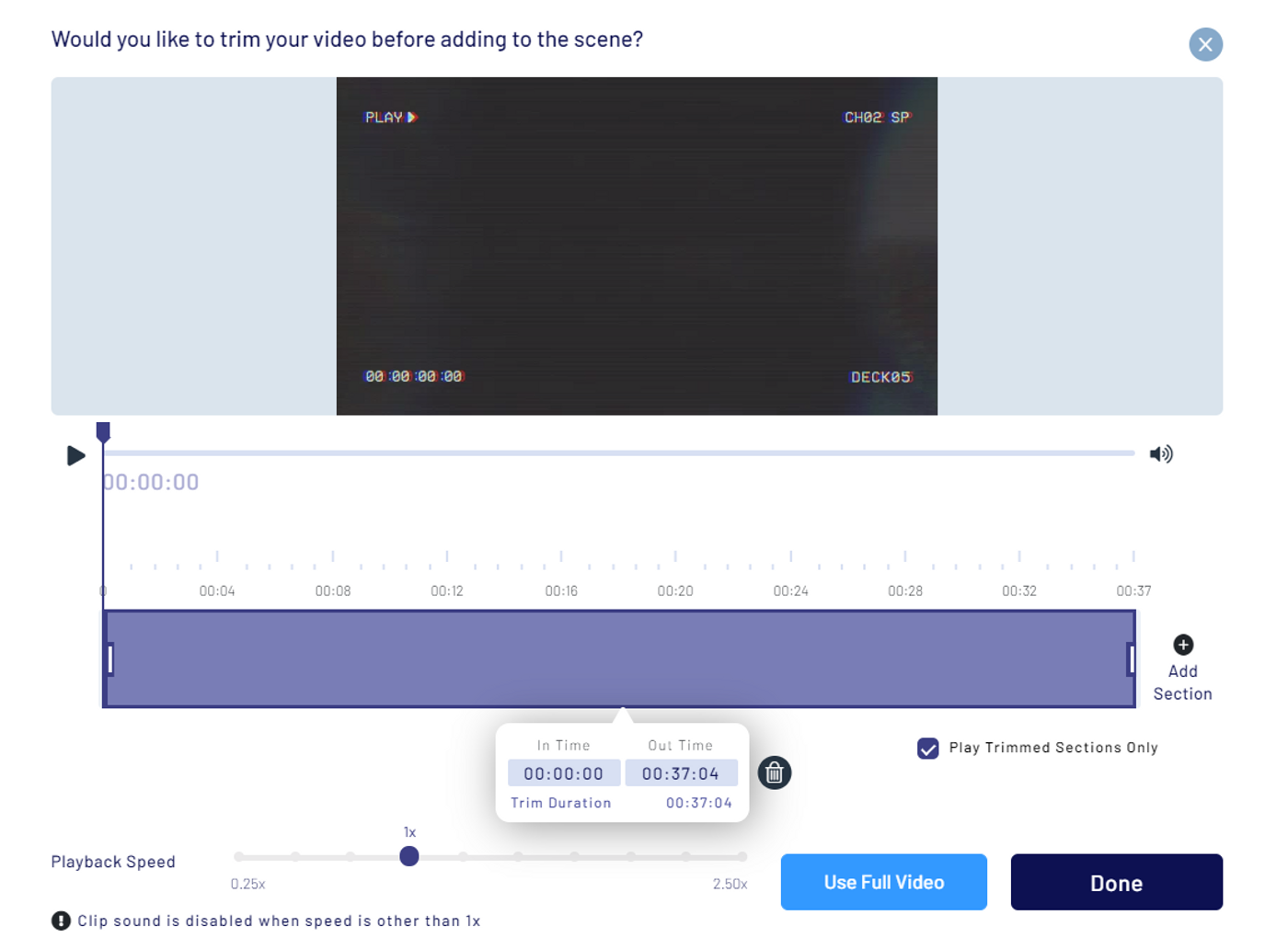
Step 4: You can now use the controls on the right side of the screen to edit your video further.
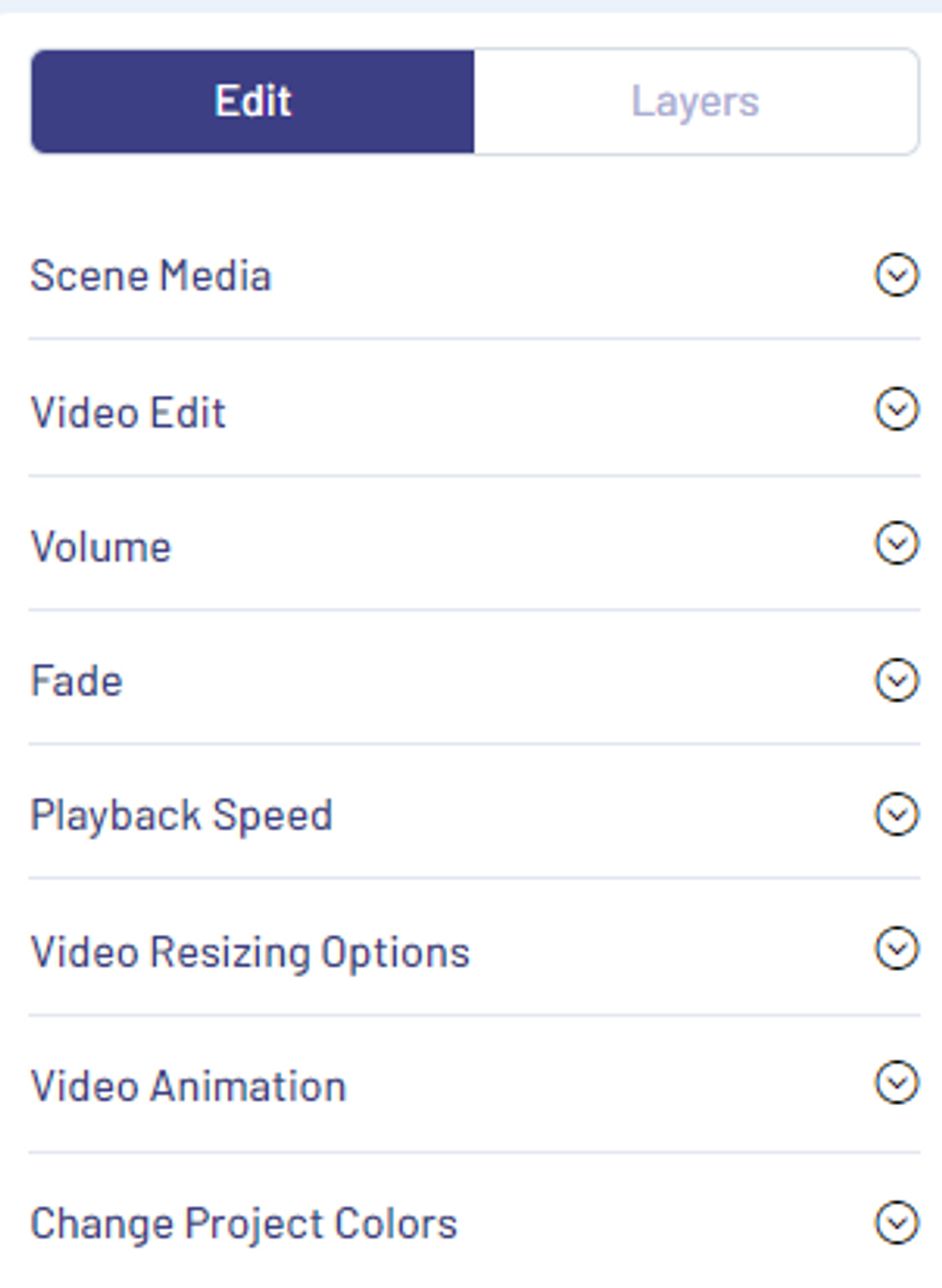
Step 5: You can apply filters, create transitions between shots for a seamless flow, add subtitles, or insert a logo to give a personal touch to your school video. Just head to the left side of your screen and select the controls you wish to use.

Step 6: Once you are done with your edits, it’s time to download your video. For this click on the “Download & Share” button on the top right. Now click the “Export” video button.

Step 7: Your video will now start to render. You can download it once it’s complete. You can also directly share the video link or share it on social media using the button provided.

Wrapping up
So these were some video project ideas for students and how you can create your own videos on InVideo. If you’ve found value in this article, and are looking for more video ideas, you also want to check out this guide where we’ve put together 200+ video ideas for businesses and brands that you can take further inspiration from.
For more quick tips and hacks on editing and creating videos, subscribe to our YouTube Channel .
This post was written by Upasna and edited by Abhilash from Team InVideo
Let’s create superb videos
Ready to get started?
- Education , Inspiration
15 creative video project ideas for students (and their teachers)

Fall is here. The leaves are starting to change color and teachers everywhere are asking the same question: How do I come up with video project ideas for my students?
Video has been a staple learning tool for decades. But having students create, design, and edit video projects themselves is becoming a much more common classroom activity. Video projects are a great way to help students of all ages actively engage with subject matter and learn from one another.
Online apps like Biteable make it easy for students to turn video ideas for school into a reality. Templates and easy-to-use editing tools keep the process simple and offer plenty of inspiration for student video projects.
To help teachers and students alike leverage video as an educational tool , we’ve gathered our favorite creative video project ideas for students. Each idea comes with a ready-to-edit video template so you and your students can get started right away.
Create videos that drive action
Activate your audience with impactful, on-brand videos. Create them simply and collaboratively with Biteable.
Elementary student video project ideas
It can be tricky to keep young students interested and engaged all day long. Creating videos gives elementary students a fun, creative way to learn about anything. And student-created videos are an amazing classroom learning supplement. If a video is produced by their peers, interest will skyrocket.
1. Create a book trailer
Instead of a traditional book report, have students design a movie-style trailer that drums up excitement about a novel or a non-fiction book. Creating a book trailer gives students the opportunity to think creatively, share a story with their classmates, and reinforce their learning in a new way.
2. Give a video tour
To supplement social studies curriculum, students can create a video showing off a significant location or their favorite part of the school. If you have a field trip planned, ask students to share their experience by recording videos throughout the day and adding voice over narration.
A video tour of the school is also a great way to share the campus with new students and visitors. As a way to pass the torch before they leave for middle school, how about asking your fifth graders to collaborate on an orientation video for incoming kindergarteners?
3. Celebrate the holidays
There’s always something to celebrate, no matter what time of year it is. Have students film letters to Santa, make video Valentines for parents or grandparents, or make short educational videos about lesser known holidays. Students can even create simple, digital thank-you notes for classroom visitors or parent volunteers.
4. Recreate a moment in history
Learning about historical people and events? Have your students research and recreate major moments in history, like the story of Rosa Parks or the Oregon Trail.
Videos help students visualize and remember these important moments. It also gives students the opportunity to experiment with digital storytelling. And students will be challenged to bring each scene to life accurately.
5. Try stop-motion video
Video learning isn’t limited to literary or historical topics. Encourage students to use stop-motion or create their own slides to explain science experiments or other STEM projects. With the right footage, like Biteable’s extensive collection of clay animation footage, students won’t even need to build stop motion models. They can just focus on the presentation and storytelling in their video.
Video project ideas for middle and high school students
Video projects for high schoolers can be a little more advanced, as students should be practicing editing and narrative skills in addition to learning about new topics.
6. Create a news channel
To supplement learning in a current events class, have your students film a news broadcast covering both local and international events.
Ask students to take on certain roles in the newsroom: anchor, sports reporter, weather reporter, or entertainment correspondent. Doing a news segment helps everyone get involved and promotes teamwork.
7. Start a portfolio
Many high school students are thinking about college applications. Give them the chance to jumpstart their applications with a portfolio video project and showcase what makes them unique.
Art students can show off their best work and design skills. Students applying to traditional schools can answer an application question or create a video showcasing their community service and extracurriculars.
8. Promote a good cause
Rather than writing a traditional essay or report, have students create a video advocating for a cause that’s important to them. This helps students build their identity and develop persuasive skills. And students can share their promotional video with everyone, not just their teacher and classmates.
9. Questions for your future self
Think ahead with a video full of inspiring questions. This project is great for incoming freshmen. At the beginning of the year, have students create videos with questions for their future self or with goals for their life and career. At graduation, send the videos back to them. It’s a fun, positive way to celebrate their success throughout high school.
Higher ed video project ideas
Higher education might not seem like the place for student-made videos. But in the real world, businesses use video for all sorts of things. Video projects build plenty of resume-worthy skills that college students can take with them to the workforce.
10. Create a university promotion video
It’s easy to forget that colleges and universities are businesses, too. And they need help with promotion. A solid college or university promotion video could open opportunities for internships or college employment. Promoting something that they’re already familiar with is a great way for students to build video persuasion skills.
11. Record and edit interviews
Being able to conduct a good interview and edit it in a way that’s appropriate for the purpose of the interview is a valuable skill in multiple industries. And interviewing experts in the field is appropriate for just about any class.
12. Make a video self-assessment
Grades are important. But being able to self-assess is also an incredibly valuable way for students to incrementally improve at any skill.
Making video self-assessments gives students a more active role in the grading process and offers them a creative way to highlight the work they’ve put into a course. It also gives them a chance to make an argument for the grade they feel they deserve — a skill that easily correlates to performance reviews in their future workplace.
13. Film a job interview guide
For most people, the interview is the most nerve-wracking part of getting a job. Practicing interview questions is a great way to prepare. But most students don’t know how to prepare for a job interview.
Creating a job interview how-to guide is a perfect way for students to learn how to prepare for a job interview and help other students prepare at the same time.
14. Create a video presentation based on a written assignment
Written assignments are the backbone of a university education (in most disciplines, at least). However, the audience for most written assignments is limited to the professor and assistants. Creating presentation videos for their assignments gives students the opportunity to share their hard work with their fellow students, while also learning valuable video editing skills.
15. Build a video resume
For most students, the job search starts even before graduation. A video resume helps students highlight the skills they acquired and the experience they gained during college. And, given the global workforce, a video resume is a great supplement to a paper resume, especially when applying for remote or distant positions where an in-person interview may not be an option.
Take your video project from idea to reality with Biteable
Ready to get started making an education video project ?
Biteable has a huge library of video templates that help students get going fast rather than struggling to start from a blank screen. Drag-and-drop editing and easy to use tools let students focus on what’s important: the project assignment and delivering a thoughtful message.
Make stunning videos with ease.
Take the struggle out of team communication.
Try Biteable now.
- No credit card required
- No complicated design decisions
- No experience necessary
- View all teaching vacancies
- View all locations
- Barking & Dagenham
- View all subjects
- Business studies & Economics
- Sociology & Psychology
- View all job types
- Primary school
- Secondary school
- View our variety of SEND roles
Online Portal
If you are registered to work with us already, you can log in here
Register to work with us
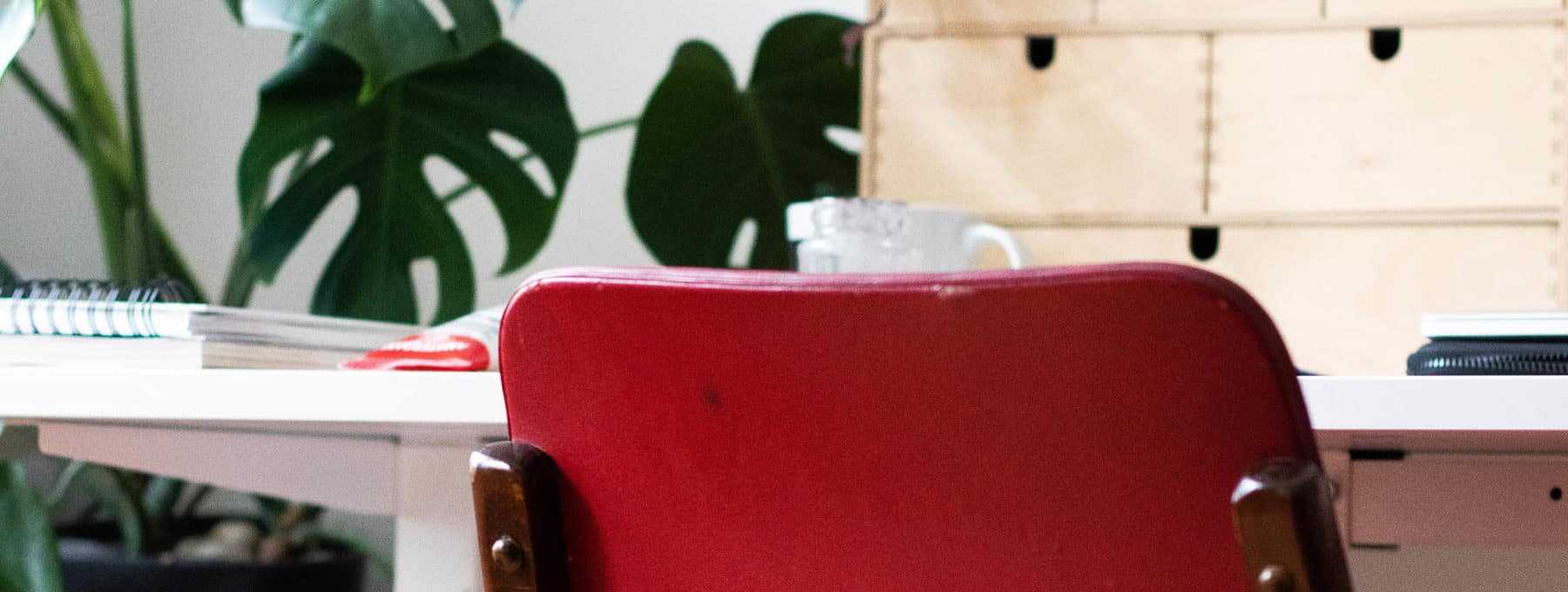
Your Career• 3 Min read
6th September 2020
Creative Homework Ideas
How can you create homework assignments that build on the day’s lessons and encourage creative, student-led learning? It’s a challenge for most teachers, especially as motivating pupils to complete homework can add a whole extra layer to your lesson plans. But it’s essential to bridge the gap between teacher and student learning – the skills gained through independent study reinforces knowledge from your class, as well as a host of other benefits:
- Extended learning time – outside of the constraints of the school day, students are free to learn at their own pace and in their own environment.
- Independent learning – vital skills for exam preparation and higher education
- Teaches students to be resourceful and to overcome challenges independently.
- Gives students the freedom to be creative in their learning, gain valuable problem-solving skills and confidence in their own abilities.
Tips For Setting Creative Homework
- Plan independent learning both in and out of the classroom – you can monitor students effectiveness and address issues that may arise in the classroom before they become problematic for pupils at home.
- Don’t leave homework assignment to the end of the lesson, rushing through the task might leave some students confused which inevitably leads to a lower homework completion rate. Write plenty of time for explaining homework assignments into your lesson planning – read our Beginner’s Guide To Lesson Planning here
- Homework should to not too easy nor not too hard, offering pupils a challenge that reinforced the topics learnt during the day
- Give room for creative expression – allowing students to add their own diagrams, decorations or chose their own project topics from a selection.
- Try using peer or self-assessment to mark homework – a double whammy of reducing your workload and allowing pupils to take control of their own learning.
- Include timings and explicit steps for completing more complicated assignments, especially for pupils that you anticipate might struggle. Comprehension of the task is the biggest hurdle in getting pupils to work on an independent basis.
- Self-driven projects, posters, creative tasks and research are more exciting than standard comprehension tasks and might encourage pupils that find sitting and writing dull or hard to complete the homework set – give students the freedom to learn and be creative in their home study.
- Provide specific instructions and internet safety reminders for research-led assignments. It’s very easy for children to find research overwhelming with a vast amount of information available online. Provide suggested websites and links in your homework to keep things on track!
- Don’t introduce a new topic for homework – keep it to topics that you’ve already covered in class
- Taking note of the subjects that excite and engage your class and set homework accordingly – try keeping dryer topics and for the classroom so that you can monitor engagement
- Mark work promptly – essential to keep students motivated to complete work in their own time!
- Offering students the opportunity to select the homework that they would like to do from a selection guarantees a higher rate of completion. We’ve seen some teachers create grids or sheets of homework assignments for the pupils to select, or offer baskets of activities for younger children to take home and complete with an adult.
Creative Homework Ideas For All Ages
Coming up with innovative ways for students to reinforce their knowledge at home can be difficult – many of these ideas would be suitable for lots of subjects with a little tweaking!
Book a CCS Consultation
Our East Anglia team are on hand to support your school or MAT with bespoke recruitment solutions, arrange a consultation with the team today.
Recommended for you
6 tips to prepare for the new school year.
The beginning of a school year can be daunting, with students being...
- Your Career
Classroom Essentials – Everything A Teacher Needs Day To Day
As the term nears, now is the perfect time to prepare for...
What does being a Teaching Assistant involve?
Being a Teaching Assistant is rewarding but it is also hard work....
You're now visiting Engage Education, United Kingdom
Take a look at some of the fantastic opportunities we’re currently recruiting for in the UK.
Privacy Overview
- Grades 6-12
- School Leaders
Win a $500 Oriental Trading Gift Card ✨
25 Creative Video Project Ideas Your Students Will Love
Tell a story, make a newscast, create a vlog, and more!

It’s never been easier for students to create fun and engaging videos to show off their knowledge! We’ve rounded up 25 video project ideas for your students to try. You’re going to love the results!
General Video Projects
Language arts video projects, stem and social studies video projects, school community video projects.
Use these video project ideas for any subject or grade. They’re easy to personalize and a lot more fun than writing a paper every time.
Student Portfolio
Student portfolios offer a chance to document learning and growth throughout the school year. Use the easy template to help kids create and customize their own video portfolios in a snap.
Student Vlog
Keeping a journal offers students a way to record and reflect on their thoughts and experiences. An online version is called a blog, while a video version is known as a vlog. Encourage students to record new videos on a regular basis as they document their experiences throughout the school year.
Here’s another fun video option that works for so many subjects. Students can create a broadcast for a historical event, to document the events in a book, or to report on a scientific discovery. Or have kids make up their own news stories for a creative twist.
Learning Reflections
True understanding means taking time to reflect on what they’re learning. Instead of just reciting dates, ask kids to reflect on how historical events make them feel, or relate history to current events going on around them now. Don’t just read a book—go deeper to make emotional connections. Videos allow students to talk through their reflections, something that’s easier for many kids than writing.
Scavenger Hunt
This is such a fun way to learn to use video-editing programs! Students complete the actions on a checklist, like showcasing their bedroom, introducing their pet, or fixing their favorite snack. Then, they use video editing to add a little flash before sharing it with the class. Find the checklist here.
Research Project
Instead of writing a paper, ask students to make a video of their research project. This way, they can share not only what they learned but how they learned it. Easily incorporate media, interviews, music, and more, and then share their projects in an online portfolio for everyone to see.
Give new life to book reports, write and film stories, create a commercial, and more with these language arts video project ideas!
Book Report
Forget ordinary reports— this template will help kids make engaging videos that show off their knowledge instead!
Creative Commercial
Crafting their own commercial is a really terrific way for students to practice persuasive writing. They can choose an existing product or start by inventing a brand-new “must-have” item for their project.
Book Review
This is another clever spin on ordinary book reports, presented in the form of a book review. Have each student choose a book to read and review. Remember, it’s OK if they don’t wind up liking the book! The important thing is to read, summarize, and then share their thoughts in a video.
Vocab Station
Make short videos to help others learn new vocab terms, in English or in foreign languages. It’s much easier to remember that la naranja means “orange” when you see someone peeling a piece of fruit as they speak it for you. And it can be a lot of fun coming up with creative ways to demonstrate tricky words like “ephemeral” or “procrastinate.”
Read-alouds are fun for little kids to watch, but they’re even more fun for older students to create! Have students choose a beloved picture book, then use this template to create a read-aloud video. ( Check out some of our favorites for inspiration. )
How-To Video
Giving clear and concise instructions is a key life skill, but it takes some practice. Ask students to make instructional videos on any topic they like, being sure to include enough detail that someone watching would be able to copy their method and receive similar results. It’s harder than they think!
Green Screen Story
Green screen effects allow students to put themselves into any background they like. Once they’ve mastered the green screen, challenge them to use it to film a story or play they’ve written. It’s creative writing brought to life!
Evoking Emotion
Sounds, photos, and music are all capable of evoking emotion, though not everyone reacts the same in all cases. Assign students an emotion, then ask them to use various forms of media to try to evoke that emotion in the viewer. Encourage them to focus on image and sound rather than words.
Show off their love of science, technology, engineering, and math with these clever video ideas for all ages!
Scientific Method
Understanding and putting the scientific method into practice is a key part of hands-on science activities. Have kids record a video to sum up their project, demonstrating each step of the method along the way.
Real-Life Math
Kids love to ask, “But when are we gonna use this in real life?” In this video exploration, they’ll find out. Students come up with a real-world math situation, then show it in practice. You can use this concept with all sorts of math topics. Think money and decimals, figuring area, calculating taxes, and so much more.
Stop-Motion Science
Use stop-motion videos to explain scientific processes, with simple animations recorded one frame at a time. This technique can add a cool touch to science project videos.
Show Your Work
Encourage your students to make their thinking visible by screencasting as they work their way through a math or science problem. Watching other kids work through a process can help all students better understand the topic.
Virtual Field Trip
Travel the world without leaving home by creating a virtual field trip video using Google Earth. Insert photos, street views, music, and more to make a geography lesson into a real adventure.
A Day in the Life
Turn a history report into a personalized experience by asking kids to film “A Day in the Life” of their subject. It could be an Egyptian pharaoh, Napoleon Bonaparte, or Aztecs living in Mexico before the Europeans arrived. This is one of those video project ideas that works for any place and time.
Use these ideas to get the word out about exciting happenings, on campus and off!
Morning Announcements
Morning announcements have come a long way since the days of scratchy PA snippets full of feedback. It’s easy to put together beautiful and engaging video announcements using this template instead.
Getting To Know You
Introduce a new teacher, celebrate a student of the month, or learn more about school support staff by making a Q&A video. This template provides examples of questions to ask, making the interview process easy and fun.
Event Promo
Build excitement for the upcoming talent show, fundraiser, or pep rally with an event promo. These are perfect for sharing on social media for the whole community to see! Get the template here.
Public Service Announcement
Tackle important topics like recycling, safety, health, and more by making PSAs. Students are more likely to listen to their peers than to yet another adult “telling them what to do.” Create a list of possible topics, or ask them to brainstorm issues that are important school-wide.
Morning Meeting
Lots of schools have replaced homeroom with morning meetings. Asking kids to lead these meetings can provide valuable learning opportunities, but it’s really hard for some students to speak up in front of others. Let them lead a morning meeting via video instead, using this simple template .
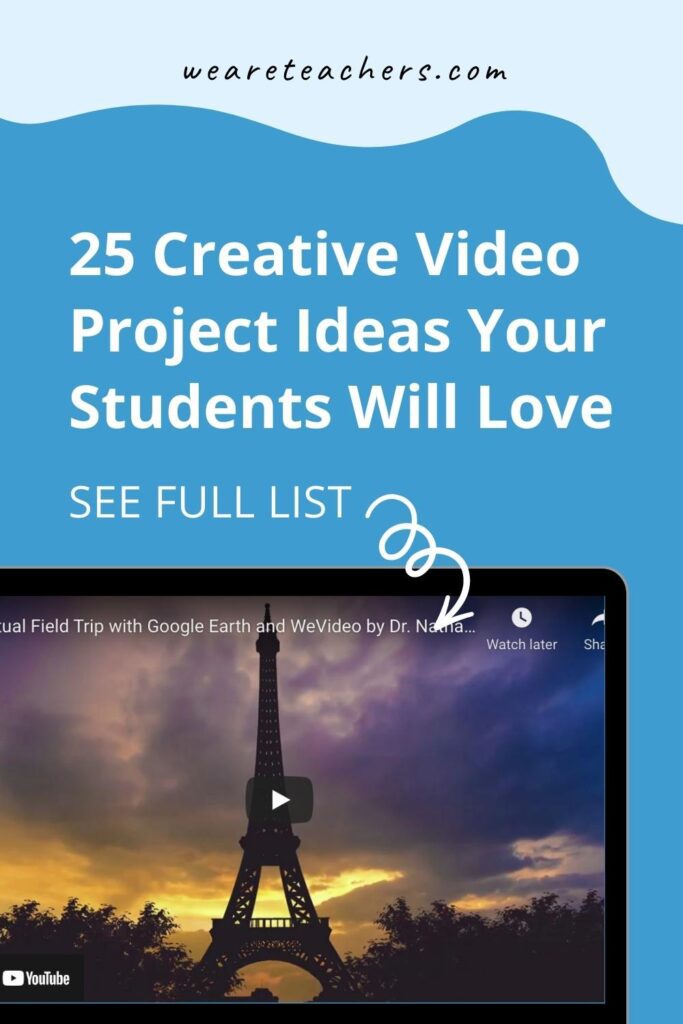
You Might Also Like

What Is a Makerspace?
What is a makerspace? We're glad you asked. Continue Reading
Copyright © 2024. All rights reserved. 5335 Gate Parkway, Jacksonville, FL 32256
- BookWidgets Teacher Blog

20+ creative alternative homework ideas for teachers

When giving homework, it must always be based on learning goals your students have to reach, just like in your lessons. But it’s sad to see that lots of teachers are using homework as extra lesson time. Of course, as a teacher, you’re on a clock. But that doesn’t mean your students have to suffer from it and keep working on those boring textbooks and worksheets at home.
Consider goals like attitudes, real-life experiences, and practice, physical exercise, social encounters, creative solutions, and philanthropy as crucial as your lesson goals. These are things students don’t just pick up in your classroom. These are things they pick up in life.
In this blog post, I’ll give you some innovative homework ideas that will engage your students more. These alternatives to traditional homework will thereby also teach your students new things that can’t be taught in the classroom. You will find a variety of homework ideas: online and offline.
I will mention homework alternatives for primary school and high school. Some of these ideas can be changed a little bit, so they are the perfect fit for the right audience.
20 Creative homework ideas
You can divide homework tasks into the following themes or categories:
- Crafts & arts
- Outdoor activities & outings
- Games and activities
- Physical activities
- Digital or computer activities
- Philanthropy & social work
💡 Good to know : all the ready-to-use homework activities are created with BookWidgets . You can easily create activities like these yourself or duplicate an activity below for free, edit it if needed, and share it with your students. You can do so in the examples separately, or you can find all the homework examples in the BookWidgets Blog group folder .
Crafts and arts homework
1. prepare a dish from a recipe book.

2. Make a board game

3. Create a birdhouse

4. Transform a fictional book character into a hand puppet

Outdoor homework activities and outings
5. coupon game.

Students can also go grocery shopping with their parents. Here, they have to read the ingredients of the products and help their parents choose the healthiest products for the best prices, figure out the best deal between the sizes of items, …
6. Visit the zoo

7. Visit the local dumping ground or container park

8. Build a tree house

Games and activities as homework
9. bookwidgets games.

10. Minecraft

11. Play Cards

12. Play Zoo Tycoon or Rollercoaster Tycoon

Physical homework activities
13. rope skipping.

Many rope-skipping songs let your students do different tricks while rope-skipping. This is an excellent opportunity for homework as well. Ask your students to transform a rope skipping song into a song with lesson content. Let them count or spell or even sum up the different states or capitals. To engage their lifestyles even harder, you can additionally give them the assignment to create a TikTok in which they are jumping and singing.
Click here to see how you can get Tiktok more involved in the classroom.
14. Walking quest

If there aren’t any walking quests in the neighborhood, you could ask your students to create a walking quest like this for their fellow students. What a fun day it will be!
15. Obstacle Quiz

In order for students to answer the questions, they have to run and pass a challenging parkour. This is a fun homework exercise, and in the end, it’s a great lesson starter or lesson end.
16. Swimming games

After the activity, they can fill out an Exit Slip:
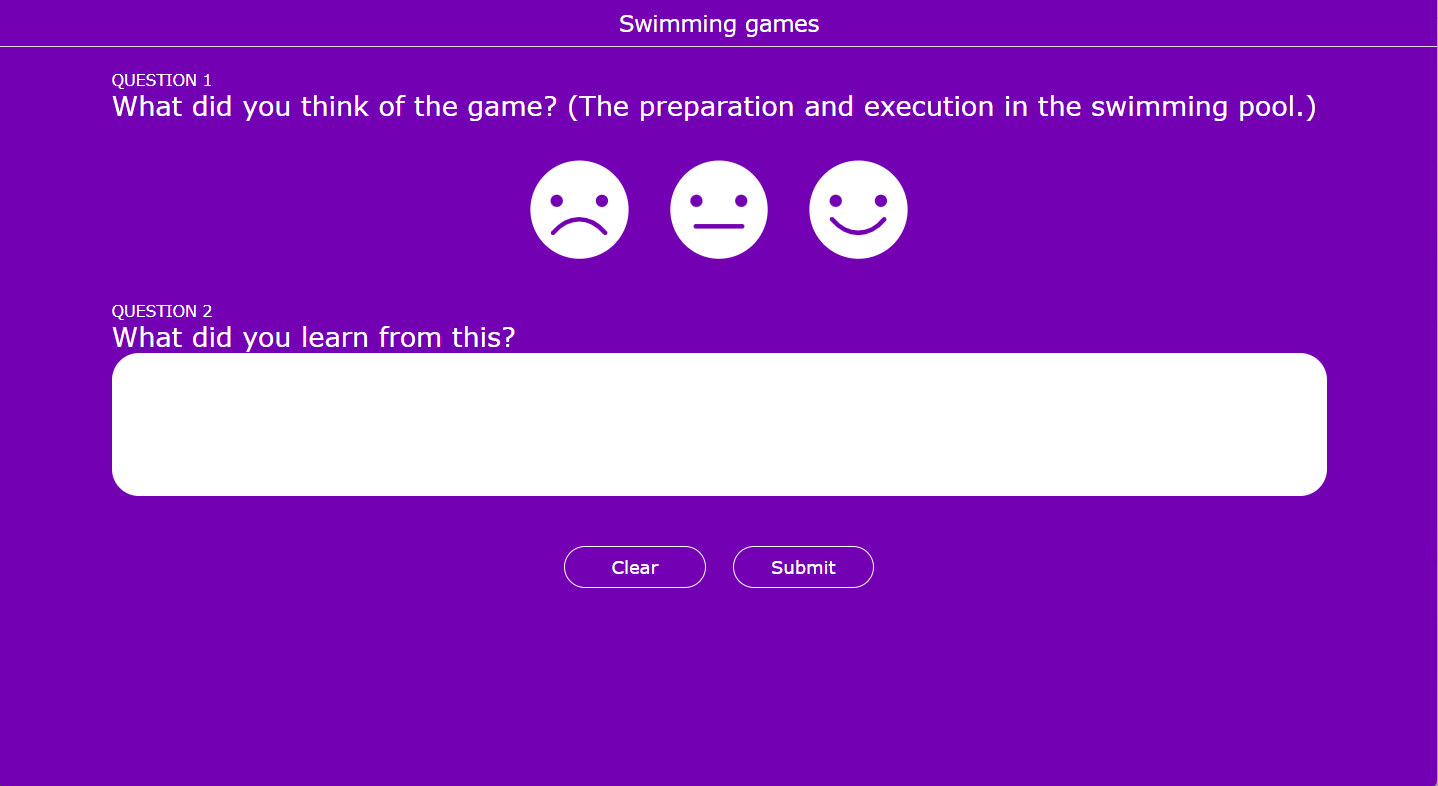
Digital or computer homework activities
17. create a picture album.

This teaches them to handle the online software, add pictures and write without spelling mistakes. And of course, creating memories is so much fun!
18. Video job application

19. Your life in 10 minutes - video

20. Email pen-pals

Is it still too complicated? Read the messages from your students, before they send them, and provide them with some feedback.
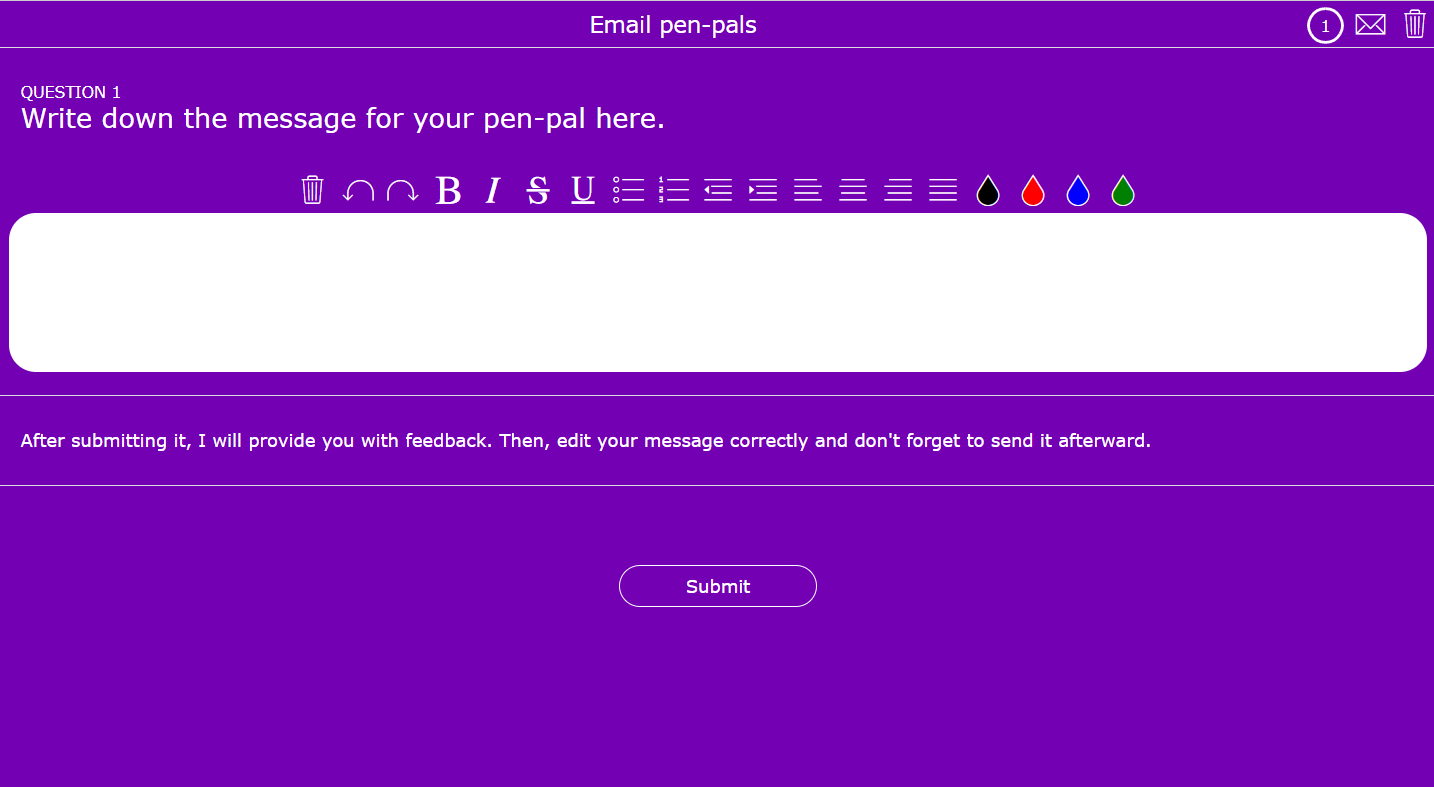
Philanthropy and social homework
21. grow a community garden.

22. Help in a retirement home

23. Help at a homeless shelter

24. Collect litter

Here’s another homework tip: Don’t call homework “homework”. Call it a challenge. Homework has become a negative word for students, and I bet they start rolling their eyes as you even mention the word.
Still looking for more inspiration? Check out the blog on short films and lesson activities that spice up your Google Classroom . Tip: even if you don’t use Google Classroom, there is a lot of inspiration back here.
Above you have read single assignments. But, you also have the option to involve your homework in a project. Find out more here .
So, as I mentioned earlier, there are many fun alternatives to traditional homework. Now it’s up to you to apply this in the classroom as well. In this folder , you will find all the examples you have come across.
Which idea do you or perhaps your students like the most? Let us know on Twitter . Of course, there are many more alternatives. If you have other ideas, you are always welcome to share it with other teachers in our Facebook group .
One more thing: don’t forget to say hi👋 on LikedIn .

Join hundreds of thousands of subscribers, and get the best content on technology in education.
BookWidgets enables teachers to create fun and interactive lessons for tablets, smartphones, and computers.

.
.
.

Ten Engaging Video Assignments to Get Your Students Talking

- Post to Facebook
- Share on LinkedIn
- Send via Email
In the classroom, video means instant engagement, and making video is an increasingly important skill for youngsters to develop. We’ve put together ten exciting assignment ideas that will help elementary and middle school teachers get their students making great video! Parents, feel free to steal these ideas for rainy weekends, too.
Make Video Really Easy For All Students
Not all students will be able to access their own camera equipment. This could be due to their families’ budgets, their age, parental permissions, or some may be a little too shy to be on camera.
Remove obstacles by creating groups to work on each project, and consider setting up a couple different “studios” in the classroom. Then, come up with fun and quiet assignments that groups not actively filming can tackle, like script writing or prop-making, while others get their turn in front of the camera.
An in-class studio could be as simple as a backdrop with a tripod, or more complex depending on your school’s resources and the space you have to work with. If you are able to setup a couple different studios, more than one group could be creating videos at the same time, and, no one will be left out if they can’t get the right equipment.
Basic video equipment is really inexpensive in this day and age, especially for this type of kid-friendly production. A low-cost video camcorder from Amazon would likely suffice, and simple tripods are usually under $50. If you aren’t in a position to purchase equipment, you can always use a smartphone or tablet with a mini-tripod or similar stand, or a laptop with a built-in camera.
Editing the final video together might not be required for all of these project ideas, but it makes sense to check on the availability of video editing programs on school computers to see if it might be possible. iMovie or Windows Movie Maker are both free and easy to use. That way, any particularly inspired students can take their project to the next level if they’d like.
Video Assignments for Elementary School Students
1. task: make a short video reviewing your favorite book..
Objective: Students should record themselves giving a synopsis of the book and sharing what they enjoy about it. Using age-appropriate props, younger children can shoot a scene from the book; older children can direct a scene featuring their friends.
In addition to putting thoughts together coherently, and learning how to write for film (for older students), this task will enable children to be comfortable in front of and behind the camera, and encourage collaborative group work.
2. Task: Make a commercial.
Objective: Take an everyday object – an apple, pen, table, lunchbox – and ask students to make a commercial trying to sell it. They should put together a script, create a jingle, and design a brand logo as well as filming the advert.
Depending on the age of your students, they could work together. Ask each member of the group to take responsibility for a different element of the video. This is an effective task at showing students the power of persuasive writing, and how to work effectively in a team, as well as the objective behind advertising.
3. Task: Create a video tour of the school for new students.
Objective: Pupils can share their school experience with new students by recording and narrating it. They should interview teachers and other students, as well as showing their classmates using the school’s facilities (outdoor play area, pool, computer room). In addition to learning filming and editing skills, this task enables students to hone interviewing and communication skills.
4. Task: Exchange video messages with other schools.
Objective: Students from a partnering elementary school exchange short videos with your class that explain what life is like at their school, or another agreed-upon topic. The idea would be to generate interest in another culture, or to introduce students from a far-flung part of the USA. Not only would this type of exchange expand their horizons, but it would help develop their story-telling abilities, too.
5. Task: Explain how to make your favorite food.
Objective: Have students make a short video about their favorite food, or a special family recipe. Use creativity for those who aren’t able to do any filming at home. For instance, have them bring in some of their favorite food to share, or use animated pictures instead of actual footage.
As an alternative, assign students to different meal groups, like breakfast, lunch, and dinner. Then, have them work on the assignment in teams. This assignment will help students get to know and appreciate other food cultures, while also having a really fun time.
Video Assignments for Middle School Students
6. task: create vocabulary vines..
Objective: Show a word on paper (perhaps a student could be filmed writing it), then record a visual representation of the term. Each short video should be shared with the whole class so students can easily access them. This is also a great exercise for foreign language classes.
Although Vine may no longer exist as a platform, short videos are still a great way to promote learning.
7. Task: Make a two-minute video assignment about your hobby.
Objective: The student will learn to operate a video camera (or the video function on their smartphone or tablet), grab copyright free clips from the web, and edit footage.
Part of the challenge will be to adhere to the two-minute time limit. Older students can be taught how to use industry-standard editing software. Whatever level they are at, students will respond positively to being given free rein to get creative and produce original content about a topic that interests them.
8. Task: Create a video dialogue with a famous historical character.
Objective: Using the split screen effect, the student should record themselves in conversation with someone the class has been studying in history. They will enjoy dressing up and getting into character for this task!
This video assignment challenges the student to demonstrate a deep understanding of the psyche and motivations of an historical personage. Note: this assignment also works well as a conversation between the student and a character from the book the class are studying.
9. Task: Film your science lab project.
Objective: Film a project from start to end, hypothesis to conclusion. Students should show footage of the experiment being set up, carried out, and concluded. They should add a voiceover explaining what’s happening and why in each shot.
This assignment is two-fold. In addition to demonstrating their understanding of the relevant scientific principles, students will hone their filming and editing skills.
10. Task: Give your own TED Talk.
Objective: Show students an age-appropriate TED Talk that’s relevant to a topic they’re studying in your class. They should use it as a basis to put together their own presentation on that subject area. Encourage them to use visual aids and to adapt an engaging mode of presenting, just like the TED speakers. A cameo from friends, family members, or even pets makes for a great video!
For demonstrating to students that a ‘talk’ is more than just talking, we recommend showing them the following TED videos: The Shared Experience of Absurdity, The New Bionics that Let Us Run, Climb and Dance, and Einstein the Parrot.
Secure Sharing
For sharing the video, it’s important to be sensitive to the privacy of the children participating. Consider sharing the video with a password or with login protection to make sure only the participants, or their parents, can view it.
Make sure you can track viewers at a very granular level. For instance, video engagement metrics enable you to check that only approved viewers are accessing your content.
If you need a website for sharing your students’ videos, we even have that covered. Each SproutVideo account comes with a customizable video website that you can configure to your specifications.
With SproutVideo, you’ll get the best live and on-demand video hosting platform for business. Start your free 30-day trial today and get unlimited access to all our features.
Start Your Free Trial

Don't miss a post — get them by email! Learn how to:
- Leverage video for marketing and business
- Produce higher quality online video
- Take advantage of the latest video trends
We will use your email address to send you new blog posts, and for any other uses outlined in our Privacy Policy . You can opt out of these messages at any time.
We will only use your email address to send you new blog post updates, and for any other uses outlined in our Privacy Policy . You can opt out of these messages at any time.
Thanks for subscribing to our newsletter!
- Ads/Cookies

Creative Homework Ideas For Your Students
Setting appropriate homework tasks is a big part of your teaching role. Setting homework is an opportunity to ensure that your students have absorbed the lesson and can apply what they've learnt to individual study. Homework allows students to reflect on your teachings and broaden their understanding of a particular subject or topic.
However, motivating your class to view homework this way might be something of a challenge! Most young people find settling down to complete homework outside of school hours challenging. If the task feels overwhelming or difficult or seems monotonous, they might just go through the motions of getting it done rather than giving it their full energy and attention and completing it the best they can.
So how can you ensure students' love of learning continues outside the classroom and that they not only give their all to completing homework but actually enjoy it too?
By getting creative with the work you set and thinking about how you can engage and motivate students to complete their homework, you will undoubtedly see better results.
Here are some excellent homework ideas to help encourage creative, student-led learning.
Exciting, engaging homework ideas to keep your students paying attention
Write their own lesson plan.
If you want to give your students a chance to step into your shoes for the day, why don't you ask them to create their own lesson plan around a topic they've learnt about or are about to learn? This will give them a chance to showcase their knowledge, do research and think creatively. You'll also learn more about how your students like to work and what would make a good lesson from their perspective, which could help inform how you shape your lessons in the future.
Write a speech or story from a different perspective
If your students are learning about a famous historical figure or studying a classic text, why not get them to think about different perspectives? You could ask them to embody someone influential from a particular period or a character from a play or story and write a speech or story from that person's point of view.
Create a board game
Gamification is always a fun idea to try to inject energy into the classroom, and getting your students to create their very own board game is a fantastic way to keep things fun while also getting them engaged in their learning. Games could centre around a particular topic; they could be quiz-based, matching games, or number games - let them get as creative as they like. You can then have fun in class playing the best ones too.
Go on a treasure hunt
As a fun homework task that will get your students out and about, ask them to go on a treasure or scavenger hunt, finding certain things that are related to your topic. For younger children, this could be as simple as collecting leaves, flowers, or twigs they might find in their local park, or particular shapes or colours, but older children can benefit from this kind of task too by setting more complicated challenges.
Create a collage
Creating collages can be a fun and interesting way for students to demonstrate their learning, improve their research skills and use their creativity and imagination and can be based on a variety of different topics so they work well across lots of subjects. Encourage them to stick cutouts, fabrics, tickets, photographs, and any other relevant materials to make up their collages, and then they can take turns presenting these in class.
Film a video
If your students are older and have mobile phones, you could set a video-making task for them to do at home. This could involve interviewing friends and relatives about a topic or filming themselves talking about a specific subject, or answering a particular question. Students could share their videos in class and will love being able to use their phones in school for once!
Create a crossword
Get your students to think creatively about questions and answers by asking them to create their very own crossword puzzle, using the material you've taught them in class as a basis. You can ask them to bring all their crossword puzzles into class and then swap them with each other to see if other students can fit the answers in correctly.
Find fun facts
Almost every subject has weird and wonderful facts surrounding it. Did you know, for example, that the word 'hundred' derives from an old Norse term 'hundrath,' which actually means 120?! Or that water can both boil and freeze simultaneously? Encourage your students to find the most obscure or interesting facts about the subjects you are teaching them, and then you can all share your findings in class.
Looking for your next job in teaching?
If you are looking for a new teaching role, we can help! At Horizon Teachers, we work with you to help you find the perfect role in education to suit your needs. Our extensive jobs board lists all the latest teaching jobs, and our friendly team of recruitment specialists is just a phone call away!
- See more at: https://www.horizonteachers.com/blog/2023/01/creative-homework-ideas-for-your-students/279#sthash.x9SGIBTc.dpuf

- OUR PROCESS
- CASE STUDIES
- GET A QUOTE
10 Creative Video Project Ideas for the Classroom
14/02/23 Author: Florencia Corazza 8 min reading Video Production
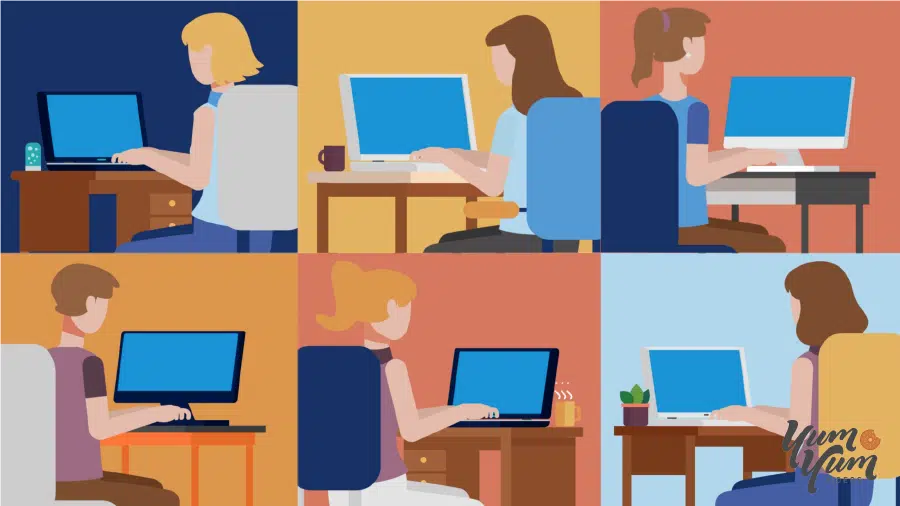
Table of Contents

Keeping students engaged and interested during class has become progressively harder in recent times. So, in order to help you get their attention and make learning a fun affair, we’ve come up with these video project ideas you can take advantage of.
Are you still not convinced about the usefulness of incorporating videos in the classroom? Well, educational video production has huge potential, as the resulting pieces are creative and compelling enough to keep viewers engaged while supplementing what students are learning.
I know it’s not always easy to come up with filming ideas for school, though, so here are some of my favorite suggestions for your classroom!
Make an Instructional Video
Making an instructional video isn’t rocket science, but you need to properly understand a topic in order to explain it to others. Your students will need to find new ways to present the topic, search for the right words to tackle it, and think of any questions the audience may have. That’s why instructional videos are a great way to put to the test how much a student actually understands about a subject.
You can have students record the steps they take in performing a science experiment, completing a task, or even ask them to make an explainer video about a certain topic . This opens up the possibility for them to also share their experiences and reflections about it.
Besides reinforcing the student’s knowledge acquired during class, this project idea allows you to assess their level of understanding of the subject.
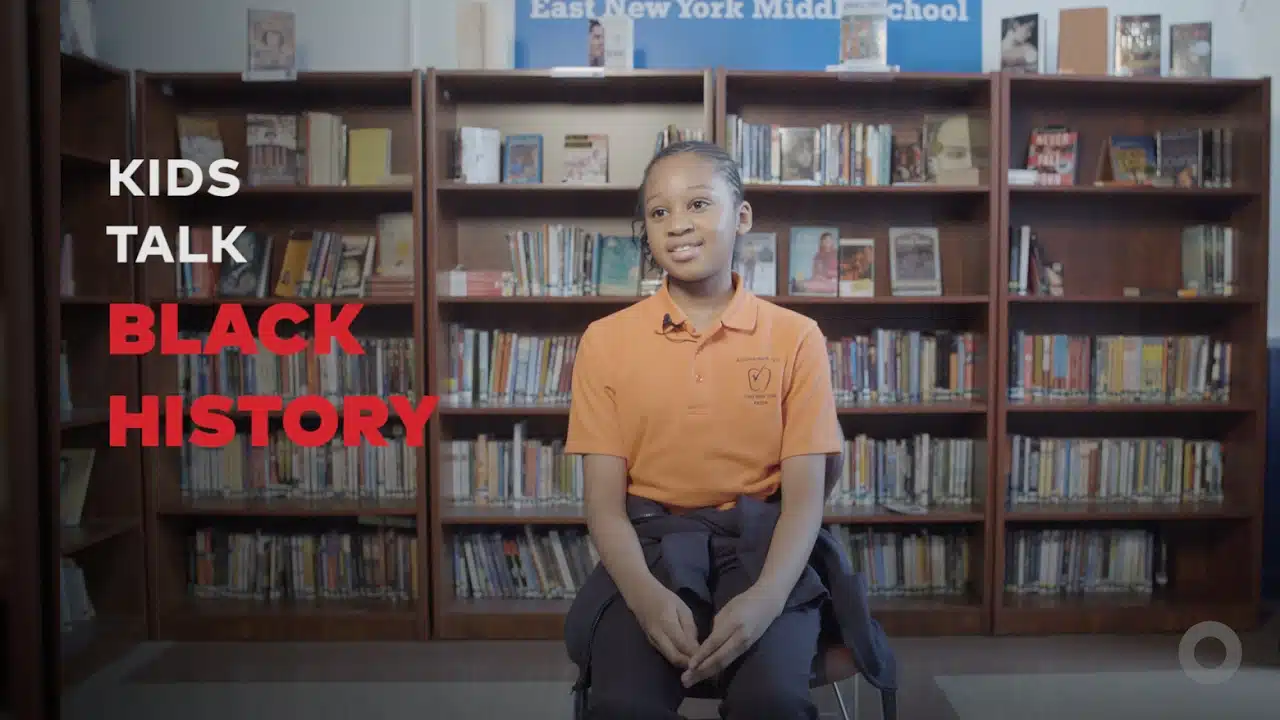
Film a Behind-The-Scenes Video
Group projects are a great way to teach kids something while fostering teamwork and collaboration. As a teacher, you grade the finished work, but how about being able to also see what happens behind the scenes?
Behind-the-scenes is one of teenagers’ most watched types of videos because they’re entertaining and engaging. That’s why this project video can be a great way to make students interested in group projects.
Meanwhile, you get to see who does what, how they decided to divide the workflow, and how they reacted when things worked out—or didn’t. Not only do you get to grade their project, but kids can also reflect on teamwork and how communal efforts look from a distance at the same time.
I bet you didn’t know video project ideas could do so much!
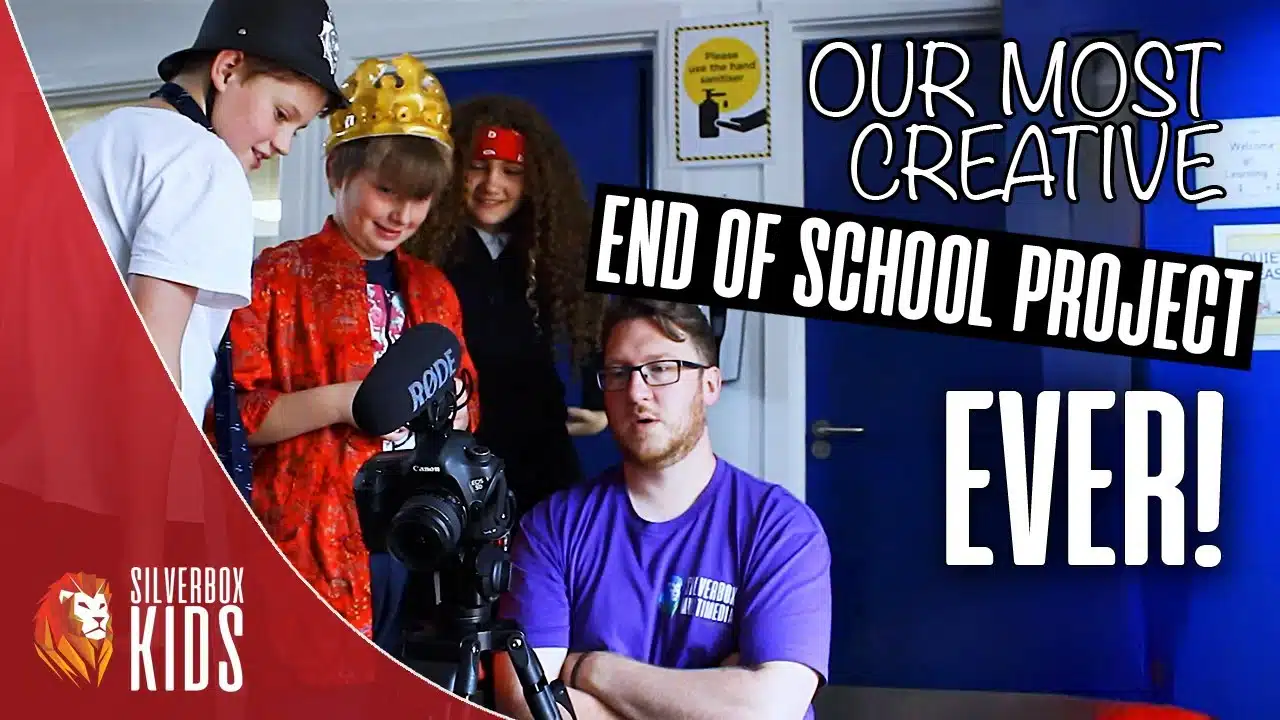
Recreate a Moment in History or Impersonate a Historical Figure
If you’ve been looking for video project ideas to use in your History classes, this one is perfect for you.
For students, learning about history can be difficult because some of the events that shaped our societies seem too far in the past to relate to them. Recreating key moments in history and transforming them into video storytelling can be a particularly fun way for students to connect more with historical figures and events.
By experiencing the past, topics are a lot easier to learn!

Record Interviews – Video Project Ideas
One of the difficulties kids face nowadays is bonding with others in meaningful ways.
While it’s true that social media allows us to connect with people from all around the globe, it can also make it harder to see the bonds that tie us to those around us. In order to fix that, having students conduct interviews could be great to strengthen their relationships with their communities.
Among all the video project ideas here, interviews are one of the easiest to produce. You can instruct them to have interviews in person, with both parties sitting next to each other in front of a camera. They can also conduct a virtual one, using a video call program to record a long-distance meeting.
The benefit of this project video is that it teaches students to reach out to people around them and to listen to what they have to say— instead of just reading it online!
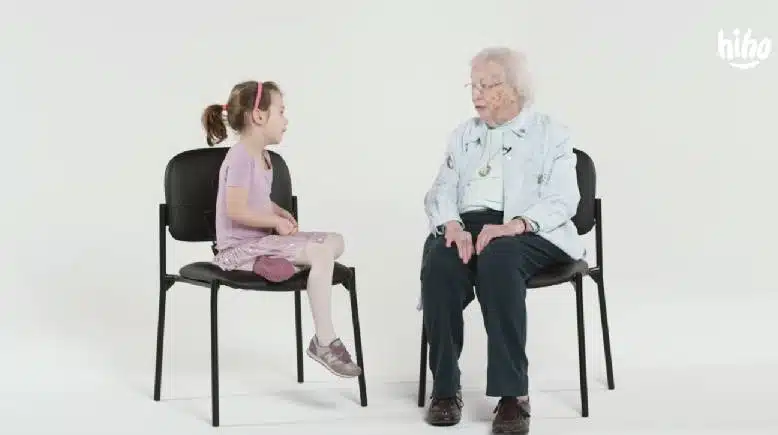
Create a Whiteboard Animation
Whiteboard animations, also known as doodle videos , are a creative and engaging way to tackle a highly complex topic while making it entertaining and easy to understand.
Making this type of drawn animation is quite straightforward. Students just have to set up their camera on a tripod or something that’ll keep it stable. Then, they have to aim the focus at a whiteboard, hit “record,” and start drawing. Once they’ve finished, they’ll need to use video editing tools to speed it up and add a voice-over. It’s not an issue if they don’t know how to make an animation because the style is pretty simple and doesn’t need to be perfect.
What makes this a great project video is that it teaches students about patience and attention to detail, as you only see the result of your hard work at the end of it when you review your video. Whiteboard animation is also a great way to bring out the kids’ creative skills!

(Example created by the explainer video production company Yum Yum Videos.)

Record a Meaningful Location or a Special Moment
When students visit a particular location, whether on a field trip or on vacation, you can ask them to share their experiences with others by filming and narrating them as they go. Their project videos can also be themed around festivals, cultural concepts, and special activities too. It’d be as if they were making a promo video about them to invite people to join!
You can have the kids give a tour of their schools, for example. They can highlight their favorite classes, film where they eat lunch, and explain the best part of their days. With a video editor app , it’s easy to put all of these scenes together to make a compelling and entertaining video.
What makes this one of the best video project ideas is that it encourages students to share their favorite places and moments in video. They’re probably already making Instagram videos about them, so why not do it for school too? Some years ahead, they can review all this footage and remember the good times they had!
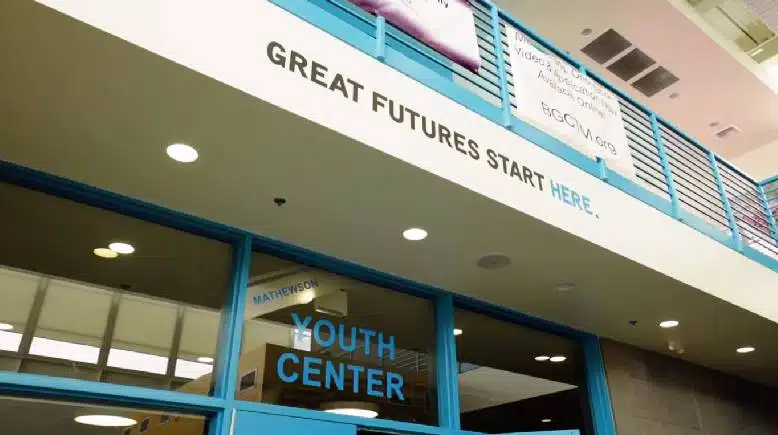
Share Practice Records
Learning a language, cooking, playing an instrument, or doing sports requires constant practice. If you’re looking for a way to encourage kids to learn new skills, this project video could be ideal.
You can ask them to record themselves learning to play an instrument or speaking a new language. It’s important for kids nowadays to have hobbies and activities that help them grow and connect with other people. And a great way to encourage them to continue developing their skills is for them to actually see their progress and learn from their own training videos .
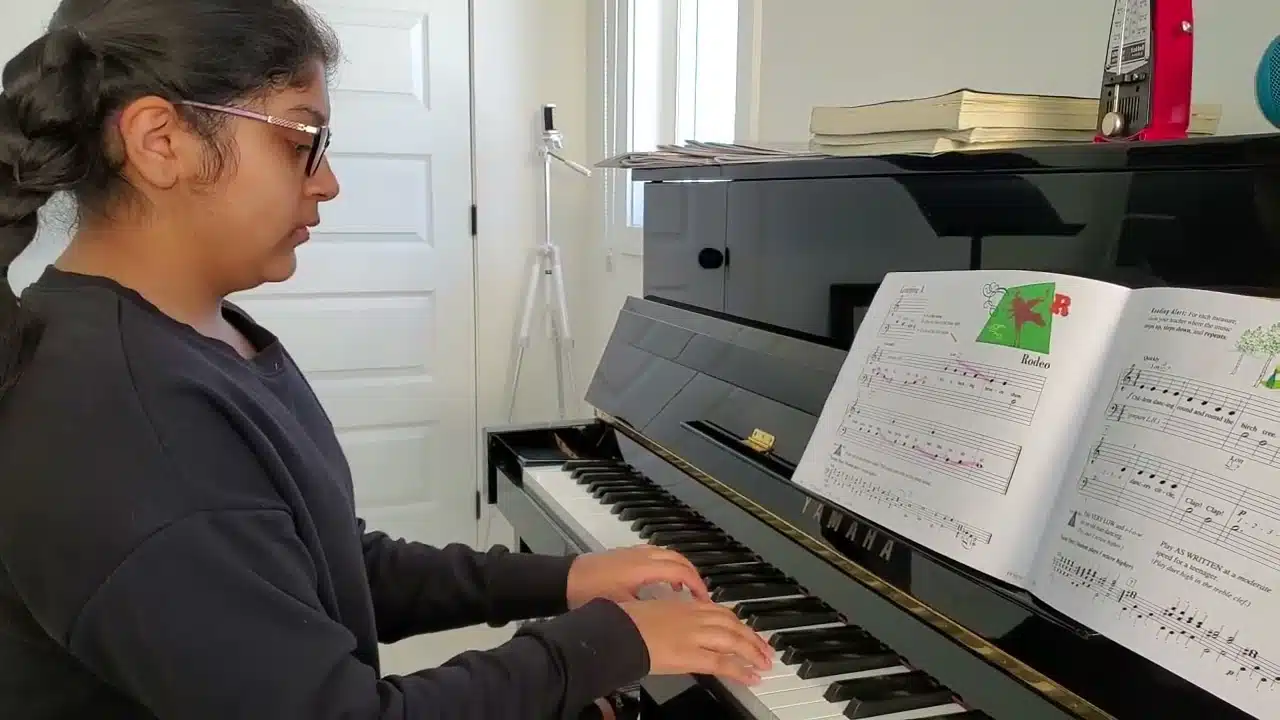
Create a News Show – Video Project Ideas
Having kids create a news show can be a way to motivate them to stay up-to-date with what’s happening in the world or their communities while also teaching them about the importance of checking your sources of information before sharing a message.
You don’t need to be a video marketing agency to create a news show with your students. If you do want to up your game, you can use a green screen— but even without it, you’ll probably get great results from your students.
You can give them a list of sites to check the data before recording their project videos, or you can tell them to look for that information in at least five different places. Whatever you choose, you’ll definitely have fun seeing the results of their investigation!
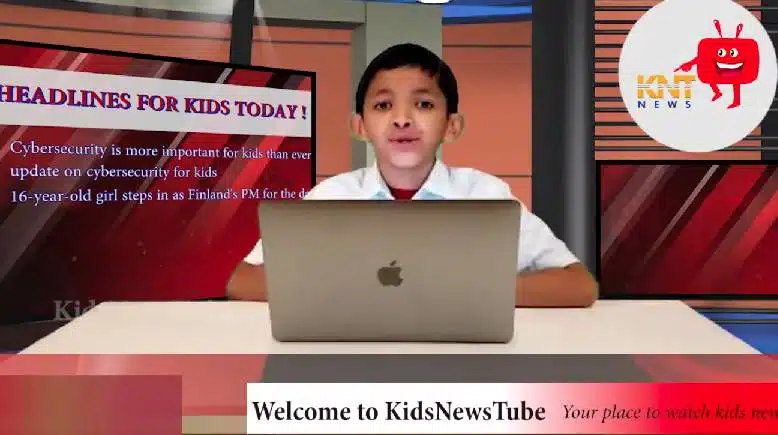
Create a Video Portfolio
Students can begin to plan for their future by creating a portfolio that showcases their unique skills and interests. In the project video, they can highlight their key skills while sharing their personalities.
Nowadays, many job-hunting sites encourage people to film themselves. The ability to stay in front of a camera and be confident in your skills is a really valuable asset for the future.
Video project ideas like these, where you encourage students to talk about themselves in front of a camera, allow you to teach kids the importance of knowing their strengths and being confident enough in themselves to share them.

Promote Your Future University or a Dream Job
Choosing a university and a future job are critical life-changing decisions that teenagers make at a young age. To best guide their decisions, proper research is essential.
So, have your students make a promotion video for their future university or dream job. Encourage them to properly investigate the topic and write a storyboard . On it, they’ll have to describe the benefits, strong aspects, and how it aligns with their life goals.
This project video can be a creative way to make planning your future more fun and interesting. Moreover, your students will be able to make a solid decision after properly assessing all their options.
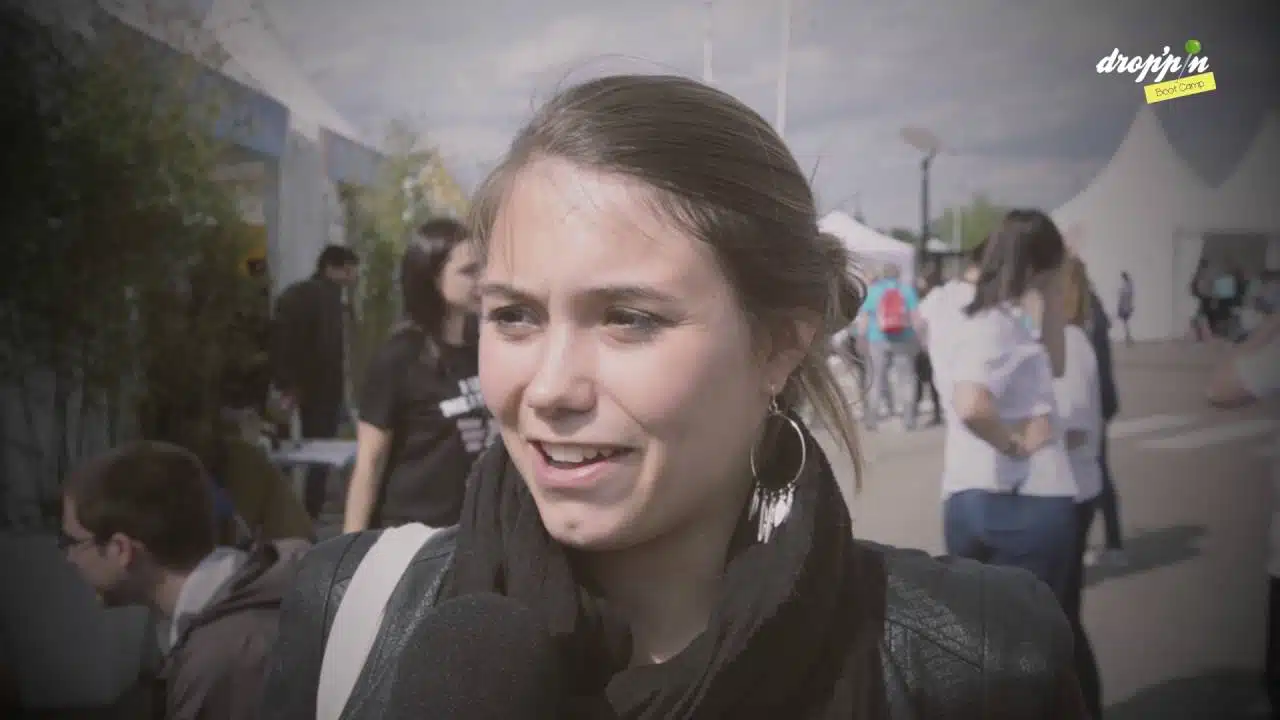
Wrapping up
As generations change, the way they access education and the methods they use to learn change with them. New forms of studying are constantly appearing, like e-learning videos .
Videos have proven to be an effective means for students because they are more attractive to them, which makes them effective in keeping their attention. In these video project ideas, you can find new strategies to entertain your students and connect with them while also teaching them valuable life lessons.
Plus, grading will definitely be more fun!

Florencia Corazza – Content Writer and Co-Editor
A skilled writer, translator, and co-editor for our web and blog content. As a self-defined "wordsmith," she’s talented in adapting the latest marketing news into all kinds of digital formats. If she’s not watching the latest Sci-Fi show on Netflix, then can find her tending to her perfectly reasonable number of plants.
Check out other Articles

Video Production, Strategy
How to make an explainer video (and how long does it take).
As you might as well know already, explainer videos have become a necessity for businesses and organizations looking to communicate their message effectively. These short, engaging pieces of content can break down complex ideas into easy-to-understand visual stories, making them a popular choice for marketing, training, and education. But do you know how to make […]

Video Production
Top explainer video makers and softwares of 2024.
It’s no secret that explainer videos have taken the marketing world by storm. Now, everyone and their aunt knows what is an explainer video and has one for their business. Metaphorically speaking, of course – unless there are many marketer aunts out there 😜. Anyway, creating engaging videos is now the cornerstone for any brands […]

Video Production, Marketing
Ai explainer videos: what do we know so far.
Artificial Intelligence has taken the online world by storm. There’s no industry that hasn’t been impacted by it, and video production is no exception. In fact, AI explainer videos are no longer a thing of the future and you can already experiment with creating your own explainer video using different online tools! However, with great […]
Keep up with the latest in video marketing
Sign up for our newsletter, biweekly digest from our video experts.

Making School Fun at Home
This article was previously published on 7/30/2019.
12 Ways to Make School Fun at Home for Students of All Ages
Back to school will look different this year as families and schools continue to navigate the uncertainty of COVID-19. Getting kids to enjoy (or even accept) doing their homework can be a struggle at any age, especially in the fall when students adjust to smaller classes, alternate schedules and a continuation of virtual learning that began in the spring.
For some families, new ways of learning are further complicated by parents’ work schedules and a lack of technology access. According to the Afterschool Alliance, 1 in 5 kids are unsupervised after the school day ends. And millions of families don’t have internet access at home.
During challenging times and busy parenting schedules, there are still ways to make learning at home fun, safe and constructive for students. Over the years, our trained youth mentors and program facilitators have developed lots of strategies and ideas to make homework more fun. Get tips on how to make virtual learning and homework fun in high school, middle school and elementary school so you can help your kid succeed at every age.
Ideas to Make Homework Fun for Elementary, Middle and High Schoolers
Many kids find homework assignments boring or simply get restless when asked to sit down and study – but that doesn’t mean they all need the same kind of motivation. Avoid a one-size-fits-all approach to homework help by using these age-appropriate tips.

Elementary School Homework Tips
Little kids frequently have trouble focusing on virtual learning and homework, especially when there are so many distractions and fun things to play with at home. The solution? Make learning more like playtime.
- Create fun focus spaces. Kids often work on homework in their rooms or wherever there’s a little spare table space – but kids’ rooms and common areas are usually filled with distractions. Before this school year starts, create a special “homework zone” in part of the home that’s more peaceful. (A “homework fort” is always a hit with young kids, as long as it’s well lit.) Stock this area with lots of colorful school supplies so there’s no reason to leave until their homework is all done.
- Beat the clock. Young kids love racing to the finish. Make homework more like a race by setting up timed challenges. For example, count how many words they can spell correctly or math problems they can solve in the span of 5 minutes. The next day, challenge your kid to beat their own record. (A little competition can work great with siblings, too.)
- Try learning apps. Support the subjects your kid studies in school with apps that make learning about it more fun. This tip is especially helpful for subjects that you or your kid struggle with. Some of our favorite educational apps include DragonBox for math, Spelling Stage for spelling, and DuoLingo , which offers learning-based games in Spanish, French and many other languages.
- Team up with tunes. Just like the Alphabet Song teaches kids their ABCs, there are plenty of songs out there to help specific subjects stick. Search YouTube to find songs covering a range of subjects, including the planets in our solar system, the days of the week and months of the year, U.S. states and capitals, how to add or subtract, and pretty much any other educational topic you can imagine. If you can’t find a song on a given subject, try making one up together.

Middle School Homework Tips
In middle school, students gain more independence to work alone or with peers. Encourage their developing maturity with a little structure and loads of support.
- Use power hours. Power hours challenge kids to focus for a certain amount of time. Once the timer goes off, they can take a quick break before diving in again. Offering little rewards after productive power hour sessions is a great incentive at this age, too.
- Plan study dates. If your kid struggles in a certain subject or has trouble focusing in a quiet, empty room, let them invite a friend or two over to study. Just remember to follow current safety and social distancing guidelines. If another kid is too much of a distraction, set the tone by working alongside your child. While they do homework, you can pay bills, make dinner, reply to emails, or even work on a crossword puzzle or another brain game. Doing “adult homework” creates a sense of companionship without being too overbearing – and it can help kids learn that work is a part of life, not just a part of school.
- Make a routine. Lack of routine can be stressful for kids. Setting a regular schedule for homework, or the school day for kids learning at home, can help reduce resistance and improve consistency. Beyond planning time for homework, come up with other little rituals that can help your kid focus, from putting on their current favorite album in the background to using prizes and other incentives to reward good work, like a small treat for every complete assignment.
- Stay positive. Your attitude has a huge impact on how your kid sees the world, especially in the formative middle school years. Keep tabs on your own attitude toward your kid’s homework. If you see helping your kid with homework as a chore, your kid will probably feel that way about it, too. Instead, try to see homework help as a fun, productive time when you both can learn and hang out together.

High School Homework Tips
When students reach high school, having parents hanging around to nag them about homework doesn’t always help. Instead of implementing these homework strategies for high schoolers yourself, show this list to your teenager and help them come up with a plan they can stick to. Then, take a step back. Check in with your teen every week or so to see if their plan needs tweaking.
- Get organized . High school is the perfect time to start preparing for the life you want to lead after you leave home. To achieve your goals, you have to make plans and stick to them. It’s the same with homework. When you get your assignments for the week, month or semester, take some time before jumping in to sort through the deadlines and requirements. Then, come up with a schedule and a realistic plan of attack. Use a day planner, calendar app, or time management app like Asana to make to-do lists for yourself – trust us, it feels great to cross stuff off your list.
- Reward yourself . It’s easier to work hard when you know there’s a reward at the end of it. Set a study timer, and if you’ve focused on homework until the timer goes off, reward yourself with a favorite snack, a funny video, an epic solo dance party or a little social media time.
- Upgrade your workspace. Spruce up the place you do virtual learning and homework to fuel your productivity, imagination and problem-solving skills. Keep tools and supplies on hand to help you work through challenging assignments, like colorful pens, highlighters, sticky notes, and cool notepads or notebooks. Decorate with art and other objects that inspire you, and use calendars, whiteboards, chalkboards, corkboards, or even just paper and tape to help visualize and keep track of everything you have to do.
- Turn up the beats. Spotify has tons of playlists dedicated to productivity, from ambient noise to instrumental hip-hop. Find a few go-to playlists that help keep you focused and put one on whenever you have to zone in. Explore movie soundtracks and other kinds of instrumental music to avoid distracting lyrics.
Homework Help from BGCA
Every day, thousands of kids and parents rely on Boys & Girls Clubs of America for homework help and out-of-school support, especially in the crucial hours after school lets out and during the summer months. Explore our website to learn more about our programs , find your nearest club or support BGCA today.
STAY INFORMED WITH NEWS & UPDATES

- Articles / Homework
Smart Homework: 13 Ways to Make It Meaningful
by MiddleWeb · Published 08/04/2014 · Updated 11/17/2019
In the first installment of Rick Wormeli’s homework advice, he made the case for take-home assignments that matter for learning and engage student interest . In Part 2, Rick offers some guiding principles that can help teachers create homework challenges that motivate kids and spark deeper learning in and out of school.
These articles are adapted and updated from Rick’s seminal book about teaching in the middle grades, Day One & Beyond: Practical Matters for New Middle Level Teachers . Rick continues to offer great advice about homework, differentiation, assessment and many other topics in workshops and presentations across North America. Check back in Part 1 for some additional homework resources.

I’ve been accumulating guiding principles for creating highly motivating homework assignments for many years — from my own teaching and from the distilled wisdom of others. Here are a baker’s dozen. Choose the ones most appropriate for students’ learning goals and your curriculum.
1. Give students a clear picture of the final product. This doesn’t mean everything is structured for them, or that there aren’t multiple pathways to the same high quality result. There’s room for student personalities to be expressed. Students clearly know what is expected, however. A clear picture sets purpose for doing the assignment. Priming the brain to focus on particular aspects of the learning experience helps the brain process the information for long-term retention. Setting purpose for homework assignments has an impact on learning and the assignment’s completion rate, as research by Marzano and others confirms.
2. Incorporate a cause into the assignment. Middle level students are motivated when they feel they are righting a wrong. They are very sensitive to justice and injustice. As a group, they are also very nurturing of those less fortunate than them. Find a community or personal cause for which students can fight fairly and incorporate your content and skills in that good fight— students will be all over the assignment.

4. Incorporate people whom students admire in their assignments. Students are motivated when asked to share what they know and feel about these folks. We are a society of heroes, and young adolescents are interested in talking about and becoming heroic figures.
5. Allow choices, as appropriate. Allow students to do the even-numbered or odd-numbered problems, or allow them to choose from three prompts, not just one. Let them choose the word that best describes the political or scientific process. Let them identify their own diet and its effects on young adolescent bodies. Let them choose to work with partners or individually. How about allowing them to choose from several multiple-intelligence based tasks? If they are working in ways that are comfortable, they are more likely to do the work. By making the choice, they have upped their ownership of the task.
6. Incorporate cultural products into the assignment. If students have to use magazines, television shows, foods, sports equipment, and other products they already use, they are likely to do the work. The brain loves to do tasks in contexts with which it is familiar.
7. Allow students to collaborate in determining how homework will be assessed. If they help design the criteria for success, such as when they create the rubric for an assignment, they “own” the assignment. It comes off as something done by them, not to them. They also internalize the expectations—another way for them to have clear targets.
With some assignments we can post well-done versions from previous years (or ones we’ve created for this purpose) and ask students to analyze the essential characteristics that make these assignments exemplary. Students who analyze such assignments will compare those works with their own and internalize the criteria for success, referencing the criteria while doing the assignment, not just when it’s finished.

9. Spruce up your prompts. Don’t ask students to repeatedly answer questions or summarize. Try some of these openers instead: Decide between, argue against, Why did ______ argue for, compare, contrast, plan, classify, retell ______ from the point of view of ______, Organize, build, interview, predict, categorize, simplify, deduce, formulate, blend, suppose, invent, imagine, devise, compose, combine, rank, recommend, defend, choose.
10. Have everyone turn in a paper. In her classic, Homework: A New Direction (1992), Neila Connors reminded teachers to have all students turn in a paper, regardless of whether they did the assignment. If a student doesn’t have his homework, he writes on the paper the name of the assignment and why he didn’t do it.

11. Do not give homework passes. I used to do this; then I realized how much it minimized the importance of homework. It’s like saying, “Oh, well, the homework really wasn’t that important to your learning. You’ll learn just as well without it.” Homework should be so productive for students that missing it is like missing the lesson itself.
12. Integrate homework with other subjects. One assignment can count in two classes. Such assignments are usually complex enough to warrant the dual grade and it’s a way to work smarter, not harder, for both students and teachers. Teachers can split the pile of papers to grade, then share the grades with each other, and students don’t have homework piling up in multiple classes.
There are times when every teacher on the team assigns a half-hour assignment, and so do the elective or encore class teachers. This could mean three to four hours of homework for the student, which is inappropriate for young adolescents.
13. Occasionally, let students identify what homework would be most effective. Sometimes the really creative assignments are the ones that students design themselves. After teaching a lesson, ask your students what it would take to practice the material so well it became clearly understood. Many of the choices will be rigorous and very appropriate.

This is one reason I always recommend that, as a basic premise, we avoid Monday morning quizzes and weekend or holiday homework assignments. Sure, there will be exceptions when long-term projects come due. But if we are really about teaching so that students learn and not about appearing rigorous and assigning tasks to show that we have taught, then we’ll carefully consider all the effects of our homework expectations. Our students will be more productive at school for having healthier lives at home.
▶ More resources from Rick Wormeli:
Although Rick never mentions the word homework in this article about helping adolescent students improve their “executive function,” you will immediately see the connections! At the AMLE website .
NEXT: In our final excerpt from Day One & Beyond, Rick Wormeli shares his approach to homework assessment – with an clear emphasis on maintaining teacher sanity.

His books include Meet Me in the Middle ; Day One and Beyond ; Fair Isn’t Always Equal: Assessment and Grading in the Differentiated Classroom ; Differentiation: From Planning to Practice; Metaphors & Analogies: Power Tools for Teaching Any Subject, and Summarization in Any Subject , plus The Collected Writings (So Far) of Rick Wormeli: Crazy Good Stuff I Learned about Teaching Along the Way .
He is currently working on his first young adult fiction novel and a new book on homework practices in the 21 st century.
Share this:
Tags: Day One & Beyond grading homework homework homework guidelines homework policies Rick Wormeli why homework
MiddleWeb is all about the middle grades, with great 4-8 resources, book reviews, and guest posts by educators who support the success of young adolescents. And be sure to subscribe to MiddleWeb SmartBrief for the latest middle grades news & commentary from around the USA.
4 Responses
- Pingbacks 0
This is a really great article. It has helped me tremendously in making new and better decisions about homework.
Fabulous sage advice! Although I love every single suggestion you’ve included, I am particularly fond of the elimination of the “homework pass”. As a former middle-level teacher and administrator, I too found the homework pass diminished the importance of follow-up work – a necessary component in determining the level of student understanding.
I do give 2 passes, but they just extend due date by a day. And if not used, they may be returned at the end of the 9 weeks for extra credit.
Rick Wormeli’s ideas and tips in this article continue to be stimulating and useful. That said, it’s been more than a decade since the first edition of his book on grading, homework and assessment, Fair Isn’t Always Equal appeared.
In the intervening years, Rick’s thinking about homework has benefited from his work with teachers and in schools and plenty of debate. In April 2018, he published a new 2nd edition of Fair Isn’t Always Equal that includes an even deeper discussion of homework and its relationship to best practice, differentiation, and the moral obligation of educators to insist on effective homework policies.
Visitors to the Stenhouse page for the new book can preview the *entire* text for free, so be sure to check that out.
Here’s a brief excerpt from the new book:
Tenet: Homework should enable students to practice what they have already learned in class and should not present new content for the first time. Principled Responses:
• I will not assign homework to students who do not understand the content. • I will give homework to some students and no homework or different assignments to others, depending on their proficiency. • I will use exit slips and formative assessment during class so I can determine proper after-school practice for each student. • I will not give homework because parents and administrators expect me to do so, or assign homework because it’s a particular day of the week. • I will assign homework only if it furthers students’ proficiency in the field we’re studying.
Thanks to Rick for giving us permission to share this!
Leave a Reply Cancel reply
Your email address will not be published. Required fields are marked *
Notify me of follow-up comments by email.
Notify me of new posts by email.
This site uses Akismet to reduce spam. Learn how your comment data is processed .
- Popular Posts
- Recent Posts
- Recent Comments

Book Reviews / mathematics
Engage All Students with Offbeat Math Problems

First Days of Math Class / Meaningful Math
Low Prep Math Activities to Start the Year Right!

Articles / New Teacher Advice
New to Teaching Grades 4-6? Try These Ideas

Articles / Back to School
Start 24/25 with Super Ideas from MiddleWeb

Book Reviews / Reading
How Reader’s Theater Builds Reading Fluency

Articles / Reading
Welcome Students with New Fiction for Fall

3 Ways to Relieve Back to School ‘Overwhelm’

Book Reviews / Leadership
Use Emotional IQ Skills to Navigate Turbulence

Articles / Differentiation
Differentiate with the Station Rotation Model

Book Reviews / Cultural Literacy
Literacy Instruction Can Promote Social Justice

Articles / Mathematics
Challenging Harmful Beliefs in Math Class

Articles / Critical Reading
Teaching Our Students How to Be Text-Savvy

26 of Our Best Posts for New MS Teachers

Book Reviews / History
Reach Past the Timeline with Thematic History

Articles / Leadership
Instructional Frameworks for Schoolwide Success

Articles / Group Work
4 Tips to Support Group Work in Middle School
- Cynthia Delacruz says: Laurie and Patti, I just finished a course and your book,...
- Lisa Pizzarelli says: I just read your book as part of a class I...
- Ann Palermo says: I am in your class right now and you are spot...
- Kelly says: Hello. I work for TERC, a non profit dedicated to STEM...
- Philip McDonald says: Thank you, This is a timely reminder on a process i...
Sign Up & Receive the Latest News about Our Content…
Email address:
First Name:
Read our Privacy Policy
BOOK REVIEWS

Centering Love, Justice & Liberation in Schools

Routines for Creating Reading Communities

All the Tools You’ll Need for Differentiation

What MATH-ish Can Add to Your Math Classes

Coaching That Builds GT Teacher Capacity

Building Skills in the World Language Class

Mapping Out Diverse Gifted Programs

Using 100-Word Stories for Expansive Writing

What to Expect from AI in Class and Beyond

Strategies for Teaching Against Disinformation

The Democratic Roots Essential to Literacy

How to Reclaim Your Energy, Passion, & Time

A Leadership Blueprint for Growth and Success

A How-to Guide to Better Engage Your Students

10 Tools to Help Kids Develop Their Talents

Creative Homework Ideas
Learn Bright Lessons include many creative ideas for classroom instruction and student learning. Students are asked to work independently or with their peers, fostering their collaboration skills. Of course, the lessons also include many traditional learning exercises. Such as, multiple-choice questions, matching, fill in the blank responses, and others. Since every school and classroom is different, any lesson used with students can be adapted.
Whether you are assigning homework based on Learn Bright lessons or your own school’s curriculum, the homework you assign is essential for learning. Some schools across the country have banned assigning homework to students while others limit the amount each night. If you do assign homework, there are several creative ideas you can use that will motivate your students to complete the homework you assign.
Creative hands-on learning activities and other similar learning ideas in the classroom are quite effective. They can be just as effective at home as well for a wide variety of subjects and assignments. In every student’s home, there is “stuff” and other resources that can be accessed to help students review a concept taught at school. Here are a few samples for different subjects:
MATH – Multiplication Facts
Students use the numbers that appear on product labels and multiply them together. Not only do they get multiplication practice, but they may also be introduced to a food label in a new way. It encourages the students to read food and other product labels. In this way, they can relate what they learn in class to the real world. Showing them when they will use these concepts in their everyday lives.
SCIENCE – Solids, Liquids, Gases
Students conduct a home or neighborhood search for items that are solids, liquids, or gases. For example, they can open the refrigerator and list milk, juice, and other beverages as liquids. The containers, butter, veggies, and more as solids. Carbonated drinks can be listed as containing gas. You can ask them later about eggs or Jell-O and other items that may be both solid and liquid. This reinforces their learning by allowing them to explore and use their creativity to complete the assignment.
SOCIAL STUDIES – Older Adult Interviews
Students may be studying topics in history from the past 50 to 100 years. With this exercise, they interview an older adult who lived through the event that they are studying. They obtain opinions and feelings related to the event. They also confirm (or dispute) facts the students have been taught. Finally, they discuss how the person was affected by the event. This gives them a deeper understanding of that event and shows them the value of primary sources.
LANGUAGE ARTS – Parts of Speech Search
Students practice identifying the seven parts of speech while at home. They do this by listing examples that are used during family conversations or those words found on product labels.
Describing Things
Students use each of the five senses to write descriptive sentences related to things at home or in the neighborhood. The aroma of dinner, the sound of cars passing on the street, the sight of moving tree branches, the feel of a parent’s hug, or the taste of a spicy meal. This allows them to connect the lesson to the real world. It allows them to think about their surroundings in a new and interesting way.
READING – Read and React
Students are asked to read aloud a passage from their favorite story or novel. Next, they ask family members or close neighbors for their reactions and opinions about a character/event from the passage. Students record the information and discuss it with the listener. This illustrates that different people may notice different things while reading. It gives the student a chance to practice discussing literature from a young age.
MUSIC – Favorite Music
Students will listen to a parent or other family member’s favorite genre of music. Then, list the instruments they hear, share their opinions of the sound, and discuss other artists from a particular era. This encourages them to engage with the music on a level they normally would not.
ART – Art Critic
Nearly all homes include some type of painting, picture, or sculpture on display. Students take a photo of an art piece in their home and share their opinion of the art piece with a family member. They can discuss the age of the work of art, how it adds to the room’s décor, why it’s significant to their family, and more. Students will gain valuable practice analyzing images and thinking about art with this homework assignment.
HEALTH – Food Search
The students conduct a food search, identifying healthy versus unhealthy foods. Next, they list reasons why they may be considered healthy or unhealthy, and reviewing food labels. This teaches students to think about what they eat. Hence giving them a fun and interactive activity to do for homework.
There are many, many more creative homework ideas you can use for at-home assignments for your students. Think outside the box when assigning homework. Practice incorporating interactive elements so that students aren’t just sitting at their desk. Try to create and develop assignments that kids will want to do. Avoid the assignments that kids simply have to do. Think of the real-world applications for your lesson material as inspiration and build your homework assignments around that. Creative homework assignments can be fun and, at the same time, teach and enhance subjects introduced in the classroom.
For more creative homework ideas, be sure to check out our lesson plans and YouTube videos!
Previous Post Creating a Classroom Newsletter
Next post building connection with students, related posts.

Preparing for Next School Year: Tips for a Smooth Transition

- Lesson Plans
- For Teachers
© 2024 Learn Bright. All rights reserved. Terms and Conditions. Privacy Policy.
- Sign Up for Free
How to Make Homework Fun

- Post author By admin
- September 6, 2023
Discover engaging strategies for how to make homework fun. Explore personalized study spaces, gamification, collaboration, and more to make learning enjoyable.
Hey there, homework warriors! Let’s face it, homework often gets a bad rap for being a total buzzkill. The mere thought of it can make us want to escape to a world of video games, socializing, or anything but those looming assignments. But guess what? It doesn’t have to be that way!
In this article, we’re about to embark on a journey to uncover the secret sauce of making homework downright fun. That’s right, we’re flipping the script and turning the dreaded “H-word” into an exciting adventure.
So, if you’re ready to banish the boredom and inject some pizzazz into your study sessions, keep reading. We’ve got 15 game-changing tips coming your way to transform homework from a chore into a choice activity!
Table of Contents
How to Make Homework Fun?
Have a close look at how to make homework fun:-
Design a Homework Haven
Transforming a corner of your room into a cozy study nook is all about creating an inviting space that inspires productivity. Consider adding a:
Comfy Chair
Choose a chair with good lumbar support and a cushioned seat for long study sessions.
Soft Cushions
Scatter a few soft cushions on your chair or on the floor to make the nook extra inviting.
Motivational Posters
Hang up posters with motivational quotes or images that resonate with your goals. For instance, a poster featuring a quote like “You’ve Got This!” can provide daily encouragement.
Set a Homework Schedule
Creating a daily study schedule tailored to your rhythm can significantly boost your productivity. Here’s how to go about it:
Identify Your Peak Hours
Pay attention to when you feel most alert and focused during the day. Are you a morning person, or does your energy peak in the evening?
Designate Prime Study Time
Once you’ve identified your prime hours, set aside that time for your most challenging subjects or tasks. For example, if you’re a night owl, designate 8 PM to 10 PM as your prime study time.
Set Goals and Rewards
Setting goals and rewards can turn studying into a thrilling game. Here’s how to make it work:
Task-Based Rewards
Break your study session into smaller tasks. For instance, if you have a 2-hour study session, set a timer for every 30 minutes. When you complete a task within the allotted time, reward yourself with a mini-break or a quick treat.
Dance Breaks
After accomplishing a particularly tough assignment or study session, treat yourself to a five-minute dance break to your favorite upbeat song.
Group Study Sessions
Studying with friends can make homework a social and interactive experience. Here’s how to organize a productive group study session:
Choose Study Buddies
Invite friends who are equally committed to studying. Avoid distractions and focus on collaborative learning.
During breaks, enjoy some snacks and refreshments together. It’s an excellent opportunity to bond and recharge.
Gamify Your Homework
Turning your assignments into a game can make them engaging and competitive. Here’s an example:
Math Challenges
For every correct math problem you solve, award yourself points. Set a target, like 100 points. Once you reach that goal, treat yourself to a favorite dessert or activity.
Use Technology Wisely
Leveraging educational apps and websites can make learning enjoyable. Consider:
Learning Languages
Apps like Duolingo and Babbel gamify language learning with interactive lessons and quizzes.
Science Simulations
Websites like PhET Interactive Simulations offer fun science experiments and simulations.
Listen to Music
Creating a playlist for different study moods can set the tone for productive work:
Upbeat Playlist
Compile lively tunes for subjects like math or science to keep your energy high.
Chillout Playlist
Use calming melodies for reading assignments or essay writing to stay focused.
Change Your Study Materials
Enhance your study materials with colors and visual appeal:
Colorful Notes
When taking notes, use different colored pens for headings, key points, and examples. Highlight important concepts with bright markers.
Create a Homework Playlist
Crafting a motivational playlist can boost your enthusiasm for study sessions:
Personalized Mix
Include songs that motivate you. Whether it’s energetic rock, inspiring pop, or calming instrumental, curate a playlist that resonates with you.
Relate Homework to Real Life
Connecting assignments to real-life situations can make them more meaningful. For example:
Applying Math
If you’re learning about percentages, practice by calculating discounts while shopping online. It’s a practical application of what you’re studying.
Ask for Help When Needed
Don’t hesitate to seek assistance when you’re stuck:
Online Tutors
Utilize online tutoring services like Khan Academy or Chegg when you need clarification on complex topics.
Celebrate Your Achievements
Reward yourself for completing challenging assignments:
Mini Rewards
After finishing a tough essay or solving a set of difficult problems, treat yourself to a favorite snack or a short episode of your favorite TV show.
Use Colorful Visual Aids
Visual aids can make complex topics easier to understand:
Timeline for History
Create a timeline of historical events using colorful markers and sticky notes. It helps you visualize the sequence of historical occurrences.
Stay Organized
Organization is key for effective studying:
Digital Planner
Use digital tools like Google Calendar or Todoist to keep track of assignments and due dates. Set reminders to stay on top of your tasks.
By incorporating these detailed strategies and examples, you can transform your homework routine into an enjoyable and productive experience tailored to your preferences and learning style.
These examples demonstrate practical ways to infuse fun and engagement into your homework routine, making the learning process more enjoyable and productive.
What are ways to make homework fun?
- Create a Comfortable Space: Design a cozy study spot with your favorite things.
- Set a Schedule: Stick to a regular study routine that suits you.
- Break Tasks Down: Divide homework into smaller, manageable chunks.
- Reward Yourself: Treat yourself after completing tasks or goals.
- Study with Friends: Make it social by studying with buddies.
- Use Apps: Try fun and educational apps for learning.
- Listen to Music: Create a motivating study playlist.
- Make It Visual: Use colors and visuals to make notes pop.
- Connect to Real Life: Relate homework to everyday situations.
- Stay Organized: Use planners to stay on top of assignments.
These simple tips can make homework less daunting and more enjoyable.
How do I make my homework less boring?
Want to jazz up your homework and banish the boredom? Here’s the lowdown:
Create Your Happy Place
Start by transforming your study spot into a haven of fun. Add some quirky decorations, fairy lights, or even a cozy blanket fort – whatever makes you smile.
Slice and Dice
Homework can feel like a mountain, right? Well, cut it into bite-sized chunks. Tackling one piece at a time feels way less overwhelming.
Goals with a Side of Rewards
Set yourself mini-goals and sprinkle rewards on top. Finish that math problem? Treat yourself to a victory dance or a mini snack party.
Study Squad
Invite a friend for a study date. You can help each other out and share some giggles during breaks.
Homework Gamified
Turn your homework into a game. Assign points or rewards for completing tasks. Hit a certain score, and it’s time to indulge in your favorite treat.
Dive into educational apps or websites. Learning becomes a blast when it’s interactive and entertaining.
Musical Motivation
Craft a playlist with your favorite tunes. Pop on some energetic beats for those math equations, or soothing melodies for reading assignments.
Colorful Creativity
Don’t just take notes, make them a work of art with colorful pens and highlighters. Visuals can make studying way more interesting.
Real-World Homework
Connect your assignments to real life. If you’re tackling percentages, apply them to calculate discounts while shopping online.
Stay Organized and Sane
Keep your homework organized using planners or digital tools. No more last-minute panics about forgotten deadlines.
With these tricks up your sleeve, homework will become a breeze, and you might even have some fun along the way!
| : |
How do I make myself enjoy homework?
Making yourself enjoy homework can be a challenge, but it’s possible with a few mindset shifts and strategies:
Find Purpose
Understand why you’re doing the homework. Connect it to your long-term goals and how it benefits you. Knowing the “why” can make it more meaningful.
Positive Mindset
Approach homework with a positive attitude. Focus on the sense of accomplishment you’ll feel when you complete it.
Set Realistic Goals
Break your homework into smaller tasks and set achievable goals. Completing each part can give you a sense of progress and satisfaction.
Create a Comfortable Space
Design a cozy and organized study area that you enjoy spending time in. A pleasant environment can make a big difference.
Mix up your subjects and tasks to avoid monotony. Switching between different assignments can keep things interesting.
Set a Schedule
Establish a study routine that suits your natural rhythm. Find the time of day when you’re most alert and use it for more challenging tasks.
Reward Yourself
Treat yourself after completing homework or reaching specific milestones. It can be as simple as a small snack, a short break, or doing something you love.
Stay Engaged
Try to actively engage with the material. Ask questions, discuss concepts with classmates, or relate it to real-life situations.
Study Groups
Consider joining or creating study groups with friends. Discussing topics and helping each other can make the process more enjoyable.
Celebrate Progress
Celebrate your achievements, even small ones. Recognize your efforts and improvements.
Mindfulness Techniques
Practice mindfulness or relaxation techniques before starting homework to reduce stress and increase focus.
If you’re struggling with a particular subject, don’t hesitate to ask for help from teachers, classmates, or online resources.
Visual Aids
Use visual aids like diagrams, charts, or flashcards to make studying more engaging and easier to grasp.
Incorporate Interests
If possible, relate homework topics to your interests or hobbies. It can make the material more relatable and enjoyable.
Use planners or digital tools to keep track of assignments, due dates, and progress. Being organized can reduce stress.
Remember that enjoying homework might not happen overnight, but by implementing these strategies and maintaining a positive mindset, you can make the process more enjoyable and rewarding.
How can I make my high school homework fun?
Making high school homework fun requires creativity and a positive attitude. Here are some tips to make your high school homework more enjoyable:
Personalize Your Space
Create a study environment that reflects your personality and interests. Decorate your study area with posters, photos, or artwork that inspires you.
Set a Homework Routine
Establish a consistent homework routine that aligns with your energy levels. Determine the best time of day for you to focus and stick to it.
Break Tasks into Smaller Steps
Divide your assignments into smaller, manageable tasks. Completing each step feels like an accomplishment and keeps you motivated.
Incorporate technology into your homework. Explore educational apps and websites that make learning interactive and engaging.
Study with Friends
Organize study groups with friends to tackle assignments together. You can explain concepts to each other and share different perspectives.
Gamify Your Learning
Turn your homework into a game. Set challenges, time limits, or point systems for completing tasks. Reward yourself when you meet your goals.
Create playlists for different subjects or moods. Upbeat music can boost your energy for math, while calming tunes can help you concentrate on reading assignments.
Experiment with different study materials. Use colorful pens, highlighters, or digital tools to make your notes visually appealing.
Real-Life Applications
Relate your homework to real-life situations whenever possible. For example, if you’re studying economics, analyze current events or business news .
Seek Support
Don’t hesitate to ask for help when needed. Reach out to teachers, classmates, or online resources for clarification or guidance.
Celebrate Achievements
Celebrate your accomplishments, no matter how small. Reward yourself with a treat, a short break, or an activity you enjoy after completing homework.
Use planners, to-do lists, or digital tools to stay organized and track assignments and deadlines.
Challenge Yourself
Set personal challenges to make homework more engaging. Aim to finish assignments faster or with higher accuracy than before.
Whenever possible, relate homework topics to your interests or future career goals. It can make the material more relatable and engaging.
Stay Positive
Maintain a positive attitude toward your homework. Focus on the sense of accomplishment and knowledge gained through your efforts.
By incorporating these strategies into your high school homework routine, you can make the experience more enjoyable and productive while achieving academic success.
In conclusion, making homework fun is not just a distant dream; it’s a practical approach that can transform the way you tackle your assignments.
By personalizing your study space, setting goals and rewards, collaborating with friends, and gamifying your learning, you can turn the once-dreaded homework into an engaging adventure.
Incorporating technology, music, colorful materials, and real-life connections adds an extra layer of enjoyment. Remember to celebrate your achievements along the way and stay organized to reduce stress.
With a positive mindset and these strategies in your arsenal, you can embark on your homework journey with enthusiasm, making it not only bearable but genuinely enjoyable.
So, let’s turn the page and dive into the exciting world of learning, one fun homework assignment at a time!
Frequently Asked Questions
Can i really make homework fun.
Absolutely! With the right approach and mindset, homework can be an enjoyable part of your academic journey.
What if I can’t concentrate with music?
Not everyone finds music helpful. Experiment with different study environments to discover what suits you best.
How do I avoid procrastination?
Creating a schedule and setting achievable goals can help you stay on track and avoid procrastination.
What if I still find a particular subject boring?
Try to connect it to your interests or real-life situations to make it more engaging.
How can I make studying with friends productive?
Ensure that your study group remains focused on the task at hand and avoids distractions.
- australia (2)
- duolingo (13)
- Education (284)
- General (78)
- How To (18)
- IELTS (127)
- Latest Updates (162)
- Malta Visa (6)
- Permanent residency (1)
- Programming (31)
- Scholarship (1)
- Sponsored (4)
- Study Abroad (187)
- Technology (12)
- work permit (8)
Recent Posts


VISIT TPT STORE
How to make homework fun – 9 ways to switch things up.
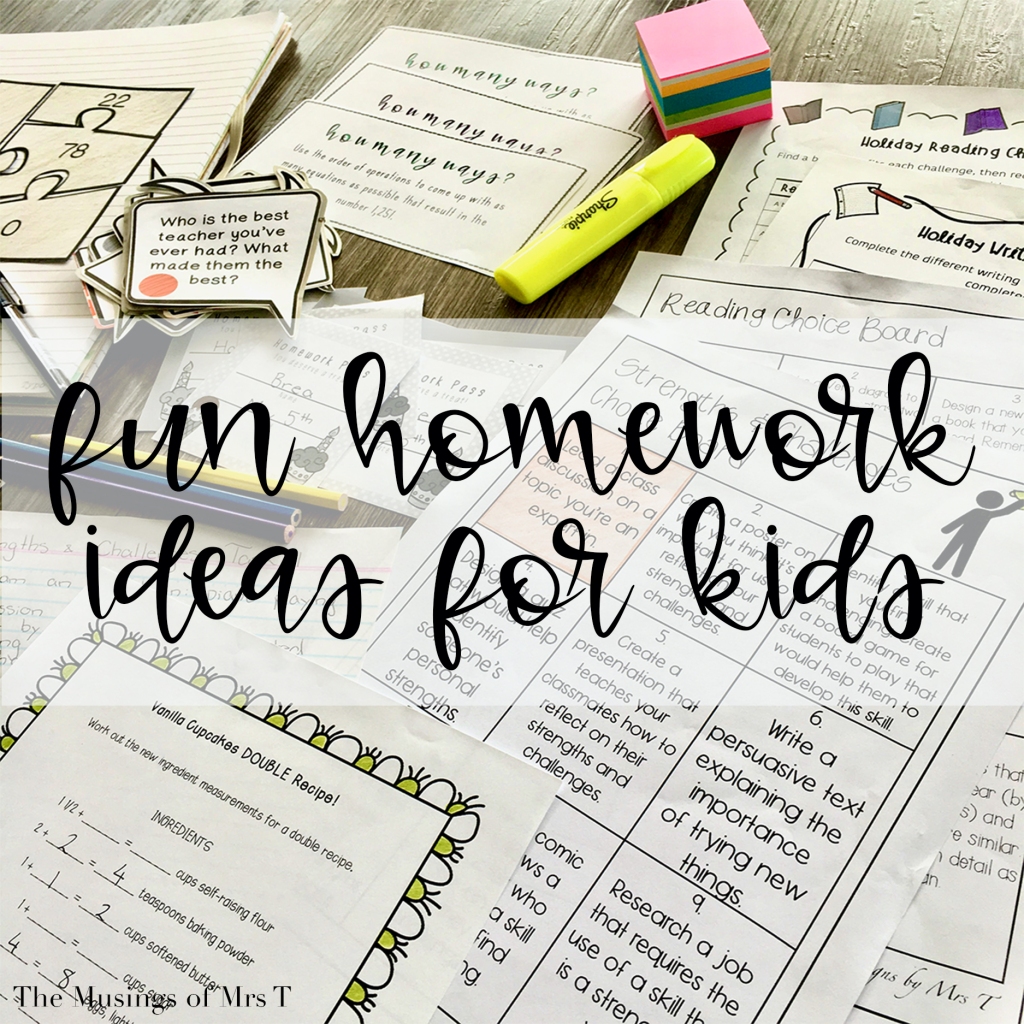
Homework. This word holds different associations for different people. As a teacher, I’ve heard all sorts of opinions on the topic of homework and have been informed about all of the negative aspects of assigning homework for students. However, I don’t believe that setting homework is necessarily a bad choice. Not when it’s done correctly. Also, many schools still require that homework is set for students.
So, as teachers, how can we make sure we are approaching homework the right way, in order to provide enriching opportunities for student learning to take place? Well, here are a few simple ideas to get you started:
Use Task Cards
Task cards are so versatile and are the easiest way to get the same content out to your students that you would put on a worksheet, but in a more interesting format.
Here’s an example of how you can use them for homework. Say you’re working on revising perimeter with your students. Instead of giving them a quiz worksheet, break the questions up into task cards. Create a game out of the cards and ask them to complete a recording sheet as they work through the cards. Hey, presto! You’ve now got the student data you need to assess their knowledge of perimeter, all while your students have had fun playing a game with the task cards you sent them home with. Now, that’s a win-win.
If you are working on perimeter with your students, but you’re thinking you don’t have time to put together your own task cards – you can get my ready-to-use Perimeter Task Card Set here !

Playing games is an effective way to keep students engaged in a task, and there are many fun games that you can use as homework activities. A great part about sending games home with kids for homework is that it encourages parents to get involved in their children’s learning. For example, if you’re having students work on their times table facts, you can use a game like Times Table Bingo . This game is simple for students and parents to understand the rules of, and it allows children to use the strategies that they find most helpful for working out the times table facts.

Make It Personal
Do you know what we all love talking about? Ourselves. Yep, and our students are no different. If you want to get them interested in homework again, give them a chance to share something about themselves. This not only keeps them engaged, but it also helps you get to know them better! If you’re after some resources that provide opportunities to get to know your students, I have a Getting to Know You Bundle available here.

Try Puzzles
Puzzles are such a fun educational tool! They can be used for almost any subject area and are especially easy to incorporate into your homework routine. One way this can be done is by using addition puzzles . In the example shown below, students need to use their addition skills to put three numbers together that equal one hundred. You can adapt this strategy as you need to so that the puzzles focus on whichever learning area your students are spending their homework time on.

Set a Challenge
Setting a learning challenge can be a helpful motivator for kids. I have often used holiday challenges like the one shown below with my students, but there’s no need to wait until the holidays! Think of some different activities that suit the topics you’re covering in class and put together a challenge for your students to work on during their homework time. If you want to save yourself some planning time, I have some ready-made maths and literacy challenges available here .

Make It Practical
Have you tried asking your students to do everyday tasks for homework, such as cooking? This is a great way to engage those learners who find it difficult to sit still and focus for long periods of time. Plus, it encourages parents to get involved too! If you want to give this a try, you can start with part 2 of my Cooking With Maths series , which involves calculating the ingredients needed to bake some yummy vanilla cupcakes!

Utilise Student Choice Boards
I’m an advocate for using student choice boards in the classroom, which is why I often talk about them in my posts. The great thing about choice boards is that you can easily combine more than one subject area in the one board and can switch up the options as often as you like. If you’re after some choice boards for upper primary / elementary students, I have a bundled set available here .
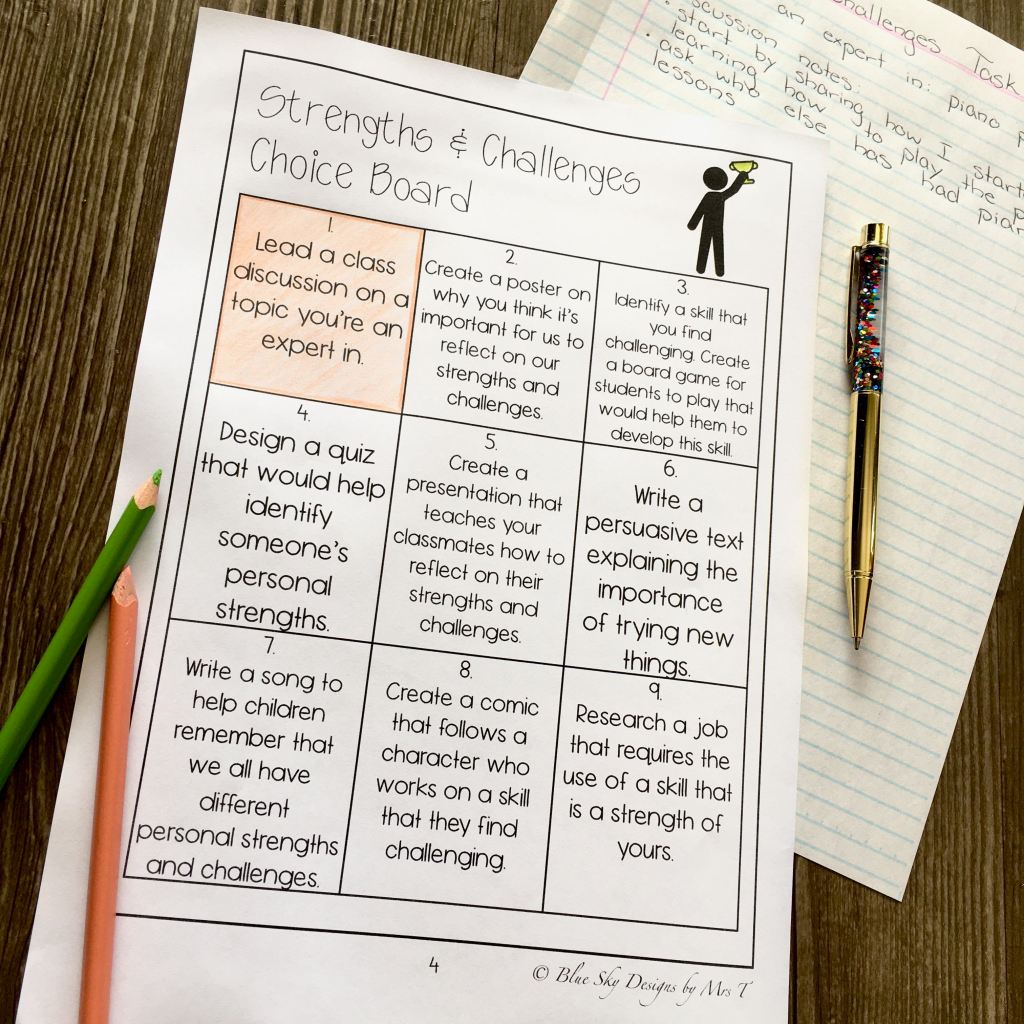
Remember That Less is More
When it comes to homework, teachers and students can tend to overcomplicate things. Although it can be tempting to pack as much into your homework routine as possible, homework is often much more effective when it is simple. Choose one or two activities that are easy for students to understand and let them spend their time on that. Remember that sometimes less is more.
Give Your Students The Night Off
Every now and then there will be times when you and your students just need the night off. That’s when I like to use tokens like these sweet ‘No Homework’ Passes to make a night of no homework seem like a special, well-earned treat for students. Although, when your homework activities are as fun as the ideas above, your students might be a little disappointed to have the night off anyway!
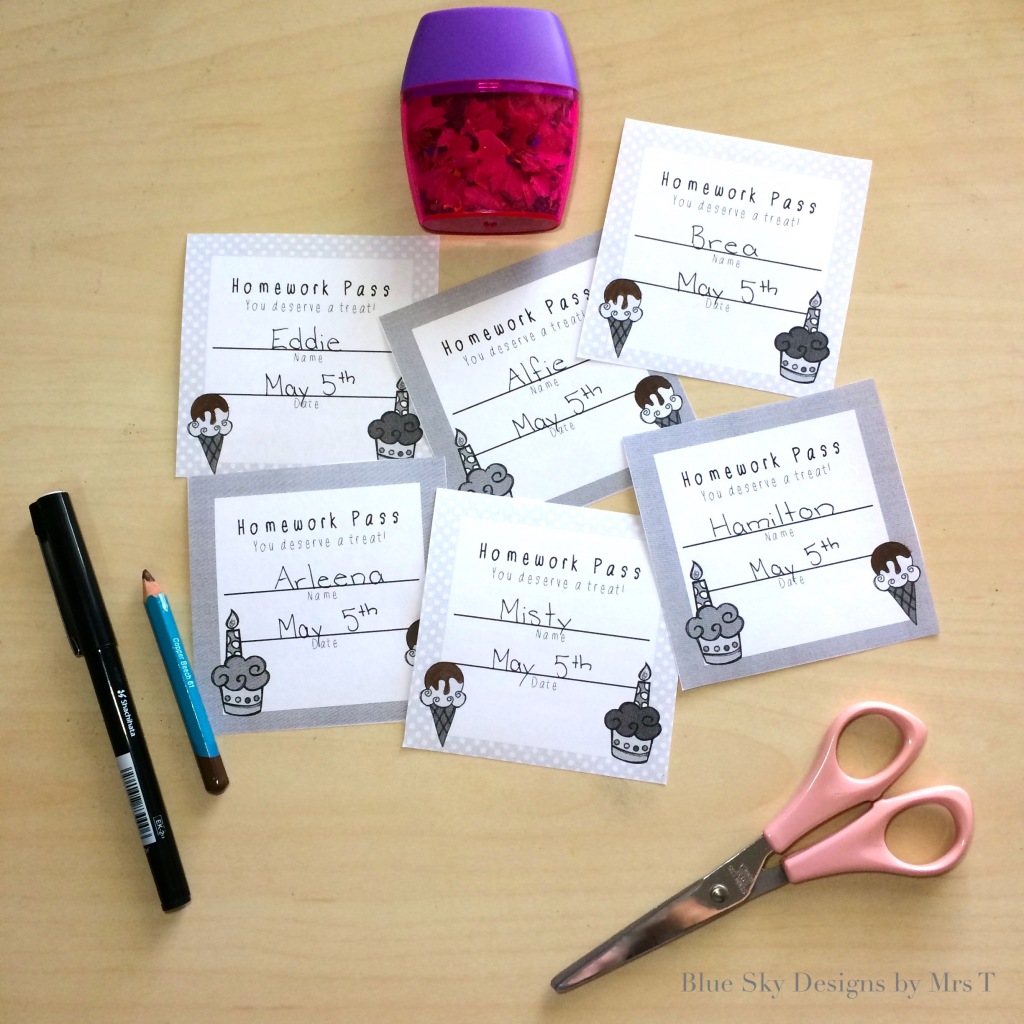
I hope that these ideas inspire you to try something new with your homework routine. You can use the links to buy your own copies of any resources I’ve referenced in this blog post.
P.S. I love to hear how my tips and resources are helping you in your teaching, so leave a comment to let me know!
Do you want some more homework tips that are specific to times table practice while you’re here? Then have a read through my list of engaging times table homework activities .
Have a question or a request? You can contact me at [email protected] .
Please feel free to share this post with others:
- Click to share on Facebook (Opens in new window)
- Click to share on Pinterest (Opens in new window)
- Click to email a link to a friend (Opens in new window)
- Click to share on Twitter (Opens in new window)

- Already have a WordPress.com account? Log in now.
- Subscribe Subscribed
- Copy shortlink
- Report this content
- View post in Reader
- Manage subscriptions
- Collapse this bar
- Our Mission

5 Ways to Make Homework More Meaningful
Use these insights from educators—and research—to create homework practices that work for everyone.
Homework tends to be a polarizing topic. While many teachers advocate for its complete elimination, others argue that it provides students with the extra practice they need to solidify their learning and teach them work habits—like managing time and meeting deadlines—that have lifelong benefits.
We recently reached out to teachers in our audience to identify practices that can help educators plot a middle path.
On Facebook , elementary school teacher John Thomas responded that the best homework is often no-strings-attached encouragement to read or play academically adjacent games with family members. “I encourage reading every night,” Thomas said, but he doesn’t use logs or other means of getting students to track their completion. “Just encouragement and book bags with self selected books students take home for enjoyment.”
Thomas said he also suggests to parents and students that they can play around with “math and science tools” such as “calculators, tape measures, protractors, rulers, money, tangrams, and building blocks.” Math-based games like Yahtzee or dominoes can also serve as enriching—and fun—practice of skills they’re learning.
At the middle and high school level, homework generally increases, and that can be demotivating for teachers, who feel obliged to review or even grade halfhearted submissions. Student morale is at stake, too: “Most [students] don’t complete it anyway,” said high school teacher Krystn Stretzinger Charlie on Facebook . “It ends up hurting them more than it helps.”
So how do teachers decide when to—and when not to—assign homework, and how do they ensure that the homework they assign feels meaningful, productive, and even motivating to students?
1. Less is More
A 2017 study analyzed the homework assignments of more than 20,000 middle and high school students and found that teachers are often a bad judge of how long homework will take.
According to researchers, students spend as much as 85 minutes or as little as 30 minutes on homework that teachers imagined would take students one hour to complete. The researchers concluded that by assigning too much homework , teachers actually increased inequalities between students in exchange for “minimal gains in achievement.” Too much homework can overwhelm students who “have more gaps in their knowledge,” the researchers said, and creates situations where homework becomes so time-consuming and frustrating that it turns students off to classwork more broadly.
To counteract this, middle school math teacher Crystal Frommert said she focuses on quality over quantity. Frommert cited the National Council of Teachers of Mathematics , which recommends only assigning “what’s necessary to augment instruction” and adds that if teachers can “get sufficient information by assigning only five problems, then don’t assign fifty.”
Instead of sending students home with worksheets and long problem sets from textbooks that often repeat the same concepts, Frommert recommended assigning part of a page, or even a few specific problems—and explaining to students why these handpicked problems will be helpful practice. When students know there’s thought behind the problems they’re asked to solve at home, “they pay more attention to the condensed assignment because it was tailored for them,” Frommert said.
On Instagram , high school teacher Jacob Palmer said that every now and then he condenses homework down to just one problem that is particularly engaging and challenging: “The depth and exploration that can come from one single problem can be richer than 20 routine problems.”
2. Add Choice to the Equation
Former educator and coach Mike Anderson said teachers can differentiate homework assignments without placing unrealistic demands on their workload by offering students some discretion in the work they complete and explicitly teaching them “how to choose appropriately challenging work for themselves.”
Instead of assigning the same 20 problems or response questions on a given textbook page to all students, for example, Anderson suggested asking students to refer to the list of questions and choose and complete a designated number of them (three to five, for example) that give students “a little bit of a challenge but that [they] can still solve independently.”
To teach students how to choose well, Anderson has students practice choosing homework questions in class before the end of the day, brainstorming in groups and sharing their thoughts about what a good homework question should accomplish. The other part, of course, involves offering students good choices: “Make sure that options for homework focus on the skills being practiced and are open-ended enough for all students to be successful,” he said.
Once students have developed a better understanding of the purpose of challenging themselves to practice and grow as learners, Anderson also periodically asks them to come up with their own ideas for problems or other activities they can use to reinforce learning at home. A simple question, such as “What are some ideas for how you might practice this skill at home?” can be enough to get students sharing ideas, he said.
Jill Kibler, a former high school science teacher, told Edutopia on Facebook that she implemented homework choice in her classroom by allowing students to decide how much of the work they’ve recently turned in that they’d like to redo as homework: “Students had one grading cycle (about seven school days) to redo the work they wanted to improve,” she said.
3. Break the Mold
According to high school English teacher Kate Dusto, the work that students produce at home doesn’t have to come in the traditional formats of written responses to a problem. On Instagram , Dusto told Edutopia that homework can often be made more interesting—and engaging—by allowing students to show evidence of their learning in creative ways.
“Offer choices for how they show their learning,” Dusto said. “Record audio or video? Type or use speech to text? Draw or handwrite and then upload a picture?” The possibilities are endless.
Former educator and author Jay McTighe noted that visual representations such as graphic organizers and concept maps are particularly useful for students attempting to organize new information and solidify their understanding of abstract concepts. For example, students might be asked to “draw a visual web of factors affecting plant growth” in biology class or map out the plot, characters, themes, and settings of a novel or play they’re reading to visualize relationships between different elements of the story and deepen their comprehension of it.
Simple written responses to summarize new learning can also be made more interesting by varying the format, McTighe said. For example, ask students to compose a tweet in 280 characters or less to answer a question like “What is the big idea that you have learned about _____?” or even record a short audio podcast or video podcast explaining “key concepts from one or more lessons.”
4. Make Homework Voluntary
When elementary school teacher Jacqueline Worthley Fiorentino stopped assigning mandatory homework to her second-grade students and suggested voluntary activities instead, she found that something surprising happened: “They started doing more work at home.”
Some of the simple, voluntary activities she presented students with included encouraging at-home reading (without mandating how much time they should spend reading); sending home weekly spelling words and math facts that will be covered in class but that should also be mastered by the end of the week: “It will be up to each child to figure out the best way to learn to spell the words correctly or to master the math facts,” she said; and creating voluntary lesson extensions such as pointing students to outside resources—texts, videos or films, webpages, or even online or in-person exhibits—to “expand their knowledge on a topic covered in class.”
Anderson said that for older students, teachers can sometimes make whatever homework they assign a voluntary choice. “Do all students need to practice a skill? If not, you might keep homework invitational,” he said, adding that teachers can tell students, “If you think a little more practice tonight would help you solidify your learning, here are some examples you might try.”
On Facebook , Natisha Wilson, a K–12 gifted students coordinator for an Ohio school district, said that when students are working on a challenging question in class, she’ll give them the option to “take it home and figure it out” if they’re unable to complete it before the end of the period. Often students take her up on this, she said, because many of them “can’t stand not knowing the answer.”
5. Grade for Completion—or Don’t Grade at All
Former teacher Rick Wormeli argued that work on homework assignments isn’t “evidence of final level of proficiency”; rather, it’s practice that provides teachers with “feedback and informs where we go next in instruction.”
Grading homework for completion—or not grading at all, Wormeli said—can help students focus on the real task at hand of consolidating understanding and self-monitoring their learning. “When early attempts at mastery are not used against them, and accountability comes in the form of actually learning content, adolescents flourish.”
High school science teacher John Scali agreed , confirming that grading for “completion and timeliness” rather than for “correctness” makes students “more likely to do the work, especially if it ties directly into what we are doing in class the next day” without worrying about being “100% correct.” On Instagram , middle school math teacher Traci Hawks noted that any assignments that are completed and show work—even if the answer is wrong—gets a 100 from her.
But Frommert said that even grading for completion can be time-consuming for teachers and fraught for students if they don’t have home environments that are supportive of homework or if they have jobs or other after-school activities.
Instead of traditional grading, she suggested alternatives to holding students accountable for homework, such as student presentations or even group discussions and debates as a way to check for understanding. For example, students can debate which method is best to solve a problem or discuss their prospective solutions in small groups. “Communicating their mathematical thinking deepens their understanding,” Frommert said.
- Privacy Policy
- HTML Sitemap
- Write for us
- Competitor Analysis
- Recent Sites
- SEO Checklist
- SEO Audit Checklist
- WordPress SEO Checklist
- Free AI Chatbot
- Free AI Text Generator
- Free AI Image Generator
- Cookie Policy
- Development
- Advanced SEO Techniques
- Software Reviews
100+ YouTube Video Ideas For your Channel (With Examples)
- by Raman Singh
- December 14, 2023
- 33 minutes read

Are you struggling to think of fresh, engaging content for your YouTube channel?
An idea drought can be a real hiccup for any content creator. But fret not; we’ve got your back with over 100+ YouTube video ideas to reignite your creativity!
From fun challenge videos and reaction videos to detailed tutorial videos, a wealth of content is just waiting for you to explore.
Whether you’re a beginner looking for your first YouTube video idea or a seasoned pro needing creative rejuvenation, this extensive guide has something for everyone.
Dive into these popular YouTube video ideas and create videos that will captivate your audience.
YouTube Video Idea Generator by VidIQ
The YouTube Video Idea Generator by VidIQ is a powerful tool that takes the guesswork out of finding the perfect video ideas for your channel.
checkout vidIQ Review 2023: How I Got 100k+ Views Using it?
By analyzing trends, keywords, and popular content across YouTube, VidIQ provides many relevant and engaging video suggestions tailored to your niche.
Also learn, How to Research Keywords for YouTube Like Pro Using VIDIQ
This tool offers an efficient way to stay ahead of the curve, delivering video ideas that resonate with your target audience and enhance your channel’s growth. It’s time to turn your creativity up a notch with the YouTube Idea Generator by VidIQ.

Step 1: Add Your Channel to the Vidiq App
First, you need to add your youtube channel to the vidiQ app. To do this, log in to app.vidiqi.com , click on your profile icon on the right, and select “channel settings.”;

Here, you need to authenticate with your Youtube channel and after you’ve done the same you channel settings will look like below;

Now vidiQ has all the data related to your channel, browse through the 2 options below to get your video ideas from your YouTube channel ideas.
Step 2: Daily ideas (Option 1)
For this option, You need to wait for 24 hours until vidiQ gets all the information they need to provide YouTube video ideas related to your channel niche.
Afterwards, you will see daily ideas by going to the daily ideas section;

Now when you click on it, you will see 100s of suggestions related to your channel niche;

Step 3: Video Ideas by VidiQ AI (Option 2)
There’s also a second option in vidiQ, i.e. AI Coach;

The interface is ChatGPT-alike, and AI Coach is basically your personal YouTube assistant who has all the knowledge of your channel and is ready to provide all the answers, for example, asking what to create next.
just ask, “Based on my channel, what video ideas do you have for me?”

Isn’t it amazing? and there’s even more: you can ask your AI coach to suggest reel ideas and much more; ask away!
YouTube Videos Idea
Before we delve into our extensive list of YouTube video ideas, it’s important to remember that the best content is often driven by passion.
Be sure to select ideas that resonate with you, align with your channel’s niche, and ignite your creative fires.
From cooking tutorials to travel vlogs, and comedy skits to educational content, there’s an endless realm of possibilities for your YouTube channel.
These ideas are designed to inspire and invigorate your creative process, providing a launchpad for unique, engaging content that will captivate your audience’s attention.
Let’s dive into the world of endless possibilities with these YouTube video ideas.
Review YouTube Video Idea
1 . product review.
One of the most popular YouTube video ideas is product reviews . People are always looking to make informed decisions before purchasing a product and your review videos can guide them. You can review anything from tech gadgets, books, makeup, or even food products. Be detailed, and honest, and make it engaging.
2 . Film and TV Show Reviews
If you’re a movie or TV show buff, create videos reviewing the latest releases or classics. Share your opinions, dissect plot twists, analyze characters, and predict future storylines. This can lead to insightful discussions in your video comments.
3 . Music Album Review
For music lovers, review the latest albums or songs from various artists . You can even focus on a specific genre. Talk about the lyrics, composition, the artist’s delivery, and how it compares to their previous works.
4 . Book Review
Bookworms, this is for you! Share your thoughts on the latest books you’ve read. You can discuss the plot, characters, and writing style, and give a rating. This can be a great way to build a community of book lovers on your YouTube channel.
5 . App/Game Review
With new apps and games released every day, users look for reviews before downloading. Share your insights about the gameplay, graphics, user experience, and more.
6 . Restaurant /Recipe Review
If you love food, why not create videos reviewing restaurants or recipes? Share your culinary journey, discuss the ambiance, service, and of course, the food at various eateries. Or, try out recipes from cookbooks or online platforms and review the process and the final product. Food videos are always a hit on YouTube!
7 . Fashion/Beauty Product Review
For fashion and beauty enthusiasts, review the latest products from makeup brands or clothing lines. Share your thoughts on the quality, packaging, and value for money. This can help viewers make informed decisions before making a purchase.
8 . Travel Destination Review
If you’re an avid traveler, create videos reviewing your favorite destinations. Share insider tips, budget-friendly options, and things to do and see. Your reviews can inspire others to visit these places or provide helpful information for their future travels.
9. Cooking Tools Review
Share your honest opinion and review cooking gadgets , appliances, or cookbooks. Discuss their usability, efficiency, and how they have made a difference in your kitchen. This can be especially helpful for viewers who are looking to upgrade their cooking tools.
10 . Event Review
Attend an event or festival and review it on your channel. Share highlights, interviews with attendees, and your overall experience. This can be a great way to showcase different events happening around the world.
11 . Vehicle Review
For automotive enthusiasts, create videos reviewing cars or bikes . Share details about the specs, performance, and value for money. These videos can attract a niche audience of fellow car or bike lovers.
Cooking YouTube Video Ideas
12. beginner-friendly recipes.
Perfect for those just starting their culinary journey. Share simple, step-by-step instructions for dishes like homemade pizza or spaghetti bolognese.
13 . International Cuisine
Take your viewers on a gastronomic world tour. Each video could focus on a signature dish from a different country.
14 . Cooking Challenges
Add some fun to your content by attempting challenges like cooking a three-course meal in under an hour, or using a mystery box of ingredients.
15 . Recipe Reaction Videos
Share your reactions and thoughts on popular food trends or viral r ecipe videos .
16 . Kitchen Tips and Tricks
Share your kitchen hacks , from how to chop onions without crying to the best way to deseed a pomegranate.
17 . Meal Prep Tutorials
Show your viewers how to prepare a week’s worth of meals to save time and encourage healthier eating.
18 . Cooking with Kids
Make a series of videos cooking simple , kid-friendly meals with your younger family members.
19 . Diet-Specific Recipes
Cater to different dietary requirements such as vegan, gluten-free, or keto recipes .
20 . Holiday Specials
Create videos showing how to prepare festive dishes for holidays like Thanksgiving, Christmas, or Easter.
Fitness YouTube Video Ideas
21. workout routine.
A staple of fitness YouTube video ideas is sharing your workout routine . Whether it’s a gym session, a home workout, or an outdoor workout, viewers are always looking for new ways to stay fit. Make sure to explain each exercise clearly and mention their benefits.
22. Fitness Challenge Videos
Challenge videos are among the most popular YouTube video ideas. You could challenge yourself to try a new fitness routine for a month, to lose a certain amount of weight, or to master a difficult exercise. Document your progress and share your experiences, the difficulties you encountered, and the results.
23. Nutrition Tips
Fitness is not just about exercise, it’s also about nutrition. Share your meal plans, and your favorite healthy recipes, or even debunk common diet myths. This can be a great way for your viewers to learn more about the importance of nutrition in fitness.
24. Fitness Journey
Share your fitness journey with your viewers. How did you start? What motivated you? What results have you seen? This can be a great source of inspiration for your viewers.
25. Q&A Videos
Hold a Q&A session where you answer questions from your viewers about fitness, diet, exercise routines, and so on. This is a great way to engage with your audience and provide valuable information.
26. Home Workout Ideas
For those who prefer working out at home, share easy and effective home workout routines that require minimal equipment. This can be especially helpful for viewers who are unable to go to the gym or prefer working out in the comfort of their own homes.
27. Fitness Product Reviews
Review fitness products such as workout gear, supplements, and equipment. Share your honest opinions on their effectiveness, value for money, and how they have helped you in your fitness journey.
28. Group Workout Videos
Collaborate with friends or other fitness influencers to create group workout videos . This can add some fun and variety to your content, and also introduce your viewers to new workouts and routines.
29. Fitness Challenges for Beginners
Create workout challenges specifically tailored for beginners, such as a 30-day squat challenge or a couch-to-5k running challenge. This can be a great way to help your viewers ease into fitness and stay motivated.
30.Yoga for Beginners
Share simple yoga routines and tips for beginners, as well as the benefits of practicing yoga regularly. This can be especially helpful for those looking to incorporate more mindfulness and relaxation into their daily lives.
Travel YouTube Video Ideas
31. travel vlogs.
Embark on your journey and document your experiences . Be it a local trip or an international adventure, your viewers would love to join you virtually. Create your videos showcasing the culture, cuisine, and sights of the places you visit.
32. Budget Travel Tips
Traveling doesn’t always have to be expensive. Share your budget travel hacks , from finding cheap accommodations to eating like a local. Your tips could help others plan a trip without breaking the bank.
33. Travel Challenges
Make your tour video more exciting by adding some challenges . It could be something like traveling on a shoestring budget, using only public transportation, or eating only street food. These challenge videos could add an interesting twist to your content.
34. Travel Story Time
Share your most memorable or hilarious travel anecdotes. This not only makes for engaging content but also allows your viewers to know you on a more personal level.
35. Cultural Experiences
Share your experiences of immersing in different cultures. Be it attending a local festival, trying a traditional dish, or learning a local dance, your experiences could provide a first-hand glimpse into diverse cultures.
36. Travel Photography Tips
For those interested in photography, share tips on how to capture stunning travel photos and videos . This could include composition, lighting, and editing techniques.
37. Hidden Gems
Explore lesser-known destinations and share their beauty with your viewers. This could be a great way to introduce hidden gems that are not often found in typical travel guides.
38. Road Trip Videos
Take your viewers on a virtual road trip with you. Share the sights and experiences of your journey, along with tips for planning a successful road trip.
39. Adventure Travel
Document your adrenaline-filled adventures such as hiking, bungee jumping, or scuba diving in exotic locations. This could inspire your viewers to step out of their comfort zones and try something new.
40. Volunteer Travel
Share your experiences of volunteering abroad or in your local community. This not only promotes giving back but also provides insights into different cultures and lifestyles.
Fashion YouTube Video Ideas
41. fashion hauls.
Fashion hauls remain one of the popular YouTube video ideas, with millions on the lookout for the latest clothing trends and deals. Create videos showcasing your latest purchases, providing honest opinions, and mentioning where you bought the items — a great way to help your viewers update their wardrobe.
42. Style Lookbooks
With fashion being subjective and ever-changing, creating a video lookbook allows you to display a compilation of outfits and styles you love. It’s an engaging way to inspire viewers and give them fresh ideas on how to style their clothes.
43. Fashion DIY Videos
Are you skilled with a needle or have innovative ideas for transforming thrift store treasures? Fashion DIY videos can be a hit, instructing your viewers step by step on repurposing or creating their unique fashion items.
44. Seasonal Fashion Ideas
Each season beckons for a wardrobe update. Document the process of transitioning your wardrobe from summer to fall or winter to spring. This could be a fun way to share tips and inspire viewers to do the same.
45. Thrift Store Challenges
Who said fashion needs to be expensive? Challenge yourself to create trendy outfits on a budget by shopping at thrift stores . These challenge videos not only create exciting content but also promote sustainable fashion.
46. Fashion Industry Commentary
Providing commentary on the latest fashion shows, and th ought leade r industry trends, or discussing ethical fashion can make for informative and engaging content. This can position you as a thought leader in the fashion space.
47. Outfit of The Day (OOTD)
A simple yet effective idea for your YouTube channel is to post OOTD videos . Show what you’re wearing, discuss why you chose it, and where you got it from. It’s a fantastic way to share your style with your YouTube community.
48. Fashion Mistakes and How to Avoid Them
Sharing common fashion mistakes and how to avoid them can provide value to your viewers. This kind of content can boost your credibility and make your channel a go-to resource for fashion advice.
49. Styling One Piece Multiple Ways
Show your viewers how to get the most out of their wardrobe by styling one piece in several ways . This not only promotes creativity but also encourages sustainable fashion.
50. Wardrobe Tour
Take your viewers on a tour of your wardrobe , sharing your favorite pieces, how you organize your clothes, and any special items you own. This can provide a more personal insight into your fashion sense.
Tech YouTube Video Ideas
51. tech product reviews.
Dive into the world of tech gadgets and share your reviews on the latest devices in the market. Be it smartphones, laptops, gaming consoles, or smart home devices, your honest opinions could help your viewers make informed buying decisions.
52. Tech Tutorials
Are you a master of a specific technology or software? Create tutorial videos to help others learn. Providing step-by-step instructions on coding languages, software usage, or even tech hacks, can make your channel a go-to resource for learning.
53. Unboxing New Tech
Who doesn’t love the excitement of unboxing brand-new tech ? Show the entire unboxing process, initial setup, and first impressions of new gadgets. This is a popular YouTube video idea that viewers find incredibly satisfying.
54. Tech Challenges
Add a fun twist to your content with tech challenges . For instance, try going a day without using any tech, or using an old version of a gadget for a week. It’s a unique way to create engaging content while demonstrating the impact of technology on our daily lives.
55. Compilation of Tech Fails
While technology can be amazing, it doesn’t always work as expected. Create compilation videos of tech fails – they’re not only entertaining but also a reminder that it’s okay to make mistakes in the tech world.
56. Tech News and Updates
Stay up to date on the latest tech news and share it with your viewers. This could include new product releases, software updates, or even tech controversies. It’s a great way to keep your audience informed and engaged.
57. Setting Up Your Tech Workspace
Creating a functional and aesthetically pleasing tech workspace can be challenging. Share your tips on setting up the perfect tech workspace, including desk organization, cable management, and decor ideas.
58. Tech Comparisons
Create videos comparing different tech products. This could be comparing smartphones, comparing operating systems , or even comparing apps. These videos can help viewers understand the pros and cons of various options, aiding them in making a choice that suits their needs.
59. Tech History Videos
Educate your viewers about the history of their favorite gadgets or tech companies. Delving into the evolution of technology can be a captivating way to understand the advancements we’ve seen over the years.
60. Future Tech Predictions
Share your predictions about future technology. Discuss upcoming tech trends , the potential of emerging technologies like AI and VR, and where you see the tech industry heading. Such insightful videos can stir curiosity and engage your tech-savvy viewers.
Fun YouTube Video Ideas
61. reaction videos.
A popular YouTube video idea is creating reaction videos . Whether it’s your reaction to a trending music video, a controversial news story, or the latest episode of a popular show, these videos are a hit as viewers are keen to see your first reactions and engage with your thoughts.
62. DIY Challenge
Why not make a video of you taking on a DIY project ? This could be crafting, building furniture, or even a home makeover project. Not only does it allow your viewers to learn something new, but they also get to see your creativity and problem-solving skills in action.
63. Prank Videos
Prank videos can be a fun addition to your YouTube channel. Whether it’s a harmless office prank or a surprise prank on a friend, this content is sure to bring laughter to your viewers. Remember to ensure all pranks are in good taste and aren’t harmful or offensive.
64. Parody Video
Show off your creativity and sense of humor by creating parody videos . This could be a parody of a popular song, a movie scene, or even a viral meme. Not only are these videos entertaining, but they can also go viral if they strike a chord with the audience.
65. Beginner’s Guide
A beginner’s guide or tutorial video is a great way to share your knowledge on a specific topic. Whether it’s a beginner’s guide to playing a game, using software, or learning a new skill, these videos can be incredibly helpful to viewers.
66. Explainer Videos
Explainer videos are a great way to break down complex concepts into simple, easy-to-understand content. Whether you’re explaining a scientific phenomenon, a historical event, or a complicated tech product, these videos can be an invaluable resource for your viewers.
67. Video Game Walkthrough video
If you’re an avid gamer, consider creating video game walkthroughs . These videos can be a comprehensive guide to completing a game, showing tips and tricks, Easter eggs, and more. It’s a great way to share your gaming passion and expertise with your YouTube community.
68. Compilation Videos
Compilation video can be a fun way to showcase a variety of content. This could be a compilation of your funniest moments, biggest fails, or even a compilation of the best moments from your favorite show. These videos can be entertaining and are likely to get a good response from your viewers.
69. Animated Videos
Animated video can be a unique way of presenting information. Whether it’s a story, a tutorial, or a review, animation can make the content more engaging and visually appealing. You could use simple animation software or even hire a freelancer to create these videos.
70. Shopping Haul Videos
Shopping haul videos are popular among the YouTube community. These videos show viewers what you’ve bought during a shopping trip, be it clothes, tech gadgets, or even groceries. They can offer value by providing product reviews and styling tips.
Educational YouTube Video Ideas
71. homework help videos.
For the student viewership, consider creating homework help videos . These can cover a range of subjects, like mathematics, literature, or foreign languages. Providing step-by-step solutions to common problems or explaining the themes of classic literary works will not only benefit students academically but also drive engagement on your channel.
72. Language Learning Videos
If you’re a language enthusiast, why not share your passion and knowledge with your viewers? Create videos teaching basic language skills, offering tips on pronunciation, or even sharing your experience of learning a new language . This content can help viewers enhance their language skills and inspire them to embark on their language-learning journey.
73. Career Advice
Share your expertise and experience in a specific field by creating career advice videos . These can offer guidance on job searching, resume building, or even interview preparation. Your viewers will appreciate valuable insights and tips from someone who has been through the process.
74. Science Experiments
Science experiment videos can be both educational and entertaining. Create videos showcasing fun experiments with household items or creatively explaining complex scientific concepts. This content can excite your viewers’ curiosity and inspire them to learn more about science.
75. Historical Reenactments
Bring history to life by creating historical reenactment videos . These could be dramatizations of famous events or even scenes from historical movies. Not only will this content educate your viewers about the past, but it can also showcase your creativity and acting skills.
76. Online Course Series
Consider creating an online course series on a topic you’re knowledgeable and passionate about. This could be anything from photography to coding to personal finance. Through this series, you can share your expertise and provide value to your viewers.
77. Debate Videos
Debate videos can be a great way to discuss and analyze current events or controversial topics. You could invite guests with different perspectives to have a healthy debate on your channel. These videos can encourage critical thinking and engage viewers in meaningful discussions.
78. Historical Documentaries
Similar to reenactment videos, historical documentaries can educate viewers about significant events from the past. You could focus on a particular era or event and dive deep into its historical context and impact. These videos can be informative and thought-provoking for your audience.
79. Financial Advice Videos
Share your financial knowledge and help your viewers make informed decisions with financial advice videos. This could cover topics like budgeting, saving, investing, or even debt management. Your audience will appreciate practical tips and strategies to improve their financial well-being.
Beauty YouTube Video Ideas
80. skincare routine.
Share your skincare routine with your YouTube community. This could be a day routine, night routine , or even a routine focusing on a specific skin issue like acne or dry skin. Your personal experiences and tips can help viewers develop a routine that suits their skin type.
81. Haircare Tips and Tricks
Haircare is an important part of beauty routines. Share your tips and tricks for maintaining healthy hair, styling tutorials for different hair types, or even debunking common hair myths. Your knowledge and personal experiences can be an invaluable resource for viewers.
82. DIY Beauty Products
For a fun YouTube video idea, consider creating DIY beauty product videos. This could be anything from homemade lip balm, natural face masks, or even DIY hair treatments. Not only are these videos entertaining, they also offer viewers a budget-friendly alternative to store-bought products.
83. Beauty Challenge Videos
Beauty challenge videos are a great way to engage with your audience and have some fun. This could be a trending beauty challenge , a makeup challenge under a certain time limit, or even a challenge where you try to recreate celebrity makeup looks. These videos can be both entertaining and informative, showcasing your skills and creativity.
84. Day to Night Looks
Create a video showing how to transition a makeup look from day to night . This can be particularly useful for viewers who have after-work plans and need beauty tips to quickly glam up their look.
85. Beauty Mistakes to Avoid
Based on your personal experiences, create a video sharing common beauty mistakes to avoid . This could include makeup application mistakes, skincare mishaps, or even haircare errors. Your viewers will appreciate these practical tips and advice.
86. Makeup Bag Essentials
What are the must-have items in your makeup bag ? Create a video showcasing your essentials and explaining why they’re important. This can be a great resource for beginners who are building their makeup collection.
87. Monthly Favorite Products
Share your monthly favorite beauty products with your viewers. This could include makeup, skincare, or haircare items that you’ve been loving and recommend to your audience.
These videos can be a great way to keep your community updated on new products and trends in the beauty world.
88. Get Ready With Me
Invite viewers to get ready with you in a video. This could be for a special event, a typical day, or even showcasing your morning routine.
Your viewers will enjoy seeing your entire beauty process from start to finish.
89. Makeup for Different Occasions
Create makeup tutorials for different occasions like a wedding, job interview, or even a music festival. These videos can offer viewers inspiration and tips on how to create the perfect look for any event.
90. Makeup Collection and Storage
If you have an extensive makeup collection , consider sharing it with your viewers as a great video idea. This could include how you organize and store your products, as well as any tips for keeping them clean and organized.
Your audience will enjoy seeing the behind-the-scenes of your beauty routine.
Tutorial YouTube Video Ideas
91. video editing tutorials.
As more people venture into creating their videos, tutorials on video editing could be highly sought after. Share your expertise in editing software and techniques to help others improve their video content.
92. Magic Tricks
For the entertainers out there, consider creating video tutorials on magic tricks. This can be a fun and engaging way to interact with your YouTube community.
93. Crafting Tutorials
If crafts are your passion, share your knowledge with crafting tutorials . This could include step-by-step instructions on how to create beautiful pieces of art, jewelry, or even handmade gifts.
94. Music Videos Tutorial
If you’re musically inclined, consider providing music lessons . This could be singing techniques, guitar lessons, or piano tutorials. These videos could be invaluable for budding musicians.
95. Dance Tutorials
For those who love to dance, consider sharing your passion through dance tutorials . This could include various styles like hip-hop, ballet, or salsa. Your videos could also be a great way to introduce viewers to new dance forms.
96. Photography Tutorials
For amateur photographers, tutorials on camera settings, lighting techniques, and editing software can be extremely helpful.
Share your knowledge and skills through step-by-step tutorials for different types of photography like landscape, portrait, or still-life.
97. Gardening Tutorials
For viewers interested in gardening or looking to start their garden, consider creating tutorials on plant care and gardening techniques.
This could include tips for growing specific plants or how to create a successful vegetable garden.
Random YouTube Video Ideas
Ever found yourself short of inspiration for your YouTube channel? Try these random video ideas that could pique the interest of your community and bring in new viewers:
98.Funny Animal Videos
Capture your pet doing something hilarious or curate a compilation of the funniest animal videos you’ve found online. These videos are beloved by many and can often go viral.
99.Cute Baby Videos
If you have a little one in your life, consider filming their adorable antics or milestones . Remember to always ensure the privacy and safety of the child.
100.Day in the Life
Give your viewers an insight into your everyday life . This can range from a typical day at work, school, or home. These videos can build a stronger connection with your audience.
101.Opinion Videos
Share your thoughts on a trending topic, a new movie, a popular book, or even current world events . This can stimulate a discussion among your viewers.
102.Fan Videos
If you’re a big fan of a celebrity or a popular TV show , create a video expressing your admiration or reviewing their work.
103.Lifestyle Videos
Share your lifestyle tips , whether it’s a healthy diet, a fitness routine, or your mindfulness practices. These videos can inspire and motivate viewers.
104.News-Based Videos
Keep your community informed by discussing current news or trending topics . Be sure to research thoroughly and present facts accurately.
105.Unboxing videos
Unboxing videos are popular among viewers as they give them a firsthand look at products before buying. Consider unboxing beauty, tech, or subscription boxes and sharing your thoughts on the products inside.
106.Movie Trailer Videos
If you’re a movie buff, create videos reviewing upcoming film trailers and sharing your predictions. These videos can also include discussions on the source material or behind-the-scenes details .
YouTube Video Ideas for Kids YouTube Channel
To start with a YouTube Video Idea for Kids, First, understand your target audience – children, who are eager for engaging content that’s both fun and educational.
Next, ensure you create high-quality YouTube videos. Don’t underestimate the power of video editing to optimize videos.
Whether it’s funny videos that tickle the funny bone, reaction videos that capture genuine responses, life hacks, or educational videos that make learning fun, our list of 60+ YouTube video ideas will fuel your creativity and keep your young viewers hooked and have fun creating content as well and grow your YouTube Channels and gain more subscribers.
So, let’s dive in and kickstart the fun process of creating high quality videos and high-quality content that will not only entertain but also educate with the following different ideas for kids youtube channel.
Toys Unboxing
Kids love the surprise element in these videos. Try unboxing the latest toys in the market, but remember to add your unique touch. Here is an example,
Funny Moments
Document and compile funny moments from daily life. Laughter is contagious, especially for young viewers.
Life Hacks for Kids
Simple life hacks or tricks to help kids in their daily lives can be a hit. It’s educational and fun!
Educational Content
Make learning fun with interactive and engaging educational videos . You could cover topics in science, math, or geography in a playful manner.
Reaction Videos
Kids reacting to different scenarios or popular trends can be entertaining and endearing.
DIY Projects
Craft ideas or simple projects that kids can carry out at home with minimal supervision are always great ideas for a Kid’s YouTube channel.
Storytelling
Narrate popular children’s stories with engaging graphics or animations.
Interesting Facts
Kids are naturally curious. Satisfy their young minds with fun and interesting facts about the world.
Challenge Videos
Participate in popular internet challenges that are suitable for kids. Remember, safety first!
Cooking Simple Recipes
Turn simple, kid-friendly recipes into fun, instructional cooking videos . This not only educates but also helps develop early-age cooking skills in children.
Science Experiments
Demonstrating simple and safe science experiments can be both educational and entertaining for kids.
Art Tutorials
Kids love to draw and paint. Create step-by-step art tutorials to nurture their interest in art.
Nature Adventures
Videos about nature adventures or backyard explorations can be a nice idea to educate kids about the environment and wildlife.
Cartoon Drawing
Guide kids on how to draw their favorite cartoon characters . This kind of video is both fun and educational.
Songs and Rhymes
Create videos with popular nursery rhymes and songs . This never goes out of style.
Makeup Challenge
Experiment with kid-friendly, non-toxic makeup products to create fun makeup challenge videos. This can be a fun bonding activity for parents and kids.
Origami Tutorials
Teach kids the art of paper folding. Origami projects are great for improving motor skills and concentration.
A room tour of a kid’s themed room can be interesting for other kids to watch.
Videos about taking care of pets can be both fun and informative for children.
Host a series of quiz games related to general knowledge or child-friendly topics. These could be interactive and educational for children.
Travel Vlogs
Share experiences from family vacations or local trips, highlighting kid-friendly attractions and activities.
Language Learning
Create language learning videos for kids, introducing them to new words, phrases, and basic grammar in a fun way.
Animated Series
Start an animated series with fun characters that teach children about various topics.
Magic Tricks for Kids
Entertain children by demonstrating easy-to-learn magic tricks.
Gardening for Kids
Teach kids about basic gardening skills , like planting seeds and taking care of plants.
Fashion for Kids
Create videos showcasing kids’ fashion trends , DIY wardrobe ideas, or fun dressing-up games.
Puzzle Solving
Videos about solving age-appropriate puzzles can be both entertaining and intellectually stimulating for kids.
Manners and Etiquette
Teach kids about good manners and etiquette in an engaging, kid-friendly manner.
Dance Tutorials
Kids love to move and groove. Create easy-to-follow dance tutorials to popular kid-friendly songs. This not only entertains but also helps in developing their motor skills.
Slime Making
Slime videos have been a huge hit with kids on YouTube. Share different ways of making slime at home with safe, non-toxic ingredients.
Puppet Shows
Bring out the puppeteer in you and create fun and engaging puppet shows . You could even have a recurring puppet character to build continuity.
Stop-motion Animation
Creating Stop-motion animation videos can be a time-consuming process but the outcome is worth it. Plus, it’s a great way to make your channel stand out.
Virtual Field Trips
Since physical field trips are not always possible, create virtual field trips to places like museums, zoos, or historical sites.
Sports Tutorials
Teach kids the basics of various sports, such as soccer, basketball, or tennis. Remember to make it fun and engaging.
Fairy Tales
Reimagine classic fairy tales in your unique way. Kids love a good story and this could be a great way to ignite their imagination.
Yoga for Kids
Introduce kids to the world of yoga with simple, kid-friendly poses. It’s a great way to promote health and wellness among young viewers.
Outdoor Games
Create videos on various outdoor games that kids can play. It could be classic games like skip rope, hopscotch, or something entirely creative.
Playing Musical Instruments
Teach kids to play simple tunes on various musical instruments . This could be a great way to nurture their interest in music.
Recycling Projects
Guide kids on how to turn waste into something useful or decorative. It’s fun, and creative, and teaches the importance of recycling .
Holiday Specials
Create videos themed around various holidays, like Thanksgiving crafts, Christmas carols, or Halloween costume ideas.
Explaining Complex Concepts Simply
Complex concepts like how a rainbow is formed or why the earth is round can be made simple and fun. Kids will appreciate this fresh take on learning.
Video Editing Tutorials
If your target audience includes budding YouTubers, video editing tutorials could be a great idea. You can create content that’s easy to understand and fun to watch.
Behind the Scenes
A behind-the-scenes video can provide your viewers with a sneak peek into your video creation process. This not only adds a personal touch to your channel but also helps viewers understand the effort that goes into creating each video.
Tips and Tricks
Sharing tips and tricks about topics that interest kids can be a great way to engage your viewers. It could be about playing a popular video game, solving tricky puzzles, or learning a new skill.
Science Experiments for Kids
Inspire curiosity and a love for science in young viewers by creating videos of simple and safe science experiments that kids can perform at home.
Create videos about making fun and healthy food art for kids. This can inspire creativity and encourage healthy eating habits.
Share helpful life hacks that are suitable for kids, like easy cleaning tips, fun methods to organize toys, or study tricks.
Share stories of funny moments or learning experiences from your childhood. Kids love hearing stories and it can make your content more personal and relatable.
Toy Reviews
Unbox and review popular toys. Kids love watching toy reviews and it could help parents decide on what to buy.
Productivity Tips for Kids
Share tips on how kids can be more productive in their day-to-day activities like studying, cleaning their room, or even playing. This can be valuable content for both kids and parents.
Role-Play Videos
Create videos where you role-play different scenarios like going to the doctor, supermarket, or school. This can be both entertaining and educational, helping kids understand and prepare for different situations.
Tech for Kids
Review tech gadgets suitable for kids. These could be educational toys, kid-friendly apps, or even tips on how to use popular platforms like YouTube Kids.
Coding for Kids
Coding is a practical and valuable skill to develop from an early age. Create easy-to-follow coding tutorials aimed at kids to spark their interest in technology and programming.
Nature Walks
Take your young viewers on virtual nature walks , showcasing different plants, animals, and nature facts.
Book Reviews
If your audience includes young readers, sharing book reviews can be a nice idea. Discuss the plot, characters, and what you liked about the book, without giving any spoilers!
Online safety tips
With many kids spending more time online due to remote learning, sharing online safety tips is highly important. It can help kids and parents navigate the digital world safely. Internet Safety Tips for Kids
Kids Donate Food to Homeless Shelter
Teaching kids about humility and empathy from an early age is invaluable. One way to do this is by encouraging them to donate food to homeless people . This can be a great opportunity for philanthropy, and could even go viral if shared on YouTube.
Planting Flowers and Fruit Seeds
Another fun and educational activity is planting flowers and fruit seeds . Let the kids do the easy work while you handle the heavy lifting. This can be done in a kitchen garden or backyard.
Water Park at Home
For a fun summer activity, create a water park at home with inflatable water slides and pools. Let the kids take charge and have a blast.
Try Not To Laugh Challenge
If you’re looking for a laugh, try the “ Try Not to Laugh Challenge ” by playing funny videos and keeping score of who laughs the most.
Play Real-Life Snake and Ladder
For an old-fashioned board game with a twist, play real-life Snake and Ladder with a life-size board. Set up a camera to film the game and don’t forget to explain the rules to the kids watching.
More Youtube Resources
60+ YouTube video Ideas for Kids Channel (With Examples)
How To Create Backlinks For YouTube Videos in 7 Unbelievable Methods!
Youtube Keyword Research – Get 1m+ Views Finding Right keywords!
ChatGPT for Youtube Marketing – Unlock the Power of AI into your Youtube Marketing Strategy
How does the Youtube channel help your SEO strategy? (9 Powerful Reasons)
Youtube SEO : How to Dominate Youtube Rankings Download Checklist)
How to use Facebook to promote Youtube channel (3 Proven Methods)
Make Money On Youtube : 8 Effective Ways
How to embed youtube subscribe button on website (2 Awesome Methods)
Final Thoughts
In conclusion, the plethora of YouTube video ideas presented here assures that your YouTube channel will never face a drought of content.
Whether you are a seasoned YouTube creator looking to diversify your content with popular YouTube video ideas or a novice hoping to make a mark with your first YouTube video, there is something for everyone.
Remember, the key to a successful YouTube channel is not only creating videos but also making sure they are engaging, authentic, and resonate with your viewers. So go ahead, pick one of these video ideas, and start creating!
Share This Post:

Raman Singh
More posts like this.
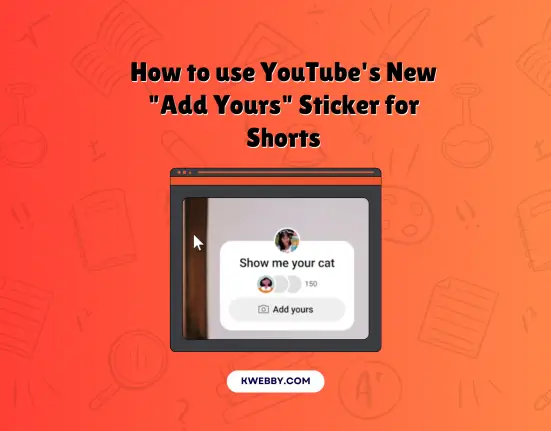
How to use YouTube’s New “Add Yours” Sticker

How to Embed YouTube Video in WordPress (4

How to change YouTube view Categories of your

How to download PDF to mobile (iPhone and

How to minimize YouTube on mobile (iPhone and

28 Ideas On How To Make Homework Fun For Students

Do your children seem to need continual nagging to complete their homework? If your answer is “yes,” then don’t worry; we’ve all been there. Parents naturally want their kids to advance and do well in class, but after a full day of paper, pens, and books, many students won’t feel like doing their assignments.
No matter what the ages or grades of the students are, academic burnout may happen to any student, which affects overall learning and development. To solve this issue, we have brought 28 ideas on how to make homework fun and interesting for students of any age. Not only for parents but also if you are a tutor, these tricks and tips will come to your use.
28 Ideas on How To Make Homework Fun for Students
Homework enables the students to revise and evaluate the classroom learning and develops a habit of self-study, which in turn helps the students to score better. But it can be energy-draining, challenging, monotonous, and difficult to focus upon for students of any age.
Getting students to enjoy their homework and assignments could be immensely difficult at times. Especially after a long break or vacation, they find it difficult to focus on homework. Simultaneously, the importance of home tasks cannot be ignored. Wondering what the solution is?
It’s easy – why not make the homework fun and engaging? Yes, this is the ALL-IN-ONE solution to create a spark of interest in homework. There is practically a plethora of ways to let students feel enthusiastic while doing homework. However, not every strategy suits every student.
For instance, some students love to go outdoors and complete their homework or study amidst nature. On the other hand, some students simply want to stay indoors and complete home tasks in their study area.
So, while implementing a strategy or adopting ways to make homework fun and interesting, you must make sure you are doing the right thing for the right individual so that the student receives maximum benefits.
Here are 28 brilliant ideas that will guide you on how to make homework fun for elementary, middle, and high schoolers. Take a look:
Try Clarifi for Free
1. rewards are magical motivators.
It’s nothing new to provide children with little rewards in the classroom. But when it comes to the concept of homework for students, these approaches are rarely used. Instructors aren’t always aware of what’s offered or if it’s useful, and some parents may create their rewards. A great idea is to offer rewards inside the classroom.
Giving out vouchers, stickers, snacks, toys, or meal coupons that let youngsters earn money by doing their homework is something we advocate. The advantages of these magical motivators include having a friend sitting next to you in class, access to the internet, and unscheduled time in the classroom. If they link accomplishing their tasks to positive classroom experiences, students will be more engaged and motivated both inside and outside of the classroom.
2. Get Some Favorite Snacks
How to make homework fun and captivating? Let’s face the truth: A hungry student will be disinterested, uninspired, and miserable. Give them something healthful and palpable to eat while they do their schoolwork because most young kids are ravenous when they get home from school. Some options are apple slices, popcorn, grapes, crackers, flapjacks, and cheese.
If you want to attempt something a little more systematic, make a list of nutritious after-school snack suggestions and recipes and try them out every day. A delicious, crunchy apple is one of the healthiest nutrients for youngsters’ brain development. Some other nutritious and palpable snacks for students are Pancakes, Butter Popcorn, Fruit-flavored Yogurt, nut mix, sliced pears with ricotta cheese, Banana Smoothies, etc.
3. Beat the Clock
This is perfect for young kids who are reluctant to complete their schoolwork. Try it out, and you’ll thank us later. Young children like competing in races. By creating timed tasks, you may make schoolwork feel more like a race. For instance, keep track of the number of words they can spell properly or the number of arithmetic problems they can do in five minutes. Challenge your child to beat their previous best the next day.
To make it more fun, a little competition with siblings or best friends will work great. Nevertheless, make sure that the competition is healthy and doesn’t turn into an aggressive one. Often, students’ psychology works differently, and they tend to be violent in these kinds of situations.
4. Get A Homework Buddy
Allow your child to have a buddy or two over to study if they struggle with a particular topic or have difficulties concentrating in a quiet, empty room. If a second child is too distracting, set an example by helping your youngster. You may pay bills, prepare supper, respond to emails, or even work on a crossword puzzle or other mental exercise while they are doing their schoolwork.
Working on homework teaches children that work is a part of life, not just school, and fosters friendship without being overpowering.
5. Design an Awesome Workspace
Improve the area where your kids complete their schoolwork to increase efficiency, creativity, and problem-solving abilities. Have tools and materials available, such as cool notepads or notebooks, colored pens, highlighters, and sticky notes, to assist students in completing difficult projects.
Use calendars, whiteboards, chalkboards, corkboards, or even simply paper and tape to help them visualize and keep track of all they need to complete. You may also decorate it with art and other items that inspire you. For pupils older than 5 years old, you may also hang up some aesthetically pleasing motivating quotations and photos in their study space to help them stay focused and goal-oriented.
6. Make Them Feel Comfortable
The comfort level of the students is the first and foremost thing you have to take care of while making them complete their homework. Not every learner has the same comfort level in the same ways, and these levels tend to differ from one person to another. It’s the responsibility of a parent or a teacher to understand their comfort zone and then plan accordingly.
For instance, provide them with a variety of alternatives or let them design their strategy. You might also inquire as to what time they like to complete their assignment. You won’t need to repeatedly remind people of their duties if you reach an agreement.
7. Incorporate Intervals and Breaks
Some learners might be able to finish their entire load of homework in one sitting. If your class has any pupils that can’t sit still, think about introducing breaks into the assignment process. Weekly study regimens can accommodate breaks.
Give a food break, allow them to complete one level of a video game, or let them talk to a buddy during a quick break. To establish expectations for when and how homework breaks should be taken, teachers might talk about these concepts with parents and students.
This functions in two main ways. It first rewards pupils for finishing their schoolwork. In addition, it gives them a mental break so they can come back to their job reenergized and motivated.
8. Role Plays Work Wonders
Create your little school and let your youngster take the role of the instructor to make enjoyable learning-based games. Assume the position of the student, and have your youngster explain a concept to you in the teacher’s role. This game will help players better comprehend the topic and develop their logical and reasoning abilities. It works especially well with courses that call for theory, like science.
By letting your kid pick their favorite stuffed animals and playthings and placing them in their little classroom, you can make schoolwork enjoyable. Begin by registering, saying “mummy,” “gift,” “Mr. Teddy,” etc. Since kids love to pretend to be teachers, you’ll soon notice that your kid is becoming more self-assured.
9. Make Them Stay Positive and Focused
Ensure to keep the students’ attitudes toward school and the values of their schoolwork are always positive. To keep them inspired and on track, shower your youngster with compliments on how great they’re doing. If they are getting pissed off with the pressure of homework, make them understand its importance and how positively it can impact their learning.
Spend five minutes after each homework session going over your child’s accomplishments. Have a look at our selection of free-to-download home learning packs if you’re out of things to do. To keep them motivated, you can reward or recognize their achievements in front of their peers. This will not only boost their confidence but also will help them maintain a positive outlook toward homework and studies.
10. Take It Outside
Outdoor learning is one of the most feasible ways to do homework with fun in a natural environment. If the weather is good, create a cozy and safe study space outside and let the student finish all the homework outdoors.
Studies also demonstrate that being outside, nearer to nature enhances productivity. The fresh air can aid students’ attention if they have spent the entire day in a classroom. In between jobs, rewarding them with a brief game of football or Frisbee will keep them engaged. You can conduct some fun outdoor Math or English fun homework activities.
11. Altering the homework concept
Many kids feel burdened by their homework assignments. What if, though, you adopt a whole new approach to homework? It can be argued that schoolwork has a lot of unfavorable associations. These concepts usually start early in life and persist into college.
By referring to assignments in different ways, teachers can change these mental habits. Better ways to describe homework include home learning, brain workouts, and study time. You might try using these phrases in place of homework in the classroom.
12. Get Help If You Need
Homework can be frustrating if your child doesn’t understand the material or gets bored easily. Furthermore, excessive pressurizing or insisting on too much can mess up the student’s psychology. To be honest, in extreme cases, none of the methods will work. If your child or student is struggling beyond the normal limit, get them some expert help!
Education Advisors have plenty of advice for students who are not able to cope with homework. They also conduct counseling sessions from time to time in case it’s required.
13. Go for Audio-Visual Resources
Engaging additional senses in the at-home learning process is another technique to cheer up your boring assignments. Focus may be improved by using a child’s perception of touch, smell, or taste in a unique manner.
Sending kids home with instructions for making scented play dough, for instance, improve learning. The dough may be used in classes including math and spatial concepts. Plus, the aroma of scented/colored clays keeps kids focused while they work. Additionally, it enables children to link the smell to what they learned, improving memory and recall.
Another item that teachers might give their pupils as a take-home is a stress ball. Before, during, or after tasks, using a stress ball can encourage creative thinking and anxiety reduction positively.
14. Meditation Can Reduce Stress
Stress is not something that happens only to adults. With the increased competition in academics, young learners nowadays are suffering from severe stress, which ushers’ negative impacts on their mental health. Sometimes, both the little children and older students can’t express this stress and fail to explain how they are feeling.
Homework pressure often creates such challenging situations which disrupt the emotional equilibrium of youngsters. In situations like this, meditation can reduce stress and improve focus. Positive thinking, fear and the tension and anxiety that lead to depression may all be lessened by meditation. Being aware without judgment is one of the foundational elements of meditation, and this attitude of acceptance may ward against unpleasant thoughts.
15. Make It a Group Effort
Since time immemorial, team working is super effective for any activity. The same applies to homework as well. If students sit for the home task in a group, they will be able to wrap all the assignments up quickly.
Now the question is – how? Teamwork involves group discussions as well as brainstorming, which gives rise to new ideas. Students try to develop new ways to complete homework through mutual discussion.
16. Take Help from Learning Apps and Libraries
If your child struggles with their homework, it can be difficult for you as well. Games and visual examples in amusing math practice applications may be a terrific way to give your youngster practice with things he is having trouble with. Therefore, make schoolwork enjoyable for your youngster by downloading an app that simplifies the subject.
There are so many online applications and libraries that will help students enjoy fun and encouraging homework sessions. If the toddler or an older student specifically refers to a particular app or a website, talk to him/her about it properly. Then visit the online resource, and if you think it is a legit and helpful one, let your child or student use it during his/her homework time.
17. Tell Them Not to Take It Too Seriously
There are more important things in life than homework and grades. Too much focus on grades can affect your child’s love for learning. Think about what values you want to instill in your child and make sure the homework is not getting in the way.
If you believe your child’s teacher is giving out too much homework after you see your child demonstrate an understanding of the subject, don’t be afraid to voice your concern. Even if nothing changes, it will show your children that you care and empathize with them. That matters a lot!
18. Storytelling Can Be a Great Idea
Storytelling is a fantastic idea to make children complete their homework without facing any boredom. Especially for specific subjects like Math, History, and Literature, storytelling develops a context that allows the students to grasp things very easily.
If you find a student is finding it difficult to understand a concept and complete assignments on it, you can give a try to the storytelling method a since it works well. Storytelling has the power to captivate learners and keep them engaged irrespective of their age and grades.
19. Create A Homework Mood
Creating a mood for homework is a bit difficult for younger students but setting the right environment can help them complete the tasks as quickly as possible. However, it’s not an issue for the senior students but can be a bit overwhelming for the little kids.
You can select a comfortable location for them to study and use their favorite stickers, lights, etc., to decorate the space. Keeping in mind the results as well as their abilities to take the pressure, set goals and establish rewards. It’s vital to make them understand the goals and disclose a bit about the rewards but don’t let them know exactly what’s going to happen. This will create an enthusiasm to complete the homework in no time.
20. Turn on Some Music
The psychological effects of music are undeniable. Music brings concentration and helps to focus on a particular work pleasantly. Then why not use it for your children’s homework? Science dictates that music is the best aid for studying.
Play some soft music while the student is doing his/her homework and this will help to create an ambiance. You can also play cool, energetic, upbeat music since it radiates energetic vibes and the student will find immense energy as well as positivity to complete the tasks.
21. Ask Them to Do the Tough Tasks First
One more cool thing to try out is doing the tough tasks first. It’s a perfect strategy if the student has a list of various tasks of different levels of complexity. You will be able to realize how much time he/she needs to complete the tasks and edit afterward if needed.
Completing the more complex tasks at first enables a student to think and decide critically. The remaining time can be enjoyed with much lower stress while doing the easier assignments. If your child gets bored very quickly you can try this method out.
22. Get Creative
Wondering how to make homework fun creatively? Homework doesn’t sound exciting to students. To be more specific, solving sums after sums or writing science projects doesn’t sound fun alone. Rather, if you mingle these tasks with an artsy adventure, the same old boring homework sessions become interesting.
For instance, you can ask them to paint out the math problems, prepare a model for their science projects, or act a portion of the history or literature books. Some other effective ideas may include creating a range of paintings while explaining a paragraph to a child, making clay characters, and doing some moves with the music.
23. Doing Homework at School
Nowadays, as the syllabuses are changing, students have too much pressure from homework to deal with. After coming home from school, it’s quite natural for them to feel exhausted. At times it becomes impossible for a kid to keep their eyes open for homework.
The best remedy here is to complete the majority of their homework at school. Your child also doesn’t have to stay up all night looking for answers or trying to understand how to remember academic facts. They can use their free time at school to complete some of the homework to stay relaxed later. Also, completing homework with peers involves so much engagement and fun.
24. Ask Them to Work on Different Subjects in a Session
Are you trying to know how to make homework fun without putting in much effort? Plan a routine for your child so that they can work on different subjects in a single session. Try to mix and match the subjects to make them feel comfortable with the pace of the study.
Working on a maximum of 3 subjects a session will help a student to get rid of the homework quickly without considering it as a pressure. Ensure they are not in a rush to complete one subject after another. Make it as systematic and orderly as you can to avoid any unwanted confusion.
25. Get Academic Help
Getting a little homework help is a feasible way to make homework fun. Nevertheless, you must make sure that none of you, the teachers, or the program facilitators are not spoon-feeding them, or else it will affect the student’s development in terms of learning.
If there is a math problem that is too difficult to solve or a paragraph with heavy words, you or the tutor can give your helping hand to the student so that he/she can complete it on his/her own. For instance, you can give a clue to solve the sum or narrate the context of the paragraph.
26. Planning Is the Key
Planning is a powerful habit to make homework sessions fun and organized. Not only at school, but also this habit will help a student throughout his/her life. It’s required for a student to be extremely serious about homework in a studying period and systematic planning can help in completing all the assignments on time.
If your child is in high school or middle school, you can guide him/her to make homework routines. However, elementary school kids and preschool students need their parents’ or teachers’ assistance to make advanced homework plans.
27. Ask Them to Write on Their Favorite Topics
Working on something you love will make you feel more connected to the work. The same applies to both the kids’ homework and older students’ homework. If you are thinking about how to make doing homework fun, you can ask them to write a paragraph or a short essay on their favorite topics.
To implement this strategy, first, talk to the students on a one-on-one basis and try to know their individual preferences in terms of writing. Then assign them a task where they will write whatever they want on their favorite topics. This will act as a warm-up session before doing the homework.
28. Provide Choice
One of the key reasons why younger and older students become disengaged with their homework is they find it meaningless. This is where the mentors and the parents have to play the biggest role. They need to make the student understand why homework is important and how it can benefit them in the future.
This will make the kids’ homework sessions more engaging and they will be able to connect emotionally or personally. How to make homework fun in this way? It’s simple, provide the students with more choices while assigning the homework. For instance, if there is a tough project, they can choose to work alone on it or work with partners.
Contact Us Now
Elementary school homework tips.
Homework gives elementary students a way to practice the concepts. But you have to be very careful while making them do the home tasks as at this age they don’t develop an understanding regarding the benefits of homework. To them, homework is just something that parents and teachers use to restrict them from doing what they want.
Below are some effective tips on how to make homework fun for kindergarten students.
- Make sure kids have a creative, engaging, and well-lit place to do the homework.
- Give the kids delicious snacks from time to time so that they don’t get distracted due to hunger.
- Encourage the children to complete their homework by giving them small rewards or recognizing their efforts to make the entire process more manageable.
- Instead of dictating to them what to do and threatening them, be a mentor, a leader, and a motivator.
- Create a homework routine for elementary students manually or use desktop app for planning your homework. Don’t forget to keep short breaks in between.
- Try to keep distractions to a minimum. This means no phone calls, loud music, and TV during homework time.
Set good examples for them but without comparing them with anybody. Have you ever seen your little one saving money? Point that quality out, praise him/her for it, and set it as an example.
Middle School Homework Tips
Middle school students develop a fair understanding of the importance of homework. So, you are not supposed to face much trouble to make them complete their tasks. Check out these middle school homework tips below. These tips will work wonders if you are looking for ways to make homework fun for 7th graders or 8th graders.
- Designate a specific amount of time for homework. This will help them to complete work on time.
- Help them prioritize which tasks to do on a priority basis. In this way, they will develop the ability to make decisions.
- Continuously encourage them to evaluate their work so that they can find the mistakes and correct them on their own.
- Put away the phone to prevent them from being distracted from time to time.
- When needed, help them to complete homework instead of spoon-feeding the whole thing. Give clues to solve a sum, point out some important areas, or explain them in a paragraph so that they can complete the next tasks by themselves.
- Don’t pressurize or force yourself to do homework. Parents need to know when to stop, especially when they are feeling exhausted, frustrated, and confused.
High School Homework Tips
When it comes to homework, high school students are better able to manage their time, stay focused and finish their tasks. This enables them to understand the value of homework. They don’t do any tantrums and get less distracted because they understand the consequences of not completing home tasks on time. But if you want to know how to make homework more enjoyable for high school students throughout the school year, here are some effective tips:
- Tell them to write down their homework every day in a notebook, or a planner to keep it more organized.
- Ask them to write their homework with a blue pen on a white sheet to remember their writing. Also, it’s the best combo to do homework faster.
- Help your teens to divide their homework schedule in a planned way and keep short breaks to freshen up their minds. For instance, if they work for 30 minutes, they can take a 5 minutes break.
- Doing homework with buddies is a proven method to complete homework on time and also in an accurate manner.
- If they get stuck while doing any specific homework, ask them to take help from online resources, libraries, video demonstrations, and journals.
Homework Dos and Don’ts
Let’s face it – nobody loves homework although it’s super important for your child’s learning and development. While high school students understand the importance and need of doing school assignments at home, elementary and preschool children can’t develop the understanding at their age.
Several things are to be kept in mind while expecting homework from students in proper time. To make the students complete their homework happily, we have brought some amazing dos and don’ts that parents or teachers need to follow:
Homework Do’s
1. monitor the answers.
After your child has completed his/her homework, check it once to find what went right and what went wrong. If you find any mistake in his/her work, try not to point that out directly. Instead, give your youngster clues so that he/she can find out the mistakes now.
2. Remove the Distractions
Thinking about how to make homework more fun for your child? Remove the distractions from the study room first including social media on the computer, mobile phones, unnecessary toys, etc. Remember, a decluttered environment is the reason behind a decluttered head. They will be able to focus more on the homework when there isn’t a pile of distractions around them.
3. Be A Cheerleader
Always be your child’s motivator when he/she is doing homework. Students may not be correct always but humiliating them may make them demotivated and frustrated at the same time. Celebrate small successes such as completion of the tasks within time, the maximum number of correct answers, the maximum time the child has devoted to homework, etc. Give treats like candies, stickers, pens/pencils, and colored boxes to celebrate their success.
4. Work in Collaboration
The parents and the children need to work together in terms of homework. There must be a proper channel of communication between both parties so that the child’s overall performance can be monitored.
Homework Don’ts
1. don’t force them to homework.
Forcing a student to do the homework can bring immensely negative results. Children won’t like homework – it’s quite normal but forcefully making them do it is tremendously fatal as it will develop a permanent fear or discomfort that will hamper their overall growth.
2. Don’t Show Them Your Frustration
Kids have a lot of tantrums. Especially, the tantrums increase while doing homework. Often teachers and parents get frustrated but showing them the frustration is not at all a good idea. Not only will the child become stubborn but also, they will develop a fear of doing assignments or getting help from you. If you want to make homework fun for 6th graders or students of any other grades, don’t show your frustration in front of them.
3. Don’t Compare with Their Peers
Comparison is something that demotivates a child to a great extent. It develops a deep resentment in their mind which doesn’t fade away even after growing older. Comparing their grades or skills with their peers is probably the worst idea to make students do homework.
4. Don’t Keep Electronic Devices in Front of Them
Yes, you can give the students electronic gadgets for a few minutes as small rewards but don’t keep the devices in front of them all the time when they are doing homework. This may loosen their concentration and will make them distracted from their respective tasks.
How A Homework Planning App Can Help a Student?
A homework app is the best time-management tool that enables students to organize everything they need to do throughout a week, month, academic year, or semester. It’s an easy way to keep your homework sessions organized. In case you are still thinking about how to make homework fun for your child, software with proper features of homework planning can help him/her out.
The academic pressure on school children sometimes becomes too difficult to handle, especially when there is so much to do. This is where student planners for their home assignments are found to be beneficial. Here is an explanation of how an efficient home assignment planning tool can help students finish their tasks on time:
1. Gives Students A Break
It might also be helpful to make sure that kids have some downtime to unwind and not become overburdened with assignments. If teachers are assigning homework through software, they will see how long a piece of homework will take to be completed, and they can allocate the tasks accordingly scheduling breaks in between.
2. Reduces Stress
Homework pressure may not sound like a big deal to you because you have already left those days behind but to your child, it’s a headache. The fear of being scolded by parents/teachers is one of their biggest concerns to them. Thanks to digital planners, these tools know exactly how to help each student in a customized way.
3. Increases Productivity
How to make homework interesting? Students who use a school planner are more productive and can manage their time more effectively. Students today struggle with procrastination because the internet age offers so many diversions. However, if they have noted down the tasks they must complete, they will be more motivated to complete them.
4. Easier for Parents and Teachers
A homework app with intuitive features of planning helps to complete an assignment within time in a systematic manner. Younger students who still rely on the help of their parents and teachers to do their schoolwork often fail to inform them about their homework status. Having homework software can easily sort this problem out and reduces mentors’ work and hassle.
Our Product
How to make homework fun with clarifi.
To assist students to achieve their highest potential, Clarifi is a homework software that acts as an ideal digital homework attention coach. We are dedicated to helping students achieve their academic goals. The pupils may complete their homework independently with the help of this digital planning app for homework.
It is a straightforward and uncomplicated desktop program that gives them more confidence to finish their assignment as quickly and effectively as possible. It is the only research-backed desktop application that enables children who are easily distracted to do their schoolwork without a parent watching over them. Monitoring student behavior is the only way to be sure they are doing their assignments.
However, keeping track of pupils’ activity is a time-consuming and important duty. However, Clarifi is available to make this procedure as easy as possible. With the aid of this program, students can effortlessly enter each homework assignment and keep track of the due dates for each one based on the class or the current day.
They receive prizes from the automated coach for maintaining concentration and doing their homework. When all pupils turn in their schoolwork on time, they will receive diamonds as a reward. This element motivates pupils to develop the positive habit of finishing their home assignments on time. Clarifi is an easy digital homework attention planner that provides kids with the ability to filter out distractions, improve their executive functioning, and keep all of their assignments organized in one location.
Clarifi guarantees to raise their capacity for concentration and focus as well as their academic performance. It incorporates functions that provide users the means to remain centered, motivated, and organized while finishing their schoolwork on their own. When kids use the app, it is specially designed with cutting-edge technology that blocks all other apps.
Generating an undistracted and focused environment for students with Clarifi is the answer to “how to make homework less boring.”
Students Can Now Complete Homework with Fun!
With these tricks and tips, students can now efficiently engage themselves in homework. Learners need to study and complete their homework/assignments with a positive mindset and not forcefully. As soon as a student starts doing his/her homework strenuously, the interest is eventually lost, leading to mistakes and burnout.
But with the tricks mentioned above, homework sessions can now be immensely fun and interesting. Whether you are a teacher, parent, or student, these are some tried and tested ways to complete home tasks engagingly. Stay tuned to Clarifi for similar informative blogs like this. If to need help with your children’s homework and know more about how to make homework fun get in touch with Clarifi today.
Latest Post
DECEMBER 20, 2022
21 benefits of technology...

DECEMBER 6, 2022
18 adhd parenting tips...

NOVEMBER 15, 2022
28 ideas on how.., related articles.

Best Homework Planner To Strengthen..
General email.
Copyright © 2024 Clarifi Education PBC. All rights reserved. Privacy Policy . Terms and Conditions .

- All topics A-Z
- Grammar
- Vocabulary
- Speaking
- Reading
- Listening
- Writing
- Pronunciation
- Virtual Classroom
- Worksheets by season
- 600 Creative Writing Prompts
- Warmers, fillers & ice-breakers
- Coloring pages to print
- Flashcards
- Classroom management worksheets
- Emergency worksheets
- Revision worksheets
- Resources we recommend
Local columns

Subscribe TodayMov parent: time management for school homework assignments.  (Photo Illustration/MetroCreative) I feel a strong need to discuss the significance of homework. There is nothing that irritates a teacher more than students who procrastinate completing their homework assignments. Throughout the remainder of this writing, I will offer ideas for doing homework. I am writing it specifically for students; therefore, it is imperative that parents share this important information with their school-aged children. Now let’s begin with the following athletic analogy. Coaches, first and foremost, want all their players to gain positive experiences from athletics. To accomplish this goal, the participants need to be as committed as their coaches. A major part of that dedication includes hours upon hours of drills. Although the majority of athletes hate drill work, they know that to be successful in their sport, it is a very necessary evil. As with athletics, the same is true with the academic realm as well. But in the case of studies, it is known as that dreaded activity referred to as “homework.” The key to proper homework preparation is “time management.” Many students do not know how to wisely organize their daily studying routine. Hence, homework is either turned in late or never completed. Furthermore, such problems can lead to student anxiety and feelings of always being in a rush. What I want to share with you from this point on are some helpful hints for homework. Likewise, I also devised a generic time schedule for “after school” study habits. Helpful Homework Hints 1. Try to eliminate dead hours. Accomplish something every free moment of the day. Research has demonstrated that an hour of daytime study is worth an hour and a half of studying at night. 2. Always allow enough time to eat good, nutritious meals. As they say, “You are what you eat.” 3. Do not follow a schedule that could cause lack of proper sleep. All evidence supports the importance of acquiring the basic eight hours of sleep a day. 4. Determine how much time you really need to study each subject area, and develop your homework schedule accordingly. 5. When you are faced with lengthy homework projects, double the time you think it will take and start early. Keep in mind, big assignments always take longer than you originally expected. 6. During the day, look for small blocks of time in which you can get minor tasks accomplished. For example, if you take a school bus to and from school, you could be reading a chapter in one of your textbooks at these times. 7. Always schedule your most difficult homework during a time of the day when you feel totally alert. This time will vary from student to student. 8. When studying at home, select a homework site with no distractions. You can’t learn when the television is on or family members are having discussions near your study area. Generic Time Schedule for After School Hours * 3:30 p.m. to 5:30 p.m. – Recreational or Sports Practice Time. * 5:30 p.m. to 6:00 p.m. – Chore Time, etc. * 6:00 p.m. to 7:00 p.m. – Evening Meal. * 7:00 p.m. to 9:00 p.m. – Homework Time. (Note: Allow 10 minutes of each hour for a study break.) * 9:00 p.m. to 10:00 p.m. – Recreational Time for Watching Television, Calling or Texting Friends, etc. * 10:00 p.m. – Bedtime To be quite honest, at first you can anticipate having some difficulty putting together a daily time schedule for homework and other activities. Here is where parents can assist their child, having more lifetime experiences in organizing their personal and professional affairs. Moreover, please realize that your child’s schedule may need to be revised or adjusted from time to time. I have one final tip for students who take their schooling seriously. Even if you are not sure how to complete a homework assignment for a certain class, always hand something in when it’s due – be it right or wrong. Believe me, this is very sound advice from my own educational experiences. With the above approach to studying, all your teachers will realize that you have made sincere efforts to perform homework assignments. Likewise, should a completed homework paper be incorrect, your teacher will know where you are having learning problems. Thus, your teacher will be able to guide you toward better understanding of the material being taught. On the other hand, when students fail to hand in homework assignments, their teachers will think they don’t care, and nothing can be learned by anyone. Hence, the bottom line is: “Do Your Homework!” Bill Welker, EdD, is an educator who has 40 years of experience as a K12 classroom teacher in both public and private schools. He was the recipient of the prestigious “Jasper N. Deahl Award” from West Virginia University for his accomplishments as a certified reading specialist. Today's breaking news and more in your inbox
 Backyard Gardener: Sedum – beautiful, low-maintenance plant for the landscape MOV Parent: Should schools ban cell phones? Senior Legal Aid can help provide solutionsBy Deb Miller West Virginia Senior Legal Aid A recent call to West Virginia Senior Legal Aid was from Charlie. ... Legal-Ease: ‘Do I need a trust?’About 20 years ago newspapers had advertisements placed by non-lawyers, advising, “Everybody Needs a ...  Reporter’s Notebook: Empty pocketsStarting at $2.99/week.. The Alien Movies Have a Long History of Recycling Rejected IdeasAlien evolution: these deleted concepts and scenes eventually made their way into the sequels..  Warning: Spoilers follow for Alien: Romulus. The Alien franchise has had a round robin of amazing creatives over its storied 45-year history, so there should be little surprise that a few brilliant ideas fell through the cracks, such as Vincent Ward's sadly aborted version of Alien 3 which took place in a floating wooden gothic monastery in space, or Neill Blomkamp's abandoned Alien 5, which would have brought back Ripley, Hicks, and Newt in a fan-service smorgasbord. Even on the films that were made, there was often a surplus of ideas discarded for creative or budgetary reasons. Some of these cool concepts were eventually carried over into later films, including the latest entry in the series, Alien: Romulus . Whether the filmmakers were intentionally cannibalizing the surplus imagination of previous IP caretakers or just happened to come up with similar notions is up for debate, but what's not are the many deleted concepts and scenes which were utilized in subsequent Alien entries. Here is a (likely incomplete) list of some of those ideas. And remember… Reduce, Reuse, Recycle. And one more time for the cheap seats: Spoilers follow for Alien: Romulus! The Alien Movies' Long History of Recycling Rejected Ideas Ridley Scott actually shot a roughly two-minute scene for Alien (later incorporated into the Director's Cut in truncated form) in which, during the climax aboard the Nostromo, Ripley discovers a dead Brett and a cocooned, half-dead Captain Dallas embedded in the wall of the ship by alien resin as they are slowly turned into alien eggs. Dallas is only able to quietly beg "kill me" to Ripley before she torches him and Brett with her flamethrower. This process, called "Eggmorphing," was Scott's explanation of how the vessels containing the facehuggers were created. When it came time to do Aliens, James Cameron – who knew the first film very well - incorporated a similar scene when the marines stumble upon a cocooned female colonist in the Atmosphere Processing Plant, still alive but begging the soldiers to "kill me." However, he simplified the cocooning to merely being a way for the aliens to imprison the humans for facehugger implantation. We later see Newt in similar dire straights but prior to implantation. The idea of Eggmorphing was abandoned, perhaps rightly so. "What this suggested was that once an individual was cocooned by an alien, that individual then became an alien egg – which I thought was a stupid concept then, and a stupid concept now," opines James Cameron in J.W. Rinzler's The Making of Aliens . "That's something that would have been hard for the audience to swallow, because it involved the transformation of the human host. So I went in a totally different direction: I determined that the eggs were actually being laid by a single, more highly-evolved alien organism. A queen, if you will." Which of these concepts worked best once it made it into one of the Alien movies?While the eggs were found by the crew of the Nostromo in the belly of the derelict ship, the original plan in Dan O'Bannon's screenplay was for them to be inside a large round structure called the Egg Silo or pyramid. While the outside of these structures are visually akin to the buildings found by the crew of the Prometheus, the interior was visualized by artist Ron Cobb as being similar to Aztec pyramids , which was something that Paul W.S. Anderson reworked into the pyramid structures below Antarctica where most of the action in AVP takes place. Said Scott in The Book of Alien , "The pyramid and the Derelict - two different elements - were still the subject of a seesaw debate when I came onto the project. I would love to have shot it, but the more I thought about it the more I realized it would have been wonderful in a three-hour version. What finally cracked it was the budget. We just had to get rid of it. And you know, sometimes financial practicalities force you to do a certain amount of editorial work, and I'm glad we simplified it." Interestingly, Cobb's initial designs for the Nostromo also bear a striking resemblance to the ship in Prometheus, with the glass-domed segmented cockpits and large bridge interior. Those early paintings depict a much sleeker ship than the more utilitarian one Cobb ultimately designed for the first movie. Ridley Scott's incredibly detailed initial storyboards (referred to affectionately as Ridleygrams) for Alien visualized all sorts of incredible possibilities, some of which didn't make it into the movie for various reasons. One was the "flying mice" which would have been seen at the start of the film before the crew woke up. Scott told Fantastic Films in 1979, "I wanted to have small flying objects, like sensors, which flew up and down the corridors. They would find a problem, stop by a computer bank and fix it like little handymen. I wanted to call them 'Mice.' At the beginning of the film they would be the only things that were alive on the ship. We'd have shot a long empty corridor so you'd hear them coming before you actually saw them. Then WHOOSH! It would pass by the camera, going through the corridor. I think Fox felt it was too much in the direction of sci-fi, and we dropped it." A similar gadget eventually found its way into Prometheus as the geologist Fifield's flying mapping balls which he calls "pups." While not functioning like the mice in Scott's original boards, they certainly share a similar visual feel and animal nickname. One of the most frightening death scenes in Alien was Lambert’s, which occurs mostly off-screen directly following a suggestive shot of the alien's tail near her nether regions. The ensuing sounds imply a kind of rape/death that is perhaps one of the most disturbing aspects of the film. While a clever way to do a lot with a little, Ridley Scott had a much more elaborate ending in mind for Lambert. “Because of budget reasons and time we just couldn’t shoot it, but I wanted Lambert to get sucked out of the ship through an opening about the size of a keyhole," said Scott to Cinefantastique Online . "Not a very heroic ending – but dramatic. We couldn’t afford it. Besides, I couldn’t work out in those days how to squeeze a body through a hole that big.” This idea was eventually carried forth rather effectively in the climax of Alien: Resurrection, in which director Jean-Pierre Jeunet had the alien/human hybrid known as the Newborn get sucked out of the Betty through a tiny hole in a port window. It's incredibly graphic, a combination of CGI and gruesome makeup effects, and perhaps one of the most memorable moments in that fourth film. Thanks, Ridley! The 15 Best Deaths in the Alien Movies While Ripley's triumph at the end of Alien is very well-earned, there was an alternate ending storyboarded for the film which would have made for a much more kinetic ride. In the movie, the creature gets blasted out of the airlock while Ripley is secured in her chair, but originally the filmmakers wanted her to be attached to a cable tethering her to the ship while she briefly struggled with the alien in space, shooting it in the head and – once she gets back onboard the ship - blasting it with the ship's thrusters. Scott was able to do a similar sequence in Covenant in which our hero Daniels fights a xenomorph with a gun while tethered to the flying cargo lift. However, Alien: Romulus has a climactic scene which mirrors Scott's original planned ending with the hero tethered to the ship much more closely, while adding other elements of danger including an approaching planetary ring that will pulverize the ship. A sequel to the original Alien was slowly simmering at 20th Century Fox for years due to a profit participation lawsuit against the studio from the three original producers: Gordon Carroll, David Giler, and Walter Hill (a.k.a. Brandywine Productions). Once the lawsuit was settled, Hill and Giler hatched a very short pitch for Alien II which is fairly close to the movie James Cameron ultimately wrote, with Ripley waking up from hypersleep, joining space marines on a trip back to LV-426 to check on colonists, the ensuing battle and destruction of the alien hive, etc. A few elements of this pitch were not realized, including the marines storming the derelict ship to destroy the eggs, but this was the most interesting discarded idea (via The Making of Aliens): "Maybe they should discover something on the spaceship left from the dental patient [space jockey] that tells them something about the alien and its potential menace to all other living forms. That it's an anti-life force. Some bullshit." While Cameron ultimately left this "bullshit" unexplored in Aliens, it must have clearly intrigued original director Ridley Scott since the idea that the xenomorph was born out of an attempt to wipe out whole species was carried over wholesale into his 2012 prequel Prometheus. In that movie, the crew of the title ship discover that there are vials of a black substance developed by a species called the Engineers to wipe out the human race on Earth… a race that was hatched by them to begin with. In Scott's next film Covenant, we get to see this black gunk in action as the android David returns to what seems to be the Engineer world and wipes them all out rather gruesomely. He then spends years perfecting the substance into the lifecycle of the xenomorph we all know and love. That black goo also makes an important appearance in Romulus, where it is referred to as the "Prometheus particle" (or something to that effect) but its result is less cut-and-dry and does not produce the same squid-type offspring (the Trilobite) as it did with Shaw in Prometheus. In 1987, famous cyberpunk author William Gibson of Neuromancer fame was hired by Brandywine to develop a screenplay that would follow the events of Aliens. This script sidelined Ripley to her cryotube as Hicks and Bishop battle aliens aboard a scientific research space station called Anchorpoint. Once scientists get ahold of alien tissue that's been planted inside Bishop, the powers that be at Weyland-Yutani order them to begin experimenting on it, which leads to the cloning and genetic altering of xenomorph DNA. An airborne alien contagion follows which causes one of the lab's employees to shed her skin and transform into a human/alien hybrid. In Alien: Covenant, members of the title ship's crew release a similar powder-like contagion from pods planted like mines on the planet which, when inhaled, eventually lead to small Neomorphs (also known as "bodybursters") emerging from them via the mouth or the back. Although the only Gibson contribution which made it to the screen in David Fincher's Alien 3 was the idea of barcodes tattooed on the prisoner's heads, it's cool to see some of his ideas carried forth in later films and games. His script was also directly adapted into a Dark Horse comic book as well as a novelization, the audiobook of which stars Michael Biehn and Lance Henriksen… so it's practically been made! How Are Alien and Blade Runner Connected? While Alien 3 would run with the idea that a facehugger can implant any warm-blooded animal by having the creature born from a dog (an ox in the assembly cut), Eric Red's unproduced script had a whole menagerie of hybrid creatures, including a chicken, thanks to its setting of a farm on a space station. It also contains a character named John who transforms into an alien/human hybrid, which foreshadows the much-maligned Newborn in Alien: Resurrection. Alien: Romulus takes the idea of a hybrid one step further by having the genetically altered black goo transform Kay's in-utero baby into a swiftly born alien/human hybrid which resembles the Engineers of the prequels as well as the xenomorph. Looking more human than xeno, this version of the hybrid is much more effective and frightening than Resurrection's Newborn. There were many planned endings developed by writer Joss Whedon for Alien: Resurrection, including a climactic fight with the Newborn on Earth which took place in a desert location, then through a spaceship graveyard, then finally a snowy forest as Ripley 8 chases down the creature before it's finally destroyed by Winona Ryder’s Call driving a harvester. Part of this sequence was even shot, including the final conversation between between Ripley 8 and Call which ends the Special Edition cut on the Blu-ray, although the snowy backdrop it was shot against was replaced digitally with a ravaged future Paris. Having a battle in the snow with an alien wound up becoming the climax of the next film in the series, AVP: Alien vs. Predator, in which Alexa and the predator Scar are chased through a snowy rural village by an alien queen before she is ultimately defeated. It is one of the few scenes where AVP really comes to life, and might have worked better in the context of Resurrection. When you were watching Prometheus you may have asked yourself, "Why did they cast famous young actor Guy Pearce as Peter Weyland and then put him in old age makeup for the whole movie?" Well, when Pearce was hired, there was meant to be a scene where the android David reads the elder Weyland's dream aboard the Prometheus. Explained screenwriter Damon Lindelof to SlashGear , "There’s a scene in the script that we decided not to shoot, where we see the inside of that dream, and basically David takes a jetski out with a beautiful woman in a bikini, to a yacht, and on the yacht is Weyland. Played by Guy, without old-age make-up: This is his dream." "We didn’t end up shooting it," Pearce told Vulture . "We got close to shooting it, and as we got closer, Ridley just started to see it as something that would just be a little distracting, almost. And funnily enough, there was this sort of marketing idea from the outset that we would do Peter Weyland giving this TED lecture , and it was kind of funny that that ended up taking precedence over what was in the movie. So, yeah, I guess in the end, they could have cast an older actor." While that TED short (directed by Scott's son Luke) is interesting, it wouldn't have worked in the context of the movie as it's just Pearce reiterating things from the film over a six-minute lecture. Luckily the gambit paid off in the long run via the cold opening of Alien: Covenant, in which an only slightly aged-up Pearce speaks to David for the first time, decades before the events of Prometheus. As stated previously, Anchorpoint Station in William Gibson's script (and later the confusingly named Sulaco Space Station in Eric Red's draft) were meant to be the primary setting of Alien III before it morphed into a prison planet for the final film. Luckily the very potent idea to put xenomorphs on a large space station has finally been utilized in Alien: Romulus, which more closely resembles the descriptions and circumstance of the Gibson draft where it's a scientific/military outpost for Weyland-Yutani as opposed to the North Star farming communities in Red's script. Keen-eyed viewers paying attention to computer screens in Romulus will note that the Renaissance Station in the new film originated from the Zeta Reticuli system, the same as Sevastopol Station from 2014's Alien: Isolation video game. What do you think of all the ways the Alien movies have repurposed ideas from earlier scripts and concepts? Did we miss any big ones? Let’s discuss in the comments! IGN Recommends Teacher-Trusted Tutoring Personalised one to one tutoring that boosts confidence and doubles progress FREE daily maths challenges A new KS2 maths challenge every day. Perfect as lesson starters - no prep required!  13 Fun Homework Ideas: The Best Ways To Make Homework Fun For Kids Quickly & EasilyEllie Williams Figuring out how to make homework fun can be a tricky task for parents. Does it feel like you’re constantly nagging your kids to do their homework? If your answer is yes then worry not as we’ve all been there! It’s natural for parents to want their children to progress and do well in school, but after an entire day of paper, pencils, and books many youngsters will resist getting on with their homework – and that’s putting it mildly! Top Tips To Make Homework Fun:
Thankfully, there are ways of making homework less boring and that little bit more fun for your child. Whether they need to practice spellings, learn their times tables or revise for an important exam, our top fun homework ideas will help you to magically take the ‘work’ out of homework. 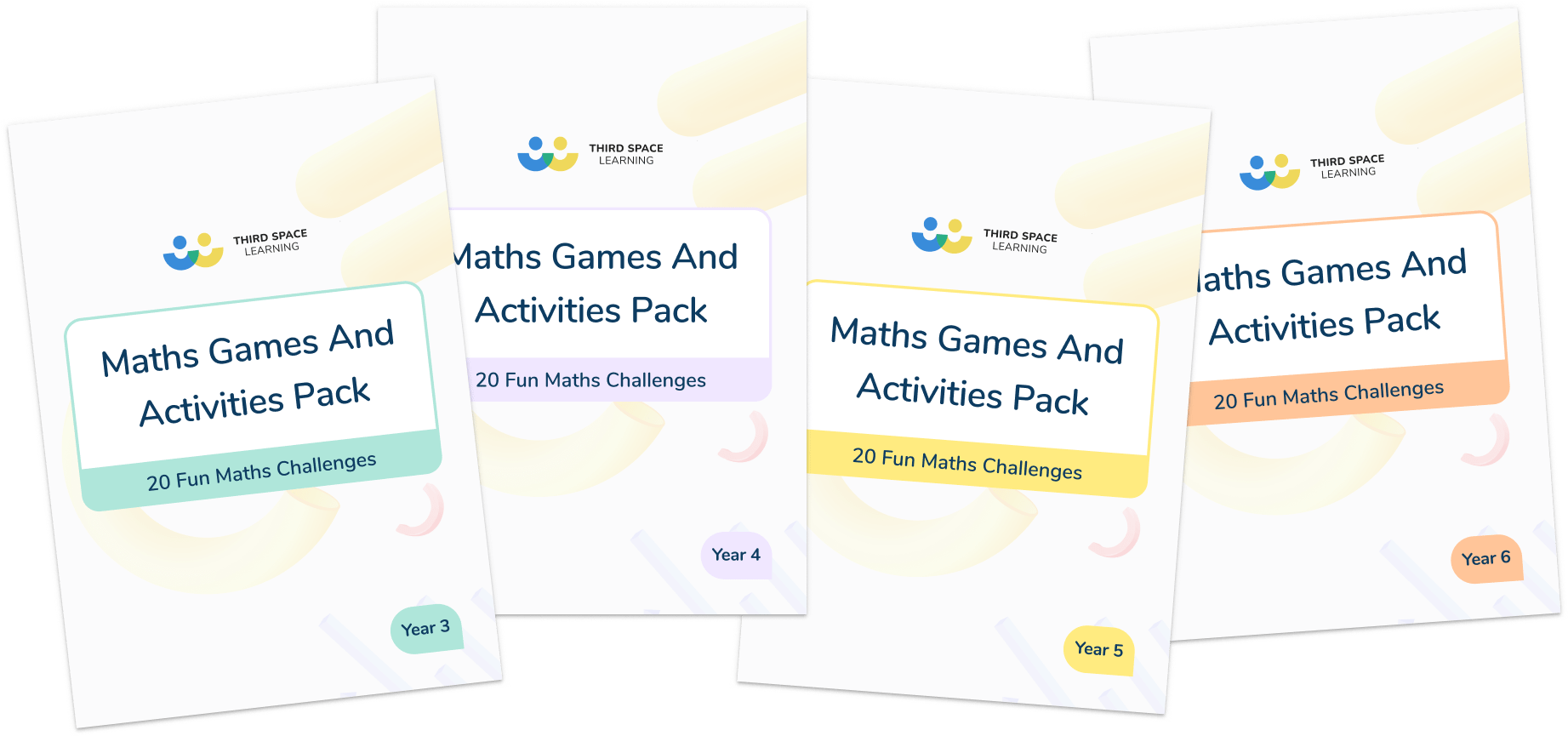 KS2 Maths Games and Activities Pack A FREE downloadable games and activity pack, including 20 home learning maths activities for KS2 children. Bring maths into your home in a fun way. 1. Work together Adults often work best in the company of others, and the same can be said of kids, so why not sit with your child while they’re studying and get on with some of your own work or life admin? Whether you’re returning emails, doing your online banking or organising the next primary school PTA fundraiser, creating a shared workspace and modelling focused work is a great way to spend quality time together while they complete their homework. Win-win! Quick win : Whilst your child is tackling their fractions homework, you could sit down with them and take a look through your finances or even test yourself on the work that your child will be doing in their SATs . 2. Use rewards and incentivesRewards and incentives are great when it comes to getting your children to follow your household rules and routines, and homework is no different. Things like stickers or the promise of time on their iPad or games console for slightly older children can all work wonders in getting them to do their homework without a battle. Quick win: For every few questions they answer they could get a minute of screen time! 3. Sort them a snack Let’s face it: A hungry child is an unfocused, unmotivated and unhappy child. Most children come out of school ravenous, so let them nibble on a nutritious after-school snack while they get on with homework; things like popcorn, apple slices, grapes, flapjacks, or crackers and cheese are all great snack options. If you’re feeling a bit more adventurous, Netmums has a list of healthy after-school snack ideas and recipes to try. Quick win: One of the best brain foods for kids is a nice and crispy apple! So when your child is craving something sweet just cut up an apple and let them munch away. 4. Make it visualHelp to eliminate the late night ‘Oh, I forgot to do that’, and create a weekly homework chart so your child can see what they have to do each day and check off each homework ‘To Do’ as it’s been completed. Again, Pinterest has some great free printables to help keep kids organised. Get them involved by letting them colour it, or decorate it with their favourite stickers, and pin it up somewhere at their height, where they will see it easily every day as a reminder. Some exciting new stationery and colourful pens might help too. Quick win: An easy way to make homework fun is to grab a piece of paper and get your child to draw out and decorate a ‘homework chart’ consisting of 5 days. Stick it on the fridge and add a sticker to each day after they’ve done their homework, when they’ve collected 5 stickers they get a treat! 5. Try different learning apps If your child prefers to be online, there are some great online apps around that children will have fun using, yet encourage learning too. Here are our favourite free maths websites for example. Speak to your child’s teacher too and see which apps the children use in school so you can support what they’re doing at home. Quick win: One of our favourite apps that makes homework fun is Times Tables Rockstars! 6. Set up a homework play dateHolding a homework playdate where your child can invite one of their best school buddies over to do homework together can be a great way for them to learn and make sure the work gets done, especially slightly older primary children. Plus, it’s likely that their parents will be delighted! Younger children may need a bit more support and guidance but can still gain a lot from the experience of learning together with a friend – think of this as a mini-educational play date for them – with a special tea afterwards of course! Quick win: Let your child and their friend play for a while, and then get them to work through their homework with the incentive of a yummy ‘tea party’ when they’ve completed all of their homework. 7. Go outside If the weather allows, create a comfortable outside study space and allow your child to do their homework outdoors. The fresh air can help kids with their concentration if they’ve been stuck in a classroom all day, and studies also show that being outside, closer to nature, can increase productivity. The reward of a quick game of Frisbee or a kick-around of a football between tasks will help them stay motivated too. Quick win: Check out this fun outdoor maths activity for some inspiration of ways you can make homework fun. 8. Turn it into a gameWho said home learning had to be boring? If children enjoy what they’re learning, they’re more likely to remember what they’re being taught, so turn their learning into a fun game. Using sweets like Smarties to help with maths and number work can turn the experience from a chore into a treat. If they get the right answer, they get to eat some! Another trick that you can use when your child is learning spellings is to write them in foam or in magnetic letters. It sounds simple, but we can guarantee that it will make homework a lot more fun for your child. These maths games for kids and times tables games are a great place to start. Quick win: If you’re looking for some fun homework ideas then check out this simple multiplication activity you can do at home, it’ll even get in one of your child’s five a day! 9. Let them play teacherMake another fun homework game by creating your own mini-classroom and letting your child step into the role of teacher. Have your child explain a concept to you as a teacher, as you, or their sibling, plays the role of the student. This game works particularly well with subjects that require theory, like Science for example, as it will improve their understanding of the concept and build logic and reasoning skills. Quick win: Make homework fun by getting your child to choose their favourite teddys and toys and setting them up in their own mini classroom. Start off with registration, ‘mummy’ ‘present’, ‘mr teddy’ ‘here’ etc. You’ll soon notice that your child is growing in confidence regardless of the topic as children love playing teacher!  10. Use a timerSome children may have difficulty working for prolonged periods of time without a break, so using a timer can be great for getting them to complete homework without the whining. For example, if your child is given 20 maths problems for homework, you can say “Complete the first 10 questions then we’ll take a 5-minute break, then complete the next 10 questions”. Many children will need a mental break and will work more effectively when given the opportunity to take one. At the end of the task, they get to pick an activity of their choice. If your child gets easily distracted, a timer game can work well to keep them focused on the task in hand. Quick win: Put the timer on your phone so that your child can see the countdown whilst they’re working. 11. Create a special homework spaceA special study space can make homework more fun and help motivate your child to get it done! Choose a space in your house that’s least likely to distract your child, and create a simple, organised, and kid-friendly homework HQ. You could hang up some of their artwork above the desk, and have all their school essentials nearby so everything is close to hand. Quick win: Make sure that they aren’t surrounded by things that will distract them. Televisions and iPads are a no go at homework time! 12. Remember to be positiveRemember to always be upbeat and positive about school and the importance of their homework. Give your child lots of praise and encouragement about how well they’re doing to help them stay motivated and on track. Quick win: After every homework session spend five minutes talking through what your child has accomplished. If you’re running out of activities to do, have a look at our list of home learning packs – all free to download. 13. Get help if you need itHomework can be frustrating if your child doesn’t understand the material or gets bored easily. If your child is struggling, get them some expert help! 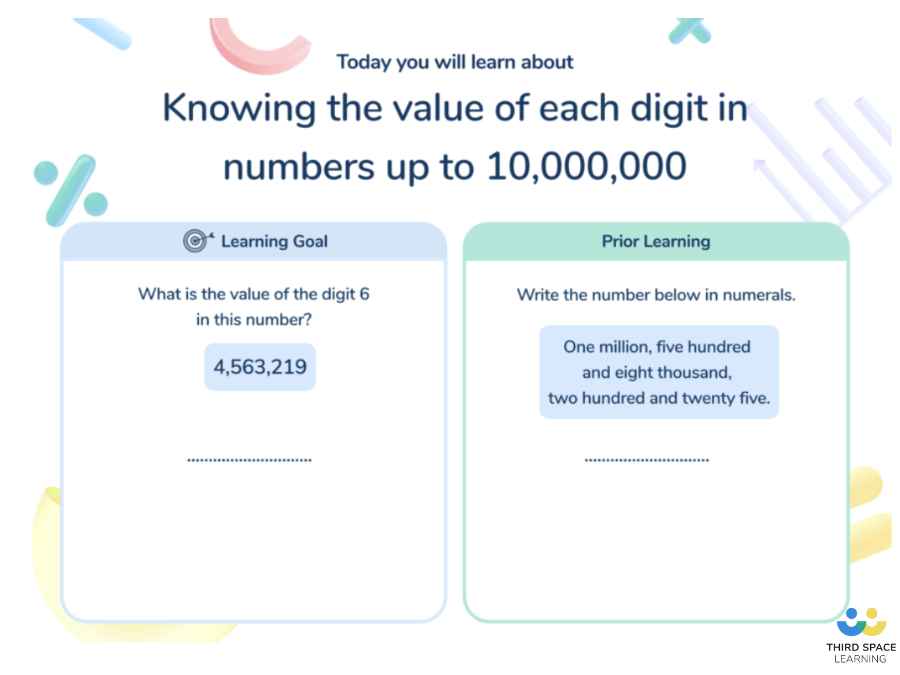 Quick win: Third Space Learning has plenty of advice on learning maths for kids and parents but if you need more support, our primary school maths tutors are easy to organise and very affordable. DO YOU HAVE STUDENTS WHO NEED MORE SUPPORT IN MATHS?Every week Third Space Learning’s maths specialist tutors support thousands of students across hundreds of schools with weekly one to one tuition designed to plug gaps and boost progress. Since 2013 these personalised one to one lessons have helped over 150,000 primary and secondary students become more confident, able mathematicians. Learn how pupils make accelerated progress or request a personalised quote for your school to speak to us about your school’s needs and how we can help. Related articles Home Learning Ideas, Activities and Guides For Primary and Secondary School Teachers  Free Home Learning Packs For Primary Maths KS1 & KS2  Back To School Tips For Parents: 10 Ways To Help Your Child Get Ready And Excited For Primary School!  How To Prevent The Summer Slide: 10 Ways Parents Can Ensure Their Child Is Prepared For The New School Year FREE Ultimate Maths Vocabulary List [KS1 & KS2]An A-Z of key maths concepts to help you and your pupils get started creating your own dictionary of terms. Use as a prompt to get pupils started with new concepts, or hand it out in full and encourage use throughout the year. Privacy OverviewQuick Ideas for Library Card Sign-up MonthSince 1987, Library Card Sign-up Month has highlighted the importance of having a library card. September is the time to celebrate the all-mighty card that unlocks worlds of possibilities. Whether patrons are looking for a beach read, searching for valuable information, homework help, crafts or job search assistance — all can be accessed with a handy library card. This year's Library Card Sign-up Month campaign has teamed up with Skybound Entertainment and leading toy and game company Hasbro to encourage people to roll out to their libraries with the TRANSFORMERS franchise and special ambassador Optimus Prime highlighting that there's more than meets the eye at the library. Use Library Card Sign-up Month as a way to highlight all that your library has to offer in programming, partnerships and more. How do you celebrate this month at your library? Read on for some ideas shared by fellow library workers.  Library checkout scavenger hunt Create a scavenger hunt (for kids and adults!) with tasks to get them to use their library cards to discover new reads. Some example tasks could be: check out a book published in your birth year, a book with your favorite animal on the cover or a book written by someone with your first name. Special prizes for new (and old!) library cardholders To entice new library cardholders to return to the library regularly, enter them into a prize drawing every time they return to the library throughout September. On the last day of the month, choose a winner (or a few)! You can also offer kids a treat every time they show their library card on a visit. Passive library card crafting Leave out blank paper templates of library cards along with coloring materials for patrons to design their own unique cards. Pin completed card on a bulletin board to display throughout the month. To make it more engaging, you can encourage people to write their favorite things about the library on the card and highlight them on social media. Transformers-themed book display Gather up whatever Transformers books are in your library for an on-theme display of this year's ambassador. Decorate using the free mini posters available on the Library Card Sign-up Month website. To make it interactive, leave out Transformers-themed crafts like these headbands or some origami paper with basic folding instructions. Social media fun Create social media posts for every day of the month to highlight all your library has to offer. Include some quotes and photos from library staff and patrons so they can share their favorite things about having a library card. Patron video testimonials can also be a great way to engage your social media following. Visit local schools September perfectly aligns with the start of the school year. Arrange classroom visits at local schools to present all the benefits of having a library card. If you have a mobile way to sign people up for a card, this is a great way to get kids signed up on the spot. Work with your partnerships Have a great relationship with local businesses and organizations? Leverage those partnerships to get new library card holders. Ask partners to distribute information on the library with library card sign-up information. Local businesses can also offer discounts when customers show their library cards. 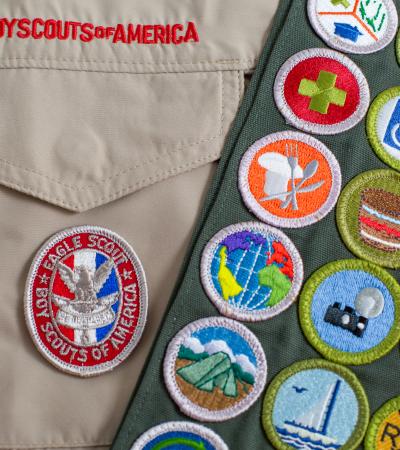 Library Programs to Help Scout Troops Earn Badges Tips for Joyous Library Programming Partnering for Stronger Programming
 Read the book that inspired the movieCustomers also watched.  Cast and Crew 701 global ratings How are ratings calculated? Toggle Expand Toggle Expand
RecommendedKamala harris and dems vilify project 2025 — but trump should embrace its winning ideas | reporter replay.  Steph Curry’s wife appears to tear up in tense Paris police dispute Man vs. croc! Swimmer breaks free after crocodile chomps his leg 14 passengers forced to deplane because it was ‘too heavy’ to fly Trump ally Nigel Farage gets milkshake shower in UK New Parkinson’s drug shows ‘life-changing’ transformation I love all of my 175 rescue animals — even the two hairless rats Bird lands on head of White House reporter moments before live broadcast ‘Star Wars’-obsessed dad takes daughter to prom as stormtrooper Rescued hostage Noa Argamani recalls harrowing captivity under Hamas | Reporter Replay Watch the moment a tornado forms before flipping a pick-up truck
Black Myth: Wukong review – an excellent, approachable Soulslike with fresh ideasKirk mckeand | 13 hours ago.  Black Myth: Wukong is a playable kung fu movie. Inspired by the Chinese novel Journey to the West, you play as a mute reincarnation of the Monkey King as he searches across the land for various MacGuffins, using your staff and magical powers to battle creatures from Chinese mythology – crouching tigers, hidden dragons, and plenty more. It plays like a fast-paced Soulslike – checkpoints you manually activate, NPCs with vague quests, respawning enemies, and tough bosses – but it’s more forgiving. When you die, you respawn at the last checkpoint you activated, but you keep all your experience points, allowing you to grow your strength even through failure. It can even be paused… imagine that. Of course, there aren’t any multiplayer invasions here so pausing makes more sense. I found it refreshing to advance even when I wasn’t making direct progress, and every stat increase, move unlock, and crafted weapon feels like a significant buff – you never change “class” or playstyle, you just get stronger in one direction. I found most of the bosses (there are loads of them, with plenty of variety) fairly easy. When I did hit a wall, though, I just found myself re-exploring the biome I was in, grabbing a few more level-ups, finding a few secrets, and heading back to the boss arena much stronger than before – sometimes with a new magical power that can change the tide of battle. Like the Souls games, combat is simple. You’ve got light attacks, which you can string together for a combo, and a heavy attack, which can interrupt a combo or hit hard on its own. But you also build up energy when attacking to make the heavy attack a guaranteed stagger move – learning when to deploy this (the wind-up can be long depending on how much it’s charged) is key to winning tougher fights. Mixing this up, there are also different stances with their nuances and varied heavy attacks, such as one that pokes from a distance and another that allows you to perch on top of your staff, away from danger, before slamming down.  Despite the lack of a traditional parry, there’s an almost Sekiro-like rhythm to combat. There is an ability called Rock Solid, where you can turn to stone to parry an attack – like in Mortal Shell – but most of the time you’ll focus on dodging and weaving. Dodge at any time and you’ll roll away. Dodge at the last second with perfect timing and you’ll slip an attack, get a few invincibility frames, and leave a mirage of your body behind to confuse the enemy. It feels incredible when you get into the flow of it – especially once you’ve unlocked an ability that stops a dodge interrupting your combos. Every fight feels like a dance where you hit, dodge, hit, hit, and dodge, pirouetting through the enemy’s attacks before spinning your staff and connecting with some demigod’s jaw. Enemy variety keeps things fresh throughout, forcing you to adapt to new threats, and there are a few mechanical twists I enjoyed. Particularly fighting a bipedal tiger in a pool of blood, and battling a giant warthog in deep, wet mud – in the latter, you roll slowly because of the mud, so you’re forced to time those dodges perfectly to initiate the slip and avoid those massive tusks. It looks incredible, too (so good that players thought Black Myth: Wukong was a scam when it was revealed). During that tiger fight, the enemy’s fur reacts and sways with every movement, its belly wobbles as it swings at you, and the blood ripples and splashes. Environments are gorgeous and there’s a beautiful vista around most corners. My only complaint here is that it’s a bit uninspired. You’ve got the forest, the desert, the snowy mountains, a dark cave, and an ashen mountain with molten lava pools. It’s a bit archaic and ultimately makes the environs forgettable despite how high fidelity and painstakingly crafted the art is.  Level design is another weak point. While levels do open up and there are alternate routes and secrets to find, none of it will make you gasp. It’s all a bit disjointed and attempts to make the areas feel interconnected are often pointless shortcuts that don’t need to exist because of checkpoint placement. It’s also arbitrary where you can and can’t explore, with invisible walls boxing you into each region. In some areas, you can hop up and discover another path, while others will just look like they’re climbable but lead nowhere. Still, these imperfections don’t detract too much from an otherwise stellar experience. Black Myth: Wukong is one of the best non-FromSoftware games in this genre, joining the likes of Lies of P in the pantheon of excellent Soulslikes. Instead of copying Dark Souls’ homework, it carries you through this journey with plenty of ideas and charm of its own. Score: 8/10Version tested: PC. Check out our article on Black Myth: Wukong's release time and pre-load information to see when you can get stuck in.  KIRK MCKEAND Kirk McKeand is the Content Director for GLHF. A games media writer and editor from Lincoln, UK, he won a Games Media Award in 2014 in the Rising Star category. He has also been nominated for two Features Writer awards. He was also recognized in MCV's 30 Under 30 list in 2014. His favorite games are The Witcher 3, The Last of Us Part 2, Dishonored 2, Deus Ex, Bloodborne, Suikoden 2, and Final Fantasy 7. You can buy Kirk McKeand's book, The History of the Stealth Game, in most bookstores in the US and UK. With a foreword written by Arkane's Harvey Smith, The History of the Stealth Game dives deep into the shadows of game development, uncovering the surprising stories behind some of the industry's most formative video games. He has written for IGN, Playboy, Vice, Eurogamer, Edge, Official PlayStation Magazine, Games Master, Official Xbox Magazine, USA Today's ForTheWin, Digital Spy, The Telegraph, International Business Times, and more. Kirk was previously the Editor-in-Chief at TheGamer and Deputy Editor at VG247. These days he works as the Content Director for GLHF, a content agency specializing in video games coverage, serving media partners across the globe. You can check out Kirk McKeand's MuckRack profile for more. Email: [email protected] Follow @MckKirk  |
IMAGES
COMMENTS
Students can make video projects of themselves learning or mastering a particular song, key phrases and more. For example, check out this violinist's progress video. 5. Create an ad or a promotional video for school events. Get students to make an advertisement or a pitch for a school event.
9. Questions for your future self. Think ahead with a video full of inspiring questions. This project is great for incoming freshmen. At the beginning of the year, have students create videos with questions for their future self or with goals for their life and career. At graduation, send the videos back to them.
Create a board game. Complete a quiz - you could also ask students to write the quiz in groups and then swap and complete for homework. Write a lesson plan for teaching the topic to a younger class. Teach the teacher - create a poster, Complete a series of exercises. Complete a family tree, real or imaginary.
25 Creative Video Project Ideas Your Students Will Love. Tell a story, make a newscast, create a vlog, and more! By Jill Staake, B.S., Secondary ELA Education. Aug 1, 2022. It's never been easier for students to create fun and engaging videos to show off their knowledge! We've rounded up 25 video project ideas for your students to try.
2. Make a board game. This is definitely one of the most creative homework assignments. Let your students come up with an idea for a board game about the lesson content. They have to make cards, and pawns, draw, write, cut, and paste. They have to use their imagination and inventive ideas to create a coherent board game. Click to open.
10 video project ideas for specific subject areas. 1. Recreate a historic speech or moment in history for a social studies class. 2. Display the work and results of a science lab project from beginning to end, from hypothesis to conclusion. Add images of lab data in the project to show specifics of the results. 3.
Here are her step-by-step instructions on how you can do it too: 1. Go to TED-Ed and create a lesson . This will be your next homework assignment. You can either create a lesson using any engaging video of your choice, or simply customize an existing TED-Ed Original or TED-Ed Select lesson. If you need help creating a lesson, read this.
Ask each member of the group to take responsibility for a different element of the video. This is an effective task at showing students the power of persuasive writing, and how to work effectively in a team, as well as the objective behind advertising. 3. Task: Create a video tour of the school for new students.
Here's some creative homework ideas for your students. Setting appropriate homework tasks is a big part of your teaching role. Here's some creative homework ideas for your students. 12345 6790. Request A Call View all jobs. ... Film a video. If your students are older and have mobile phones, you could set a video-making task for them to do at ...
For her TED-Ed Innovation Project, US History teacher Jennifer Hesseltine created a digital homework space that students love. Here are her step-by-step instructions on how you can do it too: 1. Go to TED-Ed and create a lesson . This will be your next homework assignment. You can either create a lesson using any engaging video of your choice ...
Share Practice Records. Learning a language, cooking, playing an instrument, or doing sports requires constant practice. If you're looking for a way to encourage kids to learn new skills, this project video could be ideal. You can ask them to record themselves learning to play an instrument or speaking a new language.
Ideas to Make Homework Fun for Elementary, Middle and High Schoolers. ... a funny video, an epic solo dance party or a little social media time. Upgrade your workspace. Spruce up the place you do virtual learning and homework to fuel your productivity, imagination and problem-solving skills. Keep tools and supplies on hand to help you work ...
The brain loves to do tasks in contexts with which it is familiar. 7. Allow students to collaborate in determining how homework will be assessed. If they help design the criteria for success, such as when they create the rubric for an assignment, they "own" the assignment.
Creative homework assignments can be fun and, at the same time, teach and enhance subjects introduced in the classroom. For more creative homework ideas, be sure to check out our lesson plans and YouTube videos! Learn some ways that you can make homework assignments both more exciting and more effective with our Creative Homework Ideas!
Break Tasks Down: Divide homework into smaller, manageable chunks. Reward Yourself: Treat yourself after completing tasks or goals. Study with Friends: Make it social by studying with buddies. Use Apps: Try fun and educational apps for learning. Listen to Music: Create a motivating study playlist. Make It Visual: Use colors and visuals to make ...
Here's an example of how you can use them for homework. Say you're working on revising perimeter with your students. Instead of giving them a quiz worksheet, break the questions up into task cards. Create a game out of the cards and ask them to complete a recording sheet as they work through the cards. Hey, presto!
Televisions and iPads are a no go at homework time! 12. Remember to be positive. Remember to always be upbeat and positive about school and the importance of their homework. Give your child lots of praise and encouragement about how well they're doing to help them stay motivated and on track.
1. Less is More. A 2017 study analyzed the homework assignments of more than 20,000 middle and high school students and found that teachers are often a bad judge of how long homework will take. According to researchers, students spend as much as 85 minutes or as little as 30 minutes on homework that teachers imagined would take students one ...
Educational YouTube Video Ideas 71. Homework Help Videos. For the student viewership, consider creating homework help videos. These can cover a range of subjects, like mathematics, literature, or foreign languages. Providing step-by-step solutions to common problems or explaining the themes of classic literary works will not only benefit ...
Working on homework teaches children that work is a part of life, not just school, and fosters friendship without being overpowering. 5. Design an Awesome Workspace. Improve the area where your kids complete their schoolwork to increase efficiency, creativity, and problem-solving abilities.
Today I show you how to quickly complete homework. When it comes to completing homework it's extremely important that you get it done on time, but most impor...
Homework Assignments That Work. 1. A Word Book. A Word Book or Vocabulary Journal is a classic among teachers of very young learners who are not adept at using dictionaries; here they have a chance to make their own. Help them design their very own Word Book from scratch, out of construction paper, cardboard, or any materials you have on hand.
Throughout the remainder of this writing, I will offer ideas for doing homework. I am writing it specifically for students; therefore, it is imperative that parents share this important ...
Marla Cichowski, with the Illinois Office of Tourism, joined WGN's Evening News at 4 p.m. to discuss a few ideas for a fun road trip with the family before the kids head back to school and the ...
The Alien franchise has had a round robin of amazing creatives over its storied 45-year history, so there should be little surprise that a few brilliant ideas fell through the cracks, such as ...
Set up a homework play date. Go outside. Turn it into a game. Let them play teacher. Use a timer. Create a special homework space. Remember to be positive. Get help if you need i t. Thankfully, there are ways of making homework less boring and that little bit more fun for your child.
Since 1987, Library Card Sign-up Month has highlighted the importance of having a library card. September is the time to celebrate the all-mighty card that unlocks worlds of possibilities. Whether patrons are looking for a beach read, searching for valuable information, homework help, crafts or job search assistance — all can be accessed with a handy library card.
Based on the acclaimed, contemporary love story of the same name, The Idea of You centers on Solène (Anne Hathaway), a 40-year-old single mom who begins an unexpected romance with 24-year-old Hayes Campbell (Nicholas Galitzine), the lead singer of August Moon, the hottest boy band on the planet.
Kamala Harris went to Las Vegas over the weekend and flagrantly stole one of Donald Trump's signature policies: No tax on tips. Trump, who got the idea for the populist policy from a…
Black Myth: Wukong is one of the best non-FromSoftware games in this genre, joining the likes of Lies of P in the pantheon of excellent Soulslikes. Instead of copying Dark Souls' homework, it carries you through this journey with plenty of ideas and charm of its own. Score: 8/10. Version tested: PC.